Join my monthly email! Sign up
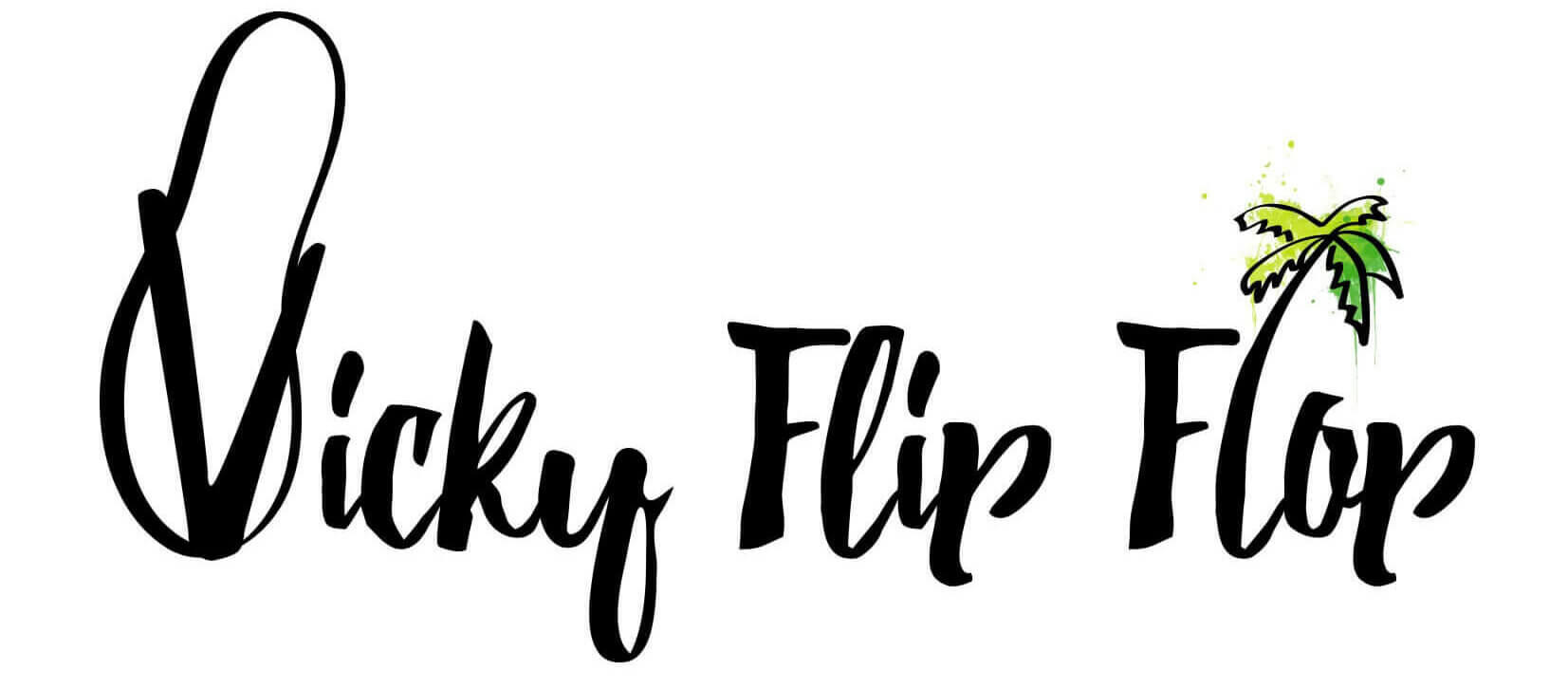

What’s the Average Travel Blogger Salary? (+ Income Reports)
How much do travel bloggers make? Let’s take a look shall we? I’ve used my experience and insider intel to work out the average travel blogger salary across the board…

I’m being nosy and have some rare time on my hands so I thought I’d try and work out the average travel blogger salary, just for… research .
To be a paid blogger is now one of the most popular career goals for kids (and adults) in these crazy online times, but how much can you actually even earn as a travel blogger, really ?
How much does a travel blogger make?

– Be nice to have a strong enough travel blogger salary to get up to the mountains every year, hey?
It’s hard to guess by appearances – if you take Instagram accounts and blog posts as gospel. Sure, holidays, new clothes, cocktails and fancy dinners would usually mean a person was raking it in, but y’know travel bloggers get a lot of this stuff in return for coverage on their blog.
Many holidays are sponsored, clothes are gifted (or ‘borrowed’) and some travel bloggers don’t actually have homes to keep up while they go off gallivanting around the world.
I’m talking like I’m not one of these travel bloggers, like I’m writing a study of them, but actually, I’m one too. Have been for over nine years now.
Wanna know how much I earn?
In a minute. Let me guess at the other travel blogger salaries first.
Typical Travel Blogger Jobs
Aka, how does a travel blogger make money?

– I love nosing on travel blogger income reports!
The travel bloggers who make the most have many income streams , I can say that for certain. You can’t just write a travel blog about your thoughts and feelings in a destination and expect the cash to magically come rolling in.
You need to use every ounce of entrepreneurialism you have, every skill, and every bit of knowledge to make travel blogging make money for you. Here are some of the typical ways travel bloggers make money so they can travel the world and get paid for it.
This is how travel bloggers get their income.
- – Translation
- – Affiliate income
- – Running tours
- – Selling products
- – Running courses
- – Writing courses
- – Presenting
- – Social media management
- – Freelance writing
- – Writing books
- – Marketing
Some of the best travel blogger income reports
One of the best ways to work out how much travel bloggers are earning, is to look at the open and honest income reports around the web. I love how people put this stuff online…
- It’s a Lovely Life March 2018 Income Report – $208,558.17
- Heleneinbetween October 2017 Income Report – $12,026.78
- Living the Dream April 2018 Income Report – $3,984
- WhereverWriter February 2018 Income Report – $3,575.05
- So between $3500 and $209k per month? Niiiice?!

Just to note though, a lot of travel bloggers have an invested interest in leading you to believe they earn more than they actually do. Whether that’s because they’re selling a travel blogging course, a lifestyle, a product or something else.
So just bear that in mind – definitely not saying the travel bloggers responsible for the income reports above do – just, y’know, some people .
Not all travel bloggers earn even close to that much though.
Let’s look at some of the top travel blogger salaries.
Top earning travel bloggers
Like many industries, in travel blogging there are a few people at the top earning a small fortune, while there are many at the bottom earning just a few dollars a month.
If you’re a travel blogger with a successful course, with affiliates promoting it, a long standing blog, get to work with brands and have over 100k page views a month – the money could be rolling in.
If you want to know which travel bloggers are earning the most money, check out my friend Kach’s guide over at Two Monkeys Travel.
They’ve compiled a list of the top earning travel bloggers as revealed by the travel bloggers themselves. They’ve listed the top travel bloggers’ income for all to see.
READ MORE: 30+ TRAVEL BLOGGERS EARNING OVER 5,000 USD / MONTH & HOW THEY MONETIZE THEIR BLOGS
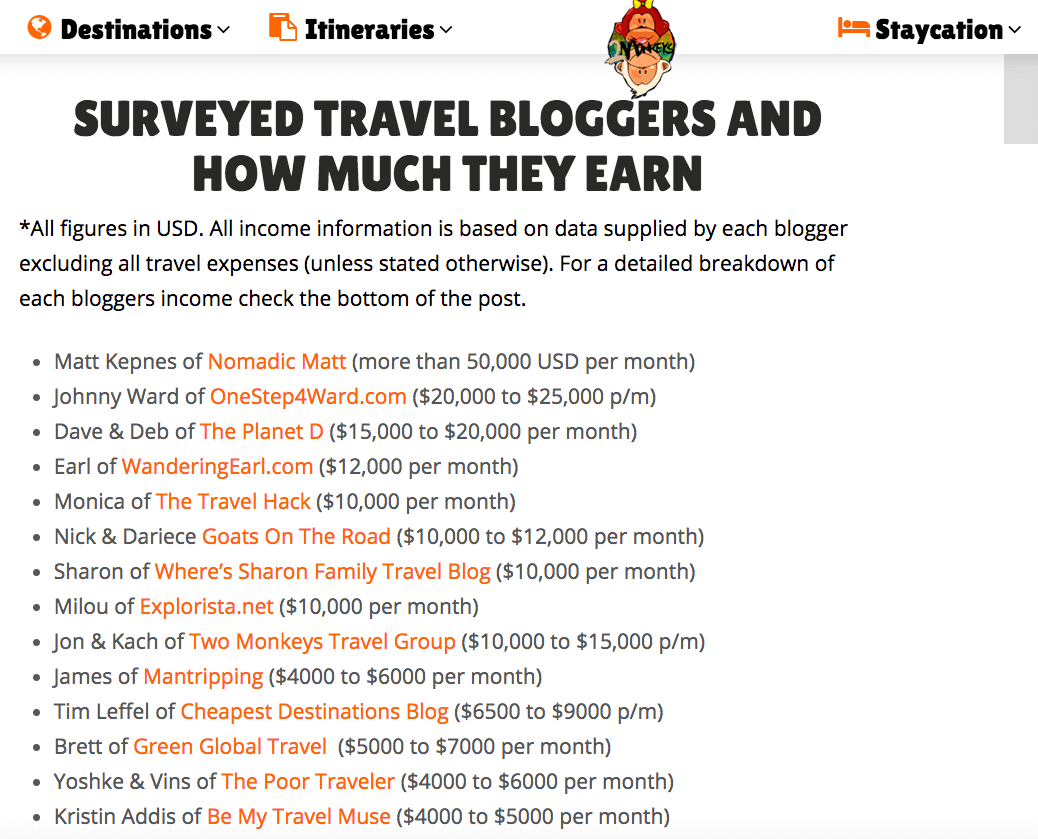
– The travel blogger income of some of the top travel bloggers in the world
I think the only British person on that list is Monica from The Travel Hack, apart from the Monkeys, so well done her . She definitely should’ve bought the beers in Finland last month !
These are the kind of travel blogger salary figures you want to emulate hey?
Best travel bloggers earning money
If you want to read more about the top earning travel bloggers, all earning over six figures a year, you can read some of their secrets below. I scoured some of the top travel blogs for evidence of their finances.
Let’s look at the travel bloggers income reports.
– Caz & Craig make over 6 figures a year over at the super popular family travel blog yTravelBlog.com. – Goats on the Road make over $100,000 / year. – Johnny Ward is a travel blogger millionaire and earns $30,000 A MONTH . – Nomadic Matt makes over $750,000 PER YEAR .
* Just to note, the bloggers have above have entire teams behind them, so they have a lot of spends too. Here’s Matt’s Team for example.
My guesses at travel blogger salaries
So, how much does a travel blogger make per year?
First rule of getting a salary in England is that we don’t discuss the salary. I know what a few of my friends earn, the journalist ones-ish, but even some of my besties I wouldn’t have a clue.
None of my business apparently.
– How much money can you make as a blogger?
These travel blogger salary guesstimates are based on my own experiences, an insider knowledge of the industry and from what I’ve heard.
1. Started travel blogging in the last three years, a few sources of income and some outside brand presence, at least 100 blog posts = £20,000 2. Travel blogging for a few years, focuses on blog for at least 5 sources of income, works with brands, does it full time = £40,000 3. Travel blogging for a few years, focuses on blog for at least 5 sources of income, plus some sort of successful course or product, does it full time and won’t do anything for free or in return = £60,000 4. Travel blogging since the start, super successful Instagram and / or YouTube presence, numerous sources of income, well known = £90,000 5. Travel blogging since the start, super successful Instagram and / or YouTube presence, numerous sources of income, well known, and American = £100,000+
Practical Wanderlust made $22,000 travel blogging in her first full year , although just $65.07 in her first six months.
Travel blogger income
The ‘average blogger salary’ is kind of a ridiculous and unmeasurable calculation.. It’d be like saying ‘what does the average singer earn’?

In blogging you have the likes of Zoella reeling in the millions, and then the millions of bloggers worldwide not making a penny. The spectrum of salary has very different ends.
As for me, with my delightful travel blog? In and around number 2, give or take 10%. I’m British, I can’t talk about my travel blogger salary – my fingertips literally won’t type to reveal the exact amount!
Earning potential of travel bloggers
Travel blogging isn’t like beauty blogging, food blogging or fitness blogging – for most people travel isn’t something they do daily. It’s something they may spend a year or two on, and then it’s back to the once to three times a year when families, jobs and finances get in the way.
This means that travel bloggers sell less through their blogs, but when they do, the value will be higher. They’re more of an information source than other types of bloggers, making it difficult to predict what they earn.

Many travel bloggers work on an affiliate basis, where they will get some sort of kickback if they manage to sell a product through their site, but travel bloggers are inspiration. Even if we do inspire or persuade someone to travel in our footsteps, it might be a year or two until they actually do it. And by then any reference to the fact that it was you who inspired them to go will be erased or forgotten.
Travel bloggers also have to invest a lot to start off, in our travels , before we start making any back. All things to consider if you’re looking at the finances of becoming a travel blogger as a career choice. A travel blogger salary is one thing, but travel blogger expenses are a whole other kettle of fish!
On the flipside though, the earning potential of a travel blogger is totally uncapped .
This excites me greatly.
How much do travel bloggers make?
The harder you work, the more creative you are, the more you think about it, the more you do – the more you can earn.
Typical travel blogger rates
This is difficult to talk about without naming exact campaigns, bloggers, their audience sizes, and prices – but just to give you an idea…

– Travel blogger earnings totally vary from blogger to blogger
– A friend of mine with around 20k Instagram followers recently went to the launch of a new travel themed food item and was paid £800 to attend and to create an Instagram post on it. – I’ve worked with different tourist boards for (on average) a week to create social media content, a video and multiple blog posts and been paid between £1000-£2000 a time. – It’s normal for a travel blogger with an audience size of around 50,000 U/Vs to be paid £500 to do a product review on their blog and receive the product for free. – Travel bloggers can be paid upwards of £200 to takeover a company’s Instagram Stories for the day. – Many bloggers I know wouldn’t even consider going to a destination for a week unless they were paid at least £1000 in return for the content they produce.
But, also, they’re asked, expected and have done, loads of stuff for free.
EVERY. SINGLE. DAY.
One of the most annoying aspects of trying to earn money as a travel blogger, is that you will constantly and repeatedly be asked to work for free. It really is infuriating.

– Most travel bloggers will plough their earnings back into their travels
7 steps to earning a good travel blogger salary
Many bloggers earning good money from their travel blogs are in that lucky position because they started early, obviously . Their blogs and sites have gained traction from years of hard work and attention online. They deserve their place on the top earning travel bloggers score board. When it comes to the question of how much do travel bloggers make, they’re making the top dollar.
Don’t let their rich history put you off though, there are still ways to make money as a travel blogger if you start your blog now…
1. Invest your time
You’ll need to be willing to invest your time , for no financial return. For at least two years I ran my blog as a labour of love and to practice what I was learning at work.
2. Do a highly regarded course
Get ahead and learn as much as possible. It might seem silly to pay when you can get the information online for free, but at least this way it’ll be set out in an easy to follow way, and you can just do the steps.
3. Stand out
There are so many travel bloggers now that it’s no longer enough to just be ‘a travel blogger’, you need to have a niche and some sort of direction. Think of a way to stand out from the crowd to make you the go to person for that topic.
4. Skill up
Be reeeeally good at one thing – photography, writing, Facebook, videomaking etc – and then keep working on everything else. Back up there ^ somewhere, I said how the highest earning travel bloggers have multiple income streams – remember that.
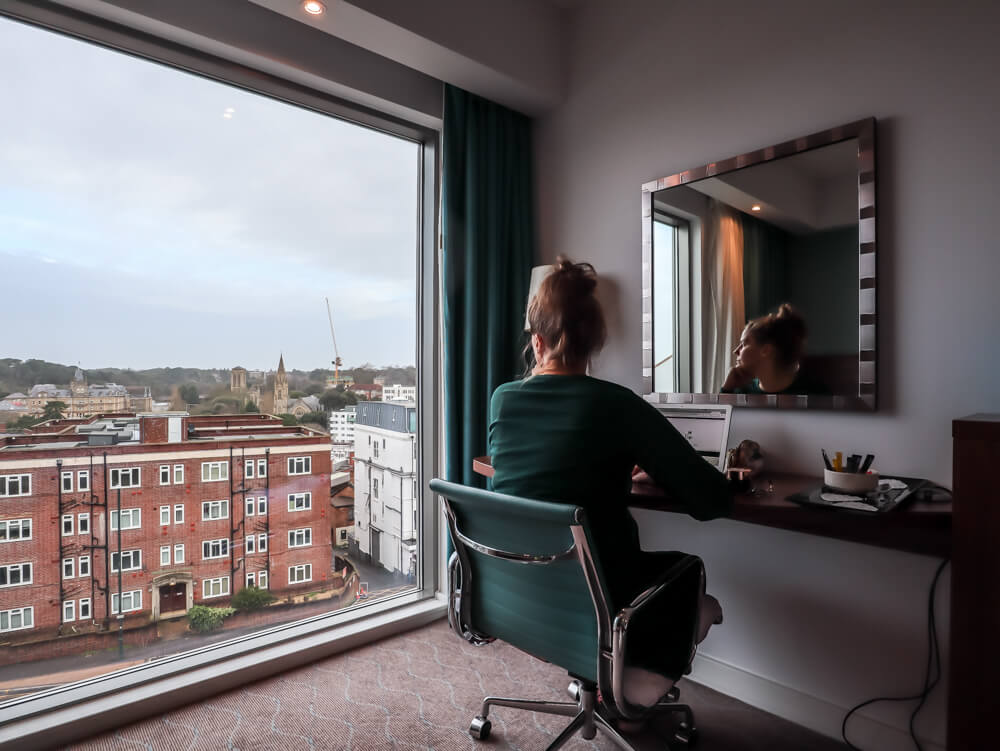
You need to be always learning, always thinking and always executing.
5. Do cool stuff
The world does not need another guide to Barcelona , trust me. Have some sort of gimmick, or do cool things, or go to awesome places and do cool things in those places, that no one else does, to really try and stand out.
Do something to write home about.

6. Have a business mind
Many travel bloggers are creative, but to make money they need to be business minded too. If you’re serious about making a lot of money from travel blogging then every decision you make needs to be business minded, even if the decision you make for your business isn’t to be business minded to look like some carefree traveller.
Read books, read well written sites, and learn about the professional side of travel blogging to give yourself the best chance.
7. Celebrate the small wins
Congratulate yourself on the small wins. As a travel blogger every day you are working towards building something bigger. You cannot expect to be the highest earning travel blogger in a few months – Nomadic Matt has been working at it for over 13 years, me, nine.
As you slowly build your empire, remember to congratulate yourself when things go right and keep your eye on the bigger picture.
Is it easy to become a travel blogger?
I 100% believe that with hard work, knowledge and enthusiasm you can come and join us mid-earning travel bloggers , earning a decent salary, working from home and travelling for a career.
Once you’ve got that nailed, then you can start thinking about bringing in those glorious six figures.
How soon will I start earning money from travel blogging?
Anybody else happily accepting that they’re NOT going to make an income from ‘travel blogging’? Regardless of all the inspirational memes you see saying otherwise! ? #traveltribe — Steve Biggs (@biggsytravels) February 17, 2020
I started earning money after about six months – we’re talking a few quid though, not much. It took about three years – could’ve been two but I was reluctant to give up my job – for me to start making a basic full time income of it. My travel blogger salary soon eclipsed what I was earning in my job, and I knew it was time to leave so I could reap the benefits of all the travel I was being offered.
Since then I’ve travelled the world for three years and managed to top up my savings to buy a house by myself through what I’ve earned from my travel blog.

I started my blog in February 2012, back when no one really knew what they were doing and we were just muddling through. Now there are so many courses on how to make money travel blogging, and so much information and many opportunities out there, that with some hard work and a bit of luck you could be earning quicker than I did.
Or, you could set it all up, all gung ho, and then slowly drift away from it once you realise how much hard work it is to maintain. Up to you.
“Most travel blogs will be lucky if they last longer than a year”. – Expert Vagabond
It’s impossible to say how soon you’ll start earning money from travel blogging, it depends how much work you put in, how much you know and how lucky you are. A travel blogger jobs salary is difficult to pinpoint.
Questions about travel blogger income
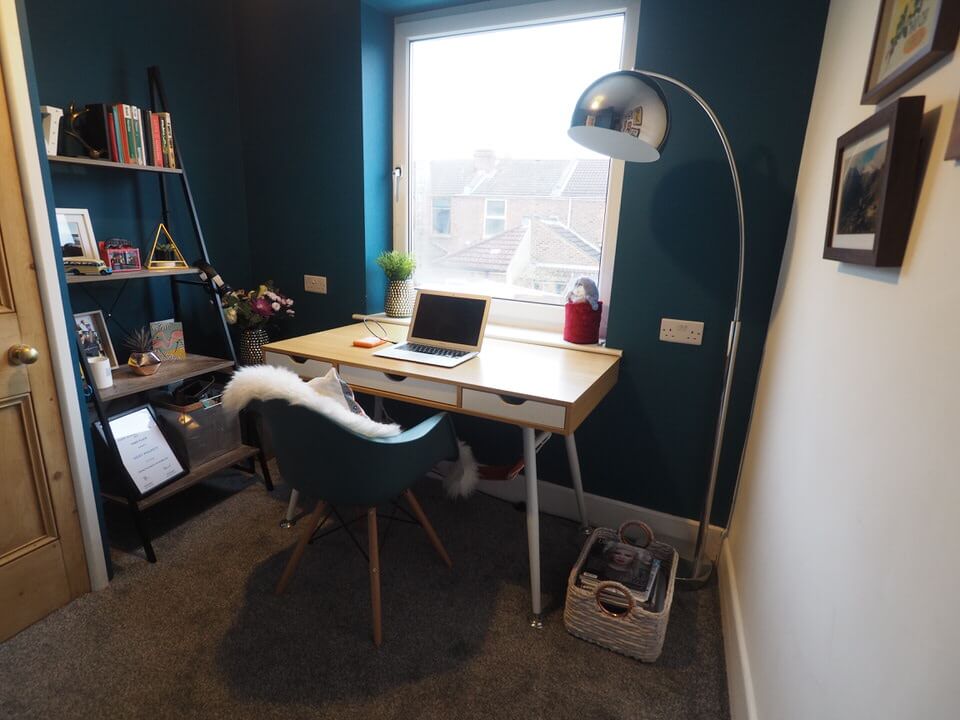
1. What is the salary of a travel blogger?
A travel blogger income varies from a big fat zero, to over a million a year. The highest earning travel bloggers I know are Nomadic Matt, The Blonde Abroad and Two Monkeys Travel. They’re all earning a blummin fortune!
2. How do travel bloggers get paid?
Travel bloggers get paid through affiliates, brand partnerships, freelancing in writing or photography and advertising. They can also charge appearance fees, social media fees, and develop courses and speaking fees too.
3. Can you get paid for travelling?
Yes, as a travel blogger you can get paid to travel. I am living proof.

4. Can anybody be a travel blogger?
No, unfortunately not. No matter what those ads on Facebook tell you. To be a paid travel blogger you need to be resilient, hard working, good at writing and SEO, and have some sort of funds to travel in the first place.
It takes a lot of hard work to be a travel blogger.
5. Can you believe travel blog income reports?
I love reading travel blog income reports, but that’s just because I’m super nosey. Seeing how much travel bloggers get paid is very interesting to me, and can also give ideas of how you yourself can earn more in different markets too. I do tend to take travel blog income reports with a pinch of salt though – years in the travel blogger business has taught me you can’t believe everything you read!
Travel blogger salary
Good luck with it all. I hope one day I’ll be writing about you as one of the highest paid travel bloggers in the world. Let me know if you have any questions, and how you get on!
Pin this post on travel blogger salaries for later
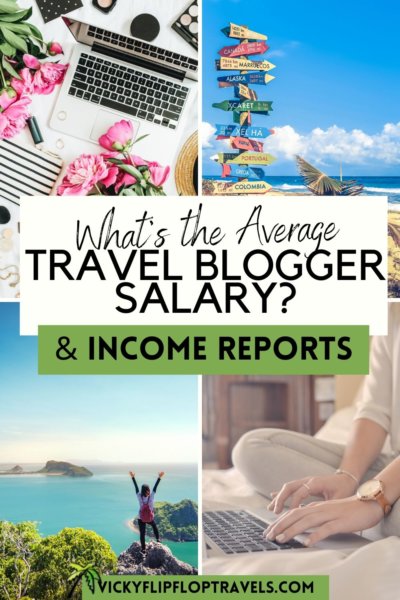
Related Posts:
- How Much Does it Cost to Be a Travel Blogger?
- 10 Years of Travel Blogging + 12 Tips for How to…
- 12 Reasons Why I’ve Succeeded in Making Travel…
- The Joy of ‘Blogging for Exposure’ vs What Magazines…
- Making Money Travel Blogging With Affiliate Marketing
- 6 Ways to Cure Crippling Blogger’s Block in 2024
Hi, I'm Vicky! I wrote this. You can find me on all the social media @VickyFlipFlop. I love a bit of adventure, will try anything once, and have a strong passion for the local food and drink, whatever it may be. I'm here to help inspire you to travel to places a little out of your comfort zone, or at least to explore the usual destinations in a different way. Stay, have a look around, and if you have any questions – let me know below.
18 Comments
very inspiring, I’m finally making some income after blog post number 47 YAY!
Really interesting post. I remember reading about a travel blogger once who claimed to be earning a certain figure, turns out she had like you said 5 different avenues and another blog which was getting more hits! I’d like to think that one day I’d be earning enough to make a living. I’ve just started it full time so the next year will tell.
Oh good luck! I hope you’ve been ok during this difficult time. To be honest, I take everything I read with a pinch of salt as there’s a lot of exaggeration! I think this year is difficult for us all.
Nice to read and gain more knowledge – no blog yet but thinking about it – and the information helps. Really great for all the pointers
Hi VickyFlipFlopTravels, this content is an encouragement to future bloggers. It is very informative. Thanks for this.
No worries. Interesting to see hey?! I’m happy to say my income has gone up since I wrote this post but it’s been a long road!
Hi Vicky, this article is an encouragement to future bloggers. It is very informative. Thanks
Oh I hope it’s helped inspire you! As we know travel blogging isn’t all about the money, but you’ve got to be able to pay for your flights somehow!
- Pingback: Ways to Earn Money Traveling - CleverLeverage.com
Thank you, very informative. Even though you don’t want to share exact numbers, maybe you could share a range of how much earning you’ve reached at Y+1, Y+2, … ?
You’ve done your research and posted huge amount of travel blogger contents. I’m really a fan of your writing these days. Would you mind if i share this article to my students?
Hello Michel, if it’s just IRL then yeah, sure, share away! If you’re sharing online it’d be great to know where exactly you were sharing it to. Thanks!
Sorry I hadn’t replied earlier Steve, don’t know how I missed that. Are you happy with what you’ve earned? I think there are a lot of people earning a little pocket money from their blogs, which is great. Helps with the costs. I guess it’s only if you plan to pursue it as a full time job that you need to start thinking about how to bring in the big bucks, if you’ve got your main job then there’s no need to put so much pressure on yourself to perform. Just enjoy it!
No worries, I’m glad you found it helpful. So interesting to see what people are actually earning from travel blogging isn’t it?
This is so insightful and pretty thought-provoking! It’s mad to think some bloggers are earning such huge amounts from their sites and videos etc. I think like you say, it’s good to remember they will have started small and done a lot for free!I’m starting to get lots of local attractions for free and glamping stay which I find super exciting!
Oh that IS exciting! I think it makes sense that people are earning so much, when they have such big audiences. Some bloggers’ audiences are bigger than magazines. I think as people have moved to getting their information online the blogger were ahead of the curve. It’s all interesting to watch and observe – I guess we’ll see!
This post is packed with some really fascinating insights. Thanks a lot for writing this!
Let’s start with a low bar 🙂 I’ve been travel blogging purely as an enjoyable sideline to my FT salaried digital analytics career job since the start of 2016. Blog earnings to date = £800. Directly £500 for a video I posted on Jukin Media and £75 for a sponsored blog post … & then indirectly £150 discount off a Stockholm hotel rate and a £75 free tour in Paris (both of which I was going to pay full price for anyway). £0 so far from my Amazon affiliate links.
Leave a Reply Cancel reply
Your email address will not be published. Required fields are marked *
Sign me up for the newsletter!
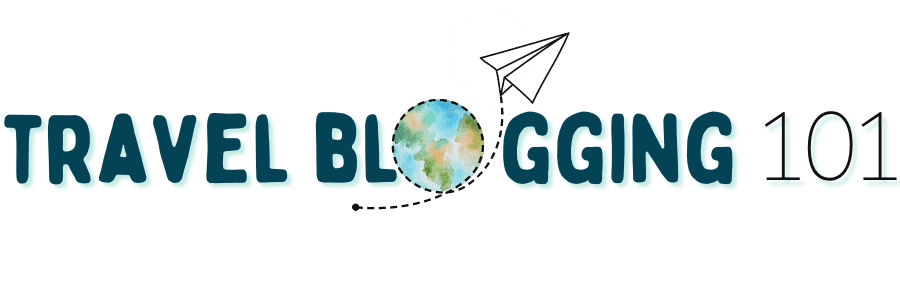
How Travel Bloggers Make Money: 17 Proven Strategies in 2024

WONDERING HOW DOES A TRAVEL BLOGGER MAKE MONEY?
As a profitable travel blogger — I made $272,569 from blogging in 2022 🤯 — this article shines a light on how to make money as a travel blogger.
The most well-known ways of making money online include affiliate marketing, advertisements, and press trips.
👩💻 If you’re serious about making money from a travel blog, I highly recommend taking a course . Head here for info on the best travel blogging courses . If you want to read a full review about the best one I’ve done, head here .
Still, in an increasingly content-driven society, there are more ways to make money through travel blogging popping up every day. So, if you are wondering how to make money from a travel blog , you are in the right place.
Here are 17 of the most common ways to make money travel blogging, but don’t be afraid to think outside the box and get creative within the business of travel blogging.
17 Ways Travel Bloggers Make Money
1. creating quality content — a lot of it.

Quality content is essential for a successful travel blog.
As the saying goes, “content is king 👑,” and travel bloggers understand the importance of this like no other.
If you are wondering how to start travel blog and make money, this is where you should start.
🤔 how to generate page traffic
Travel bloggers who make a lot of money understand search intent, keyword research, and SEO optimization pe to ensure their content reaches the right audience and generates traffic.
Without traffic, there is no monetization. So when it comes to how much money can you make from a travel blog, the more quality content you have, the more potential money you can earn.
To create quality content that will bring in the most revenue, travel bloggers should learn the ins and outs of keyword research, SEO optimization, and email marketing to connect with their niche audience.
How Travel Bloggers Make Money
2. ad networks.
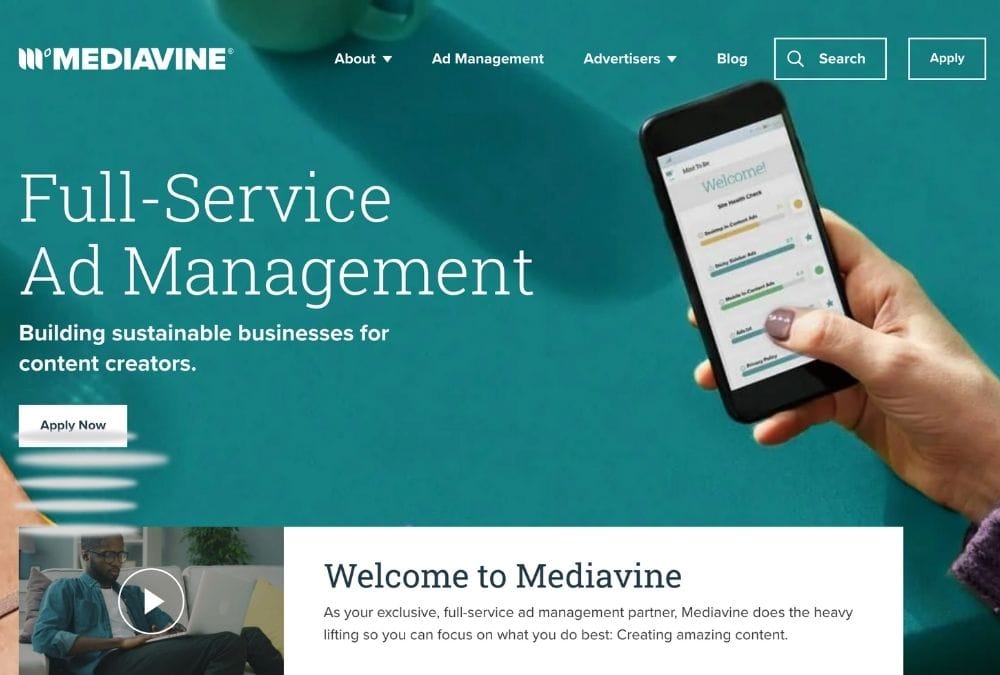
After creating lots of content, how do travel bloggers get paid?
One of the most common ways to make money through travel blogging is by joining an ad network.
Ad networks act as a middleman between the advertiser and the publisher (the travel blogger).
By signing up with an ad network, travel bloggers can easily place ads on their travel blogging websites. How much do travel bloggers get paid depends partially on each pageview.
🏆 popular ad networks
Three of the most well-known Ad Networks are Mediavine, Adthrive, and SheMedia, but these higher-paying ad networks have a minimum traffic requirement to be accepted into the program. For example;
- Adthrive – 100,000 monthly pageviews
- Mediavine – 50,000 monthly sessions
- SheMedia – 20,000 monthly pageviews
If you are a smaller travel blogger, there are other ad networks, Google Adsense and Ezoic , that don’t require a minimum amount of traffic, but you will find the ePMV (pay per 1000 pageviews) is much lower.
Now, it was a lot of hard work, and I invested in travel blogging courses so I could get on these ad networks. (The best course I took was Scale Your Travel Blog to Six Figures — and yes, I have scaled to multiple six figures.)
3. Affiliate Marketing

Affiliate marketing is when a travel blogger promotes another company’s products or services and receives a commission every time someone purchases the product/service through their link.
It’s one of the most lucrative strategies for how to get paid as a travel blogger, and the highest-paid travel bloggers usually credit this as their most profitable income stream.
Many travel companies like DiscoverCars, Booking.com , SafetyWing , Expedia , Get Your Guide , and Viator have excellent affiliate programs.
👩🏻💻 I teach bloggers how to find keywords with big potential to earn affiliate income in my How to Find Affiliate Marketing Keywords Class . You can read more about my class in this Best Courses for Travel Bloggers article.
Once accepted into an affiliate program, bloggers place links in their blog posts leading back to products/services.
These links have cookies 🍪 that follow the user to the company’s website, and the blogger receives a commission if the user purchases something on the website.
These cookies can last anywhere from one session to one year.
For those wondering how to become a successful travel blogger, how to monetize a travel blog, or how to become a travel blogger with no money, affiliate marketing is often the quickest and most lucrative method for how to get paid to travel blog.
🤔 How much do I make with affiliate marketing?
A lot — Using a combination of the companies listed above, my affiliate income in 2022 was $163,706 .
💡 Note: Affiliate marketing is based on trust, so it’s essential only to promote products and services you have personally used or would recommend anyway. Your audience is WAY more likely to purchase the product or service if they trust you.
4. Paid Press Trips

Paid Press trips are another typical result when googling how to earn money from travel blog.
A paid press trip is when a travel company or destination pays a blogger to visit a location and create content around it.
This arrangement usually involves posting on social media multiple times throughout the trip and writing a blog post about the experience upon returning.
🤔 How do TO get press trips for travel bloggers?
Typically, when you go on a press trip, you’ll receive free accommodation, meals, activities, and transportation costs in return for your services. You can also receive monetary compensation on top of that.
These opportunities can be hard to find if you’re a new blogger. They are generally reserved for more famous travel bloggers, as companies prefer to work with bloggers with a large social media following and lots of website page views.
To get started with press trips, connect with tourism boards or local businesses in the area you wish to visit. You should also create a media kit that details your blog’s statistics and potential reach when making a pitch.
So, if you are wondering: how to get free trips as a travel blogger , then press trips are definitely the way to go. But remember, it’s work too, so make sure the exchange is fair
5. Ambassadorship
Ambassadorship programs are when companies give travel bloggers free products or services in exchange for promoting them. This benefit could be anything from a free hotel stay to free travel gear or clothes.
In exchange, bloggers usually need to post about the brand or product on their social media channels and their blog – every agreement is different.
To become a brand ambassador, research companies that fit your niche and contact them directly.
📝 Pro Tip : Create content around a specific brand before contacting the company. This content will show the brand that you are serious and will give them an example of the quality content they would get by working with you.
6. Sponsored Posts
Sponsored posts are articles a travel blogger (or another person/company) writes about a particular product, experience, or service in exchange for payment.
These deals involve either the blogger or a third-party person writing an honest and unbiased review of the item/experience while providing their opinion, usually in favor, and a personal recommendation to readers.
How much do travel blogs make from sponsorships? It depends.
Companies typically pay bloggers per post or negotiate a monthly rate based on website traffic.
To get started with sponsored posts, you’ll want to create a media kit and outreach to brands in your niche. You can also join influencer networks such as TapInfluence (IZEA) to promote your services.
📝 Note: If you do a sponsored blog post, it’s essential for SEO to mark it as a sponsored post on the back end of your website and check that all links are no-follow.
7. Sponsored Links
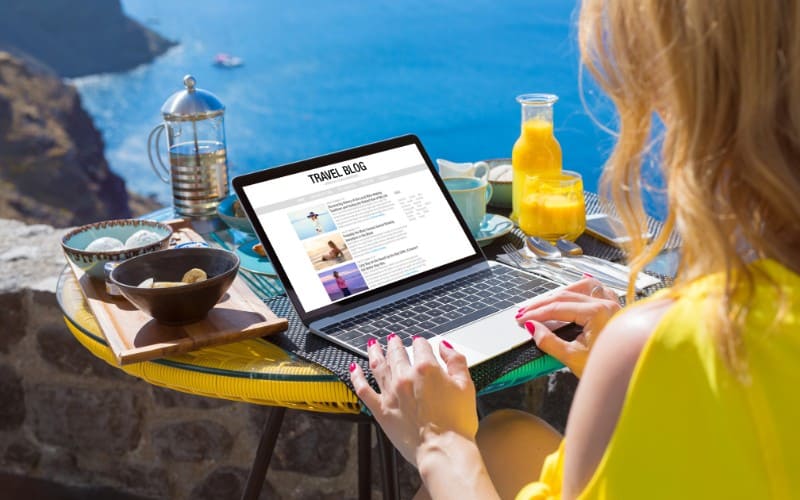
Sponsored links are a type of affiliate marketing , but instead of getting paid for clicks or purchases, you get paid for each link you place on your website.
Initially, this is hard to do, but if you have any popular blogs that make money, these deals are relatively easy to score.
Bloggers can use banner ads and hyperlinks or include the links in their email marketing campaigns.
🤔 how bloggers make money from sponsored links
Generally, brands will reach out to bloggers ranking for keywords for which their company meets the demand.
So, if you are ranking for the keyword “Renting a Car in Miami,” car rental agencies may reach out and ask if they could pay to place a link to their company within your post.
You can also contact those companies directly and ask if they would be interested in promoting their business on your blog post.
Note: Again, for any sponsored links, it is very important that this like is marked No-follow and Sponsored. Make this clear when agreeing to sponsored links.
8. Organizing & Hosting Trips

Organizing and hosting trips for your readers is an excellent way to nail down how to be a travel blogger and make money on your travel blog.
This monetization method involves researching destinations, choosing accommodations, planning activities, and setting up travel itineraries to places you have been and are familiar with.
Some bloggers simply set up itineraries and help people plan their trips, but others will host the holiday themselves.
People love this because they get to travel with an expert who knows all the best tips and tricks for enjoying a destination to its fullest.
✈️ how to organize trips
The best way to find people interested in traveling with you is through your email list. These people already like you, trust you, and have taken action on your blog in the past.
You can charge a fee that covers the cost of their trip, a portion of your trip, and compensation for your time. You can also use your affiliate links to make bookings for the group and receive extra commission.
⚠️ Remember to always make sure all your attendees have travel insurance!
9. Selling Travel Photos or Videos

If you’re a talented photographer or videographer, another strategy for how to make money travel blogging is by selling your travel photos or videos.
It’s possible to work directly with companies for their marketing campaigns, but an easier way to break into selling travel photos is with stock images.
📷 where travel bloggers Can contribute images
You can become a contributor on stock image websites like Shutterstock , iStock , and Foap . Other people can purchase and use your image royalty-free, and then you earn a commission for each image sold/downloaded.
Or, you can also start your own online store to sell digital downloads of pictures, video clips, and even physical prints that people can buy directly from your website.
10. Monetize Your Social Media
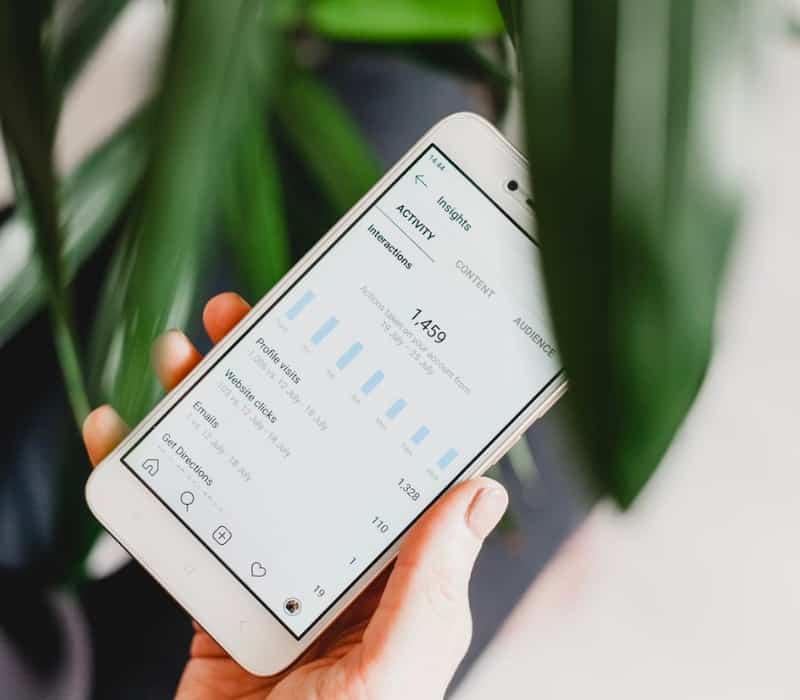
A website is usually the most significant income stream, but how do travel bloggers make money on social media? If you have a large social media following, you can absolutely use it to make money.
It usually involves ambassadorships and sponsored content . We have already touched on this, but creating content specifically for brands or companies and getting paid to post it on your social media channels is a great way to make money.
Whenever you post sponsored content, it’s essential to be transparent. Mark the post as sponsored and if you can use hashtags like sponsored or ad, so everyone knows the brand paid for the content.
11. Monetizing a YouTube Channel

Another way to make money as a professional travel blogger is by starting a YouTube channel and vlogging (video blogging) about your experiences.
I don’t personally have a YouTube channel, but I know a ton of travel vloggers who make a living from their travel videos. It’s a great way to earn income if you’re wondering how to make a travel blog and make money.
📷 how bloggers can make money on YouTube
Travel blogs that make money on YouTube do so through sponsorships and allowing ads to play in their videos.
The catch is you must be a part of the Youtube Partner Program to begin monetizing your channel, which requires at least 500 subscribers and either 3,000 watch hours in the previous 365 days or 3 million shorts views over the previous 90 days.
At least three public uploads in the last 90 days are also required.
12. Monetizing a Travel Podcast

Podcasting is hard work. I know firsthand from when I started travel blogging podcasting with my podcast, Dream To Destination , in 2020.
But I also learned one of the best travel blogger tips: podcasts help your reach and domain authority. Plus you can make money with a travel podcast.
Podcasts have become extremely popular over the last few years for many reasons. People love to listen to their favorite hosts talk about their experiences and discuss the world of travel with experts from various fields.

I wrote a detailed guide, How to Start a Travel Podcast for Free (Like I Did) , so if you want a deep dive into this topic, you can check it out.
You can monetize your podcast similarly to how you monetize travel blogs, including advertisements and leaving affiliate links & promo codes in the description.
Then, if your podcast is successful enough, you may find sponsorships from travel companies who want to feature their products or services on your show.
If you don’t mind public speaking, this is an excellent option, but it also has one of the highest upfront costs since most people need to buy recording equipment before they can begin.
13. Selling Digital Projects
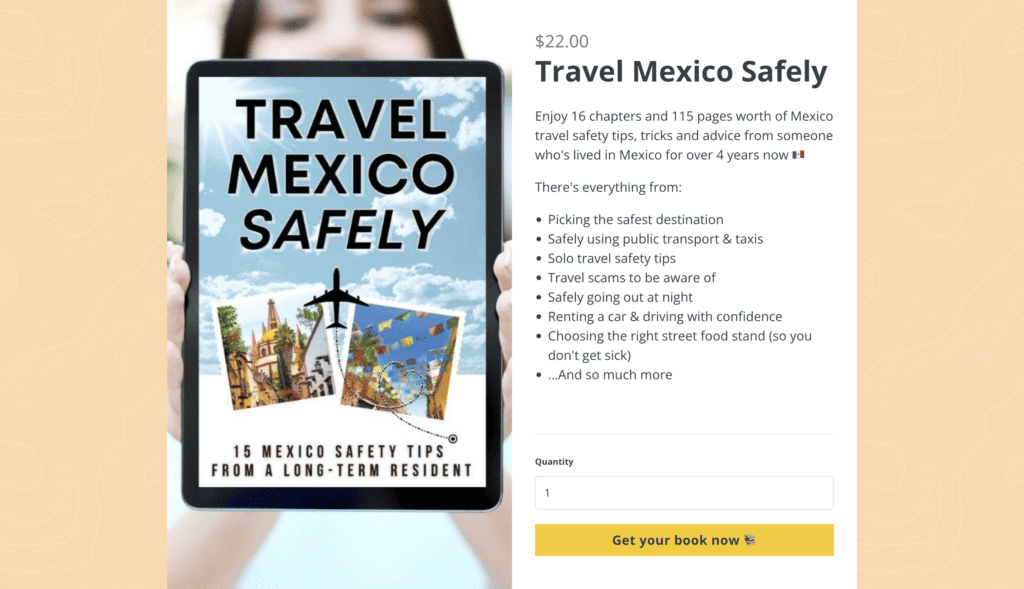
Selling digital products is an excellent way for travel bloggers to monetize their content.
By creating digital products such as eBooks, printable travel planners, travel guides with travel tips, courses, and calendars, bloggers can earn a steady passive income stream from the sales of these items.
You can feature these products on your site, but highlighting them in your email list can be much more profitable. That’s because you already have a grasp on what your audience enjoys.
Digital products are great because you create them once, and then you can set up systems to sell them passively with hardly any additional work or product creation (although updating/optimizing these products regularly will increase sales)
Many bloggers use platforms like Canva to create their digital products quickly and easily; although the free version may be sufficient for some, the paid version is well worth the $13 USD per month. ▶︎ Sign up for Canva here .
Then for processing the sale of the product, I love using Gumroad and ThriveCart .
14. Selling Merch
Selling merchandise is another strategy to get income from and have travel blog success.
You could sell anything from t-shirts and hats with your logo to reusable water bottles and notebooks. You can also create custom artwork with your logo or quotes from your blog to put on stickers or patches.
Bloggers also use their merchandise in giveaways to help build their email list or social media following.
While dipping your toes into selling physical products is a big step, there are ways to do it these days that require very little overhead with services like Printful , which will handle the printing and shipping for you.
15. Developing Travel-Related Products

If you’ve been blogging for a while and have become a successful travel blogger, you can consider creating your own product or service.
You could create an online course teaching people how to start their own travel blog or how to be a travel blogger on Instagram. You could even design custom itineraries for clients with specific interests. Be creative with it!
It’s important to understand that creating your own product or service requires more effort than other ways of making money as a travel blogger, but it can be very rewarding to provide personal coaching or travel planning for your audience.
16. Offer VA Services

If you’re comfortable working with clients, becoming a virtual assistant (VA) is another great option for monetizing your travel blog.
It’s also a great way to continue growing your blogging skills since you will be working in close quarters with bloggers who are already successful.
VAs are in high demand and provide services like social media management, website maintenance, content writing/editing, email marketing, and more.
The great thing about this approach is that it allows you to be flexible with your schedule and work from anywhere. You can also choose which clients to take on, your working hours, and your location.
Rates vary depending on your experience and the client’s needs, but if you have been running your own blog for a couple of years, you probably have all the necessary skills to be a great VA.
You can then start to look for clients through job boards like Upwork , Freelancer , and Fiverr, but the best way to find gigs is to join Facebook blogging groups and offer your services.
17. Freelance Writing

Freelance writing is one of the most popular travel blogger jobs for anyone who is at the beginning of their blogging journey.
It involves ghostwriting for other bloggers and businesses who are trying to publish a lot of content on their websites (typically more than they have time to write themselves).
You will need to write from the perspective and in the voice of your client, as well as know how to write an SEO-optimized blog post to be a great freelance writer.
👩🏻💻 freelance writing enhances your skills
The best part is that if you’re a current blogger, you already write a travel blog and therefore have a resume for freelance writing.
A travel blogger who sees and loves your blog is likely to hire you over another candidate because they want you to do the same for them.
Writing is one of the most popular ways travel bloggers make money before their own blog has an income high enough to sustain themselves.
You can find freelance writing jobs on job boards such as ProBlogger , Fiver , and Contently , or you can also contact bloggers directly and ask if they have any writing projects available.
How much can you earn from a travel blog?
The sky’s the limit when it comes to making money through travel blogging. There is no set travel blogger salary. It’s similar to asking how much artists make – while some may become millionaires, others are content with a small Etsy shop.

Successful travel bloggers achieve a high income by taking the proper steps toward monetizing their blogs. This travel blogger success often comes through coaching and courses that specialize in becoming a successful travel blogger.
Making money from a travel blog is a lot of work, so successful bloggers regularly invest in learning to optimize their blog for SEO, learn affiliate marketing, and use their skills as leverage to score partnerships & freelancing opportunities.
What’s the average travel blogging salary?
Some bloggers have provided yearly income reports of over 1 million dollars, while others only make a couple hundred dollars each year.
Since most bloggers do not disclose their travel blog salary, it’s hard to know the average travel blogging salary.
🏆 Here are My Blogging Stats
- I made $ 272,175 USD in 2022.
- I made $40,106 USD from blogging in December 2022 — $24,151 from affiliate marketing, $9,382 from ads on my site, and $6,572 selling my own products, like this Affiliate Marketing course .
- My main website (not this one) received 205,000+ page views in December 2022, and more than 2.6 million page views in 2022.
- Want to know how I did it? Join my email list , where I share tips on how I make such a crazy amount of money after just 2.5 years of blogging.
How to Become a Travel Blogger
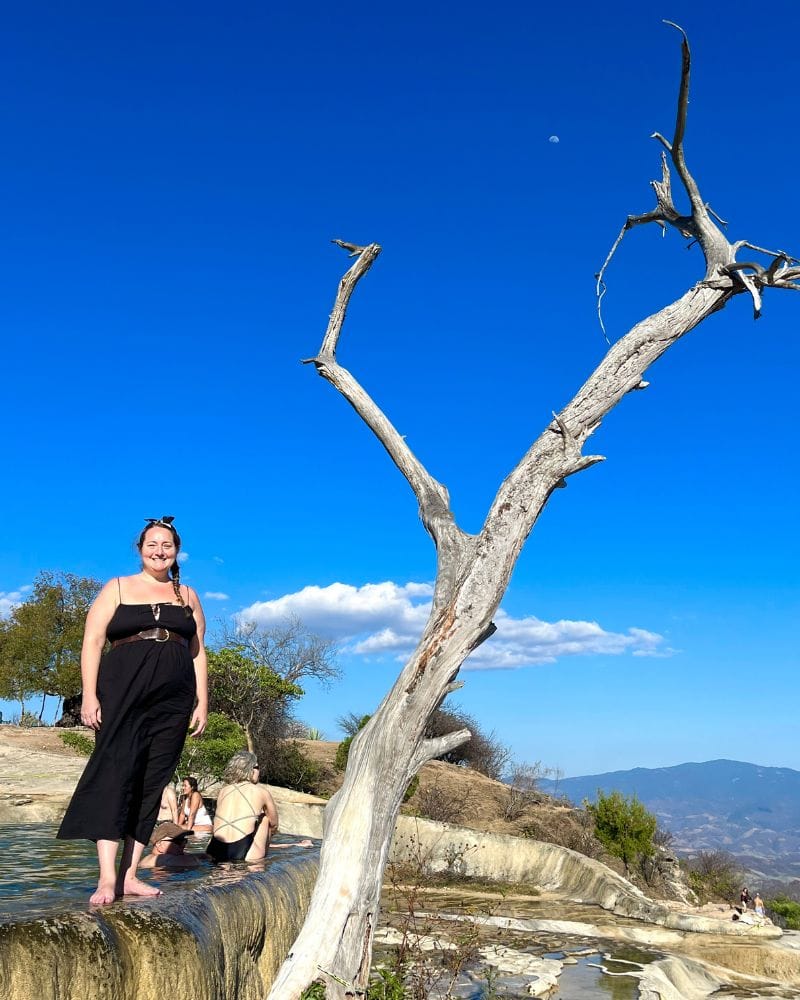
Like most things, I believe there’s a right and wrong strategy for how to start a travel blog and make money.
If you want to learn how to become a travel blogger and make money, I highly suggest investing in a travel blogging course with step-by-step instructions so you start it off right.
The best blogging course I’ve done is Scale Your Travel Blog to Six Figures — and I’ve done quite a few courses .
There is a system to travel blogging success, and you either know the system or you don’t.
You’re either writing SEO-optimized content with high volume, low competition keywords that will rank on Page 1 of Google, or no one will see your content. In fact, stats say only 25% of users even go to Page 2 of Google.
Through travel blogging courses, I learned that how to become a travel blogger and get paid means I need to write the articles that people want to read, not just the articles I want to write.
I learned how to get my content on Page 1 of Google with search engine optimization (SEO) — in fact, that’s likely how you found this article!
The way I see it, you can spend time, or you can spend money.
You can either spend your time trying to find good free content, which could take years and still not pan out, or you can pay a professional to learn what they’re doing, so you can simply replicate their success.
Ready to invest in a travel blogging course? 👉 Head here to see the best ones!
How Travel Bloggers Make Money: FAQs

Ready to make money blogging? Here are some frequently asked questions about how much does a travel blogger make and how to earn money from travel blog. Ready?
How much money can you make as a travel blogger?
There is no ceiling to how much money you can earn. Travel bloggers can make anywhere between zero and seven figures, depending on their monthly traffic, the products/services they recommend, and how well their affiliate links convert to customers.
Do travel blogs really make money?
Yes — travel blogs really do make money through various sources like affiliate marketing, joining ad travel blogger networks, selling digital products, and paid sponsorships.
It takes dedication and hard work to build up an audience and monetize your blog, but it can make you a lot of money over time.
Who is the highest-paid travel blogger?
It’s hard to know who the highest paid travel bloggers are, but some of the top travel bloggers like Matt Kepnes (Nomadic Matt) , Dave & Deb (The Planet D) , Kiersten (The Blonde Abroad) likely make upwards of $100 000 per month from their travel blog and services.
Is it hard to make money as a travel blogger?
Making money as a travel blogger is hard work. It’s a marathon, not a sprint, and it often takes a couple of years before you have an established travel blog making a lot of money.
However, with the right strategy, it is absolutely possible. The best way to speed up the process is by hiring an experienced blogging coach like me — I offer 1 on 1 coaching services.
Is it too late to start a travel blog?
No — It’s never too late to start a travel blog. The travel space is constantly evolving, and there are always new opportunities for aspiring bloggers.
Established blogs are better positioned for gaining traffic and making money from their blog, but there are millions of keyword opportunities, and new bloggers rank #1 on Google every day!
Final Thoughts: How Travel Bloggers Make Money
And there you go. Those are the most common strategies travel bloggers use to make money! Now you know how travel bloggers earn money and that there is no limit on the question, how much money do travel bloggers make?
Whether you are in travel blogging for beginners or an expert looking for more travel blogging tips, there are many different ways to monetize a travel blog.
In the end, don’t be afraid to think outside the box. Ready to make money from travel blog? Good luck!
Ready to invest in a travel blogging course? 👉 Sign up for the FREE live webinar to meet my coach Laura, who has helped me grow my blog fast!

13 Clever Ways To Boost Your Travel Blogging Income [Podcast Episode 23]
Want to boost your travel blogging income ? Have you ever wondered how to actually travel and make money, or asked yourself how to become a paid travel blogger?
Then you’re in the right place, as that is exactly what we’ll be covering in this episode of The Profitable Travel Blogger Podcast.
Specifically, you’ll learn:
- How to earn money blogging — including the five main ways I monetize my website
- 13 additional smart strategies for making money from a blog
- 13 platforms that make it way easier to make money from a travel blog — or simply to make money online while traveling
Basically, if you’re interested in learning how to become a blogger and make money this podcast episode has the answers you’re looking for.
Table of Contents
13 Clever Ways To Boost Your Travel Blogging Income – Podcast Episode Audio
…or click the links below to tune in on your preferred audio platform:
Click here to listen on Apple Podcasts/iTunes
Click here to listen on Spotify
Click here to listen on TuneIn
Grow + Monetize Your Travel Blog With These Free Resources

To help you really jumpstart your blogging success, I’ve added 55+ blogging resources like printables, video tutorials, and workbooks into a FREE resource library for travel bloggers.
These resources are meant to help you grow your traffic, community, and income faster and with less overwhelm.
I’m all about implementation and I really want to make sure you don’t just listen to the episode and forget about it, but that you actually use what I share to make your blogging life easier. Inside the library, there are a number of printables and tutorials that will help you take what I share in this episode, and efficiently implement it.
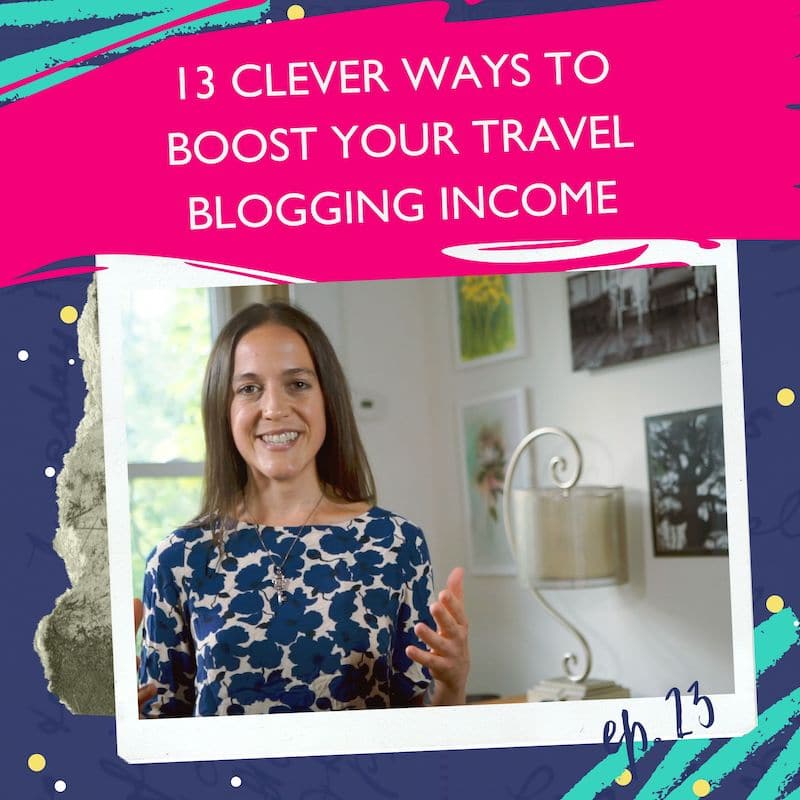
How To Get Paid For Blogging – Episode Transcript
Starting a travel blog, growing a blog , building traffic, growing an email list by creating opt-in freebies , being active on social media, creating your blog business plan . Ultimately, all of these different actions have one common goal:
To boost your travel blogging income.
That’s why I think you’ll love this episode because I’m going to be sharing how to become a travel blogger that makes money — including specific platforms that can help you increase your blogging revenue quicker and easier.
How much do travel bloggers make?
To kick things off, let’s talk about what a travel blogger income looks like.
Honestly, it can vary anywhere from $0 to millions. It really depends on how many revenue streams you have, how well you promote these streams, and if you’re able to scale.
I think a realistic goal when starting out is to aim for $2,000-$4,000 per month and then work to scale to $10,000+ per month. In my opinion, this is very doable, especially if you have your own products or a lot of traffic you can drive to blog posts optimized for affiliates. Here are some creative ways to promote affiliate links .
Once you reach $10,000 you’ll likely have a good sense of what strategies work to scale beyond that.
Automated income streams — like running display ads or having evergreen funnels runnings — is a great way to go beyond the $10,000/month mark.
How do bloggers get paid?
Wondering how to become a travel blogger and make money ?
To answer this, I’ll share the main revenue streams that allow me to make money from my travel blog. These include:
- In terms of how to make money blogging, the above is one of my favorite strategies that is also one of the most underrated
- Want to increase sales? Try showcasing certain products in a tripwire marketing funnel !
- Working with brands and tourism boards on paid blog, email, and social media campaigns as well as paid press trips for travel bloggers
- blog content (like writing a gift guide )
- product lists that promote Amazon affiliate links
- a free challenge that promotes an affiliate partner
- a resources page that promotes your top recommendations with affiliate links
- Running display ads on my website with Mediavine
- Selling a blog for profit
- Crafting content for brand platforms — for instance, I might write for a hotel’s online magazine or help an app fill up their content library with original lists and photos
So hopefully that gives you a quick and general idea of how to monetize a travel blog , and answers the question, “Do bloggers get paid?”
Now what I want to do is dive deeper to give you some very specific ideas for how to start a travel blog and get paid.
Just note that at the time of recording all of the platforms I’m about to mention — which are all also linked below, many with affiliate links — were live.
Of course, that could change, but the tactics still work in terms of helping you become a paid blogger.
This means if you listen to this episode in the future and one of the platforms I mention no longer exists, simply keep the strategy in mind but try to find an alternative platform.
On that note, here are 13 ideas for how to monetize your travel blog.
1. Earn money blogging by creating an email course with Highbrow.
Highbrow is an email course membership site that covers a wide range of topics from travel to writing to health & fitness to entrepreneurship and beyond.
If you have an interesting idea that they haven’t covered, you can create a 10-lesson email course for them, and earn commissions every time one of their paying members takes it.
It’s a really simple way to make some money, as you create the course once, it gets uploaded, and then you’re done and you can start earning an income.
In terms of how to be a blogger and earn money , I recommend making the course relevant to your blog’s topic so that you can promote it right on your website.
2. Get paid to blog by creating an online course with Teachable.
In my opinion, this is one of the most profitable digital products you can sell as a blogger, especially if you follow a product launch marketing plan template to increase sales or pre-sell your online course to validate your idea.
Teachable is what I use to create and host my online courses and membership. That link gets you a two-week free trial, no credit card required!
I’m a huge fan of their platform, as it really has everything you need to run a professional and secure online school.
They have tons of features, so I won’t list them all, but a few I love include:
- built-in discussion forums
- secure payments
- the option to add quizzes or award certificates
- student and school progress reports
- coupon functionality
- affiliate tracking and payouts
- conversion pixel tracking so you can see, for example, if your Facebook Ads are working
- the ability to add and create custom school pages beyond the sales page, curriculum, and checkout page and just a really user-friendly interface
They even have an app so your students can do your course modules right on their phone.
Keep in mind, as a blogger you’re already educating your audience on a topic. Therefore it makes a lot of sense to package your knowledge into a course that further helps them.
3. Become a paid blogger by creating an online Udemy course.
As you’re probably starting to see, when it comes to blogging for money creating courses can be a smart option.
Now personally I prefer Teachable to Udemy because with Teachable I have 100% full control over my content, pricing, and sales.
I also am able to get the email addresses of my students and pitch them to opt in to my email list when they checkout.
In my opinion, with Udemy you do give up quite a bit of control. You have to follow their course creation guidelines and they often run sales that I think devalue the work of the course creator.
That being said, their platform works like a search engine. So if you are at a point where you just want to test out course creation or you don’t want to put 100% of the promotion in your own hands, Udemy can be a good option that also allows you to get started quickly.
I just personally think if you really want to maximize your earning potential, Teachable can be the better option, or even Thinkific , which is also really good. I just prefer the user experience and aesthetic of Teachable.
4. Become a paid travel blogger by joining Perlu and applying for brand campaigns.
There are so many influencer networks out there, but they certainly aren’t all created equal. I’m an advisor for Perlu , and it is one of my favorite influencer networks for a few reasons.
For one, you can collaborate with other bloggers and content creators in groups, or what Perlu calls Packs, to help each other grow.
Moreover, you can simply click into their Collabs section to find paying blogger opportunities to apply for. No waiting around necessary.
By the way, I created a free list of influencer networks here . The list offers 31 networks that make it easier to make money traveling by working with brands as a blogger. They make it easier to land your first brand collaboration !
Additionally, you can join my Perlu Collaborative Posts Pack here .
5. Optimize your website for affiliate links with Skimlinks.
If you’re wondering how to become a blogger and earn money the easiest way possible, you’ll love this idea.
Skimlinks is a set-it-and-forget-it affiliate marketing option for bloggers.
Instead of manually creating affiliate links and adding them to your content, you place Skimlinks’ code into your website. From there, Skimlinks will automatically turn your non-affiliate links into affiliate links — helping you to increase your passive blogging income.
If you’re wondering how to monetize a WordPress blog , installing Skimlinks is a wise idea.
Just note that for this service Skimlinks does keep a portion of the earnings, though I personally still find this platform extremely beneficial and love the true additional passive income each month.
Besides Skimlinks, another option is joining white label affiliate programs , which can also help you automate your affiliate efforts!
6. Become an Ultimate Bundles affiliate and contributor.
Want to know how to be a travel blogger and get paid?
Strategic travel affiliate marketing !
You should absolutely be making sure that a portion of your travel blog post ideas include affiliate-optimized posts promoting partners you love.
Like Ultimate Bundles.
Ultimate Bundles is a company that sells limited-time themed bundles, typically with bonuses, at incredible price points. You may have heard of the Genius Blogger’s Toolkit, for example, which typically sells for 95%-98% off.
No matter what your blogging niche is, it’s likely you’ll find a bundle that you can promote. They have bundles on everything from blogging to travel to self-care to creativity to meal-planning and beyond.
As an affiliate, you earn 40% per sale, and because their bundles are sold at wildly discounted prices the bundles can be quite easy to sell.
Additionally, you can create a product to put into a bundle to increase your affiliate income to 70% — plus you get a contributor bonus.
The other benefit is their bundles are extremely popular. This means even if you don’t make a ton of sales you’ll be bringing loads of new people into the community as they gain access to your bundle product.
You can click here to join their affiliate program .
7. Sell a tour using PeekPro.
Wondering how to be a travel blogger that earns a sustainable income ?
As a travel blogger, selling tours — either local or abroad — is a natural fit. Consider the travel style, interests, and budget of your audience, and go from there.
I recommend adding in some VIP options; as in, experiences that make the tour more valuable. This doesn’t need to be going behind some velvet rope at a club. It can be as simple as getting to go behind the bar at a coffee shop to see how they make the perfect cappuccino.
By the way, if you’re wondering how to start a tour company I’ve linked a free cheat sheet that can help.
In terms of set up, I use PeekPro to sell my tours, which you can connect to your blog.
Their software has a ton of embedded features for upselling and bundling tours, and they even have an abandoned cart feature that automatically emails potential customers who didn’t complete the checkout process.
While PeekPro is free, they do charge a setup fee; however, they have a referral program where current PeekPro users — like myself — can refer others to help them get their software set up for free or at a steep discount.
If interested, please send me an email to jessie (at) jessieonajourney (dot) com.
By the way, I also recently interviewed Kelly Lewis, the founder of Damesly, about how to start a multi-day tour company . This is another great strategy for increasing your income as a travel blogger!
8. Become a travel blogger and get through doing an apparel campaign with Bonfire.
Bonfire shirts are super high-quality. No joke, I had to hide mine because my fiance kept stealing it.
Anyway, what I love about Bonfire is you can design your own shirt for free and then they’ll ship your products directly to your buyers.
You keep the profits — basically the price of your shirt minus the base costs.
You can run the sale as a limited-time campaign, or even open your own store and promote it on your blog.
9. Sell your creations on Creative Market.
If you’re curious how to make money traveling , here is an idea for the creatives:
Creative Market is an online marketplace for design assets like fonts, graphics, themes, social media templates, mock-ups, and more.
I’ve made loads of purchases from this site over the years — honestly, their resources have helped me feel creative and remember how to enjoy social media — though along with using it as a buyer you can also use it as a seller if you’ve got some design skills.
This can be a great way to earn extra money, and you can promote your Creative Market shop on your own website.
10. Create and sell a subscription box through CrateJoy.
Like Creative Market, CrateJoy is a marketplace where you can choose to buy or sell, though their focus is subscription boxes.
They have subscription boxes related to everything from travel to beauty to art to gaming and beyond.
As a seller, you’ll benefit from using their platform from a tech perspective as well as from their traffic — they get 4 million page views per month — and their popularity, as they see about 30,000+ monthly sales.
11. Get paid to travel blog by creating an online shop for relevant products using Sellfy.
The secret to how to blog and make money doing it:
Selling products that help your audience.
Sellfy is an alternative to the well-known platform Shopify, though it’s more budget-friendly, allowing you to create an online store and connect it to your blog without spending a fortune. They even offer a 14-day trial.
If you’re not sure what to sell, consider your blog’s mission. Who do you help and how? What product could further help your audience beyond your free content?
Keep a spreadsheet of all the questions people ask you via email, DM, and in blog comments. This offers good insight into what people want from you.
Also, remember that products don’t need to be complicated. It can be as simple as a well-thought-out printable that helps your audience solve a problem.
12. Host a workshop on WebinarJam.
WebinarJam is a webinar hosting software that can also help you grow your income.
Let me share two ways to go about this:
First of all, if you want to make money with free webinars you can create a free workshop that’s relevant to your paid product, and then pitch your paid product at the end. This works well, as the free workshop allows you to attract the people who would benefit from your paid offer.
It also allows you to show off your teaching style and empower your audience who may have previously thought they weren’t skilled enough to benefit from your paid offer.
For instance, if you have a course on making professional travel videos, you might use the first module as your webinar to get people started and get them excited to learn even more.
Keep in mind, you can also charge for webinars. Just note if you go this route it’s recommended to make it extra special since many people are used to free webinars. Really make sure the content is premium and potentially limited in terms of how many people can attend and how many sessions there will be.
Click here for a free trial of WebinarJam .
By the way, if you need help with your webinar strategy check out this video:
13. Find remote work on FlexJobs.
If you’re a blogger looking for remote work opportunities that pay well while you build up your business, FlexJobs is your answer.
Their subscription service is reasonably-priced and lists loads of interesting work-from-anywhere job opportunities and gigs that pay.
Many of them also include travel as an additional perk. I’ve also seen loads of writing and content creation jobs on their site.
Now I hope you enjoyed this episode on how to make money blogging.
I hope you feel inspired and empowered to start monetizing your blog.
Don’t forget to grab access to the free travel blogging resource library . There are a ton of resources in there on increasing your blogging income.
And of course, make sure to subscribe so you don’t miss future episodes sharing these bite-sized strategies for bloggers who want to turn their blogs into profitable full-time blogging businesses.
Happy blogging!
Increase Your Travel Blogging Income With These Helpful Past Episodes:
How To Grow Your Travel Blogging Income With A Tripwire Funnel
Create A Challenge That Grows Your Email List & Business Income
How To Make Money With Affiliate Marketing As A Blogger
Monetize Your Email List With 4 Smart Strategies
Create A Profitable Automated Email Sequence (With Template!)
Press Trips 101: How To Get Paid To Travel As A Blogger
How To Create & Monetize A Blog Series
How To Grow Your Blog Fast With 12 Clever Strategies
How To Create A Gift Guide For Your Blog
How To Host & Promote Your Blog Giveaway
How To Write Better Emails With Email Storytelling
Connect With The Profitable Travel Blogger Podcast
Stay in the loop.
Do you want to get notified when new episodes publish?
Then make sure to opt-in for podcast email notifications sent to your inbox!
You can do that by clicking here .
Subscribe + Review (To Win A Prize!)
Love learning new blogging strategies to help grow your website traffic, community, and income?
Click here to subscribe on iTunes to be notified when new episodes publish.
I’d also be extremely grateful if you’d leave a review right here and let me know your favorite part of the episode or a takeaway you walked away with. By leaving a review, you help the show be seen by more people, helping the episodes to have a greater impact.
Each month, I’ll be choosing one reviewer at random to win a FREE seat inside one of my masterclasses.
Winners can choose from:
- How To Grow Your Blogging Income Through Facebook Ads
- How To Land Paid Press Trips As A Travel Blogger
- How To Make Money (Fast) With Affiliate Marketing
- How To Start A Tour Company In Your Own Backyard
- How To Start A Blog, Grow An Audience & Make Money
- Build Your Blogging Profit Plan Masterclass
Winners will be chosen at random from the reviews and will be notified via email, so make sure to send me — jessie (at) jessieonajourney dot) com — your email address so I have it.
Do you have any other tips on how to create a blog and make money?
Related posts:.
- Partner Help Center

Travel Blogging Salaries: How Much do Travel Bloggers Make?
Oct 16, 2023 | Blog , Featured-4 , Travel Affiliate Guides
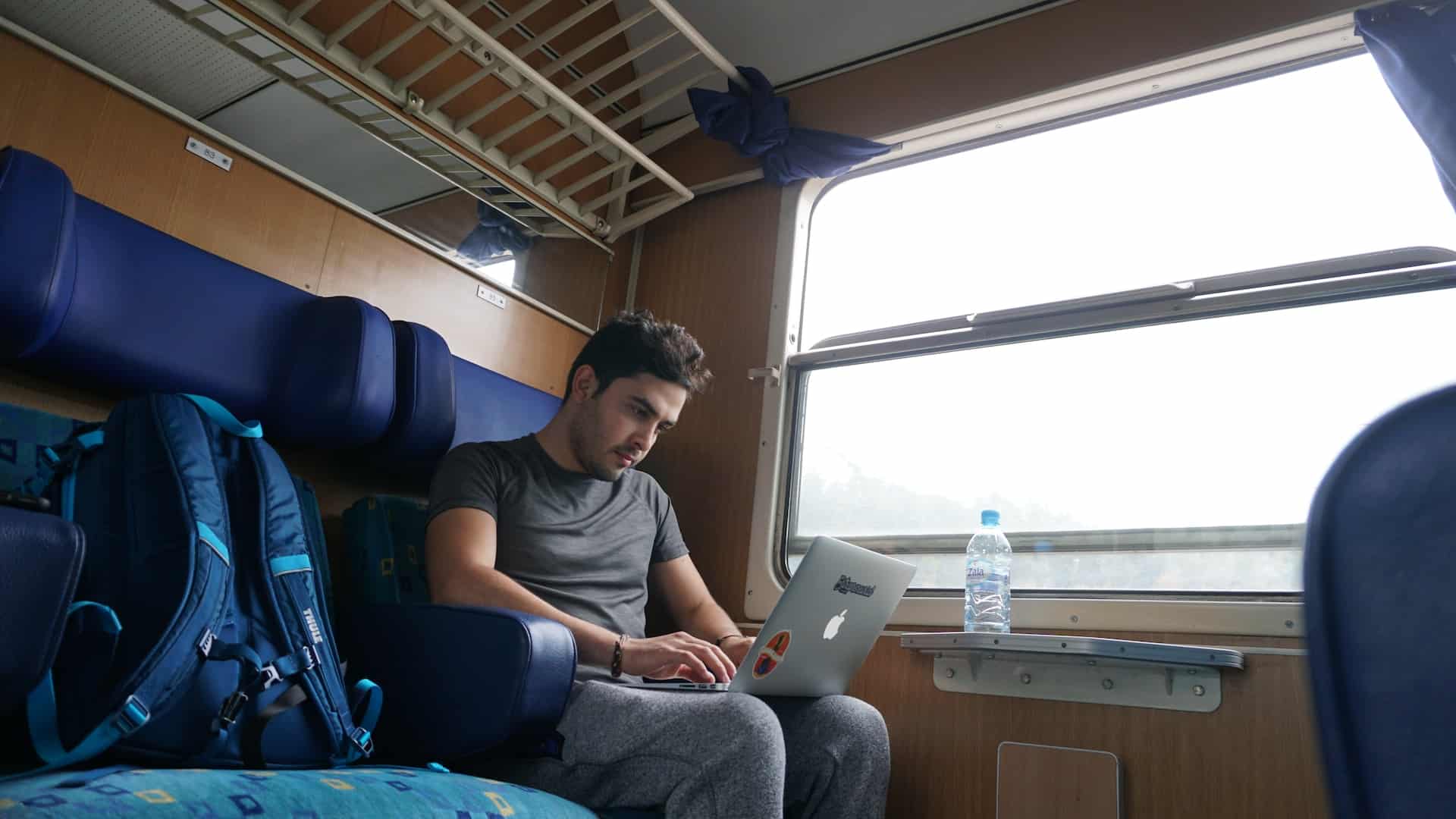
Do you wonder how much money travel bloggers make? Are you considering a career move into travel writing full-time or wondering if you can make some money through the travel blog you created as a hobby? Maybe you’re just curious how your favorite travel bloggers sustain their glamorous lifestyles. Is it possible to make a living by just writing about travel?
Multiple Ways to Earn Income as a Travel Blogger
Travel blogging is not a one-size-fits-all career, nor is the compensation. In this piece, we’ll look at three different forms of travel blogging and provide income ranges for each. These are not the only ways to earn money as a travel blogger, but they help illustrate how compensation varies based on factors like who you’re writing for (yourself or someone else) and prior writing experience.
Our goal is to show that, while not everyone can expect free trips around the world in exchange for a few Instagram posts, there are ways to monetize a passion for exploration and high-quality writing. If you’re inspired to write by the time you finish reading, let this post be a starting point for continued research.
Path #1 – Blogging for other companies
Today, most companies recognize the value of having a blog and have invested resources to build authority on specific topics through this channel. Travel companies often use their blogs to offer customers a more authentic and personal perspective on their products or services.
Writing for a travel company blog provides a high level of financial stability and regularity of work because it is the most traditional of the three pathways we’ll discuss. A travel blogger is a company employee and receives the same benefits and job security as a worker in any other department.
In exchange for stability, writers usually have less control over their subject matter and the overall creative process. The blog is a marketing tool for the company, not a platform for a writer to express their opinions.
Income ranges:
According to Glassdoor, the salary range for a Travel Writer * in the United States is $51,000 – $86,000, with an average salary of $66,000. This figure varies slightly from city to city. Below, we provide the breakdown for the top 5 metropolitan areas in the United States.
*Someone who writes full-time for a company’s blog usually has the title “Writer” or “Copywriter.” To provide the most accurate comparisons in this post, we collected Glassdoor data on “Travel Writers” as a proxy for “Travel Bloggers.”
Path #2 – Freelance travel blogging
Freelance travel bloggers are hired as needed to complete writing assignments for travel companies or publications. These bloggers often work for multiple companies and can choose which projects they will work on. In most cases, they can use their own writing style and voice and receive credit for writing in their piece’s byline. Freelancers create and manage their own schedules, and their workflow is constrained only by the requirements of the brief and submission deadlines.
Like other freelance professions, travel bloggers must proactively seek paid writing opportunities. Self-promotion and relationship-building are as important to a freelancer’s success as the writing itself. Freelancers use portfolios to showcase their writing ability and prove to companies that their writing will be a worthwhile investment.
For freelancers, there is no standard frequency of writing assignments. Their workload depends on how aggressively they seek out jobs, how many companies they have in their work rotation, and the companies’ editorial needs.
Freelancer travel writers can charge by project, hour, or word. The amount they can charge depends on their reputation and the quality of their published writing. The more skilled and experienced the writer, the higher the rate they can command. Writers can also charge a higher rate for more labor-intensive writing that requires original research or investigation.
The top freelance travel writers on Upwork charge rates from $10.00 to over $125 an hour, though most writers fall into the $20 to $60 range. Glassdoor provides similar figures with rates from $21 to $40 an hour when searching “ Freelance Blog Writers .”
Path #3 – Blogging for Yourself
This is what most people think of when they hear “travel blogger.” A travel blog gives a travel enthusiast the most creative control of the three options and the most variability in earning potential.
Maintaining a travel blog requires considerable work in addition to writing. Bloggers must be webmasters, designers, copywriters, copyeditors, and marketers for their blogs. Technical tasks, such as updating WordPress plugins or SEO optimization , are all part of the job.
Three popular ways that travel bloggers monetize their blogs are through affiliate marketing, selling ad space, and creating sponsored content. The amount a travel blogger can earn from each revenue stream depends on factors like blog traffic, audience buying power, and content quality. We’ll briefly define those digital marketing terms below:
Affiliate Marketing: With Affiliate Marketing, writers promote a product or service on their blog and earn a commission when purchases are made through their link. Many travel bloggers have successfully monetized their blogs in this way through Viator’s Affiliate Marketing Program .
Advertising : Blogs that receive a certain amount of monthly traffic can sell advertising space on their page through display ad networks such as Mediavine or Google AdSense. Think of this ad space like a newspaper or billboard advertisement. The RPM , or revenue per mille (revenue per thousand impressions), determines the amount a blogger receives per advertisement on their blog.
Sponsored Content : Depending on a blog’s popularity and reach, bloggers may be paid or receive free products or experiences in exchange for creating original content. The lucky few bloggers who receive all-expenses-paid trips in exchange for a write-up or mention on their blogs fall under this category.
Monthly Income Reports from Travel Blogs
Below, we’ve compiled a list of high-performing travel blogs and broken out monthly earnings by source: Affiliate Marketing, Advertising, Sponsored Content, and Other. This data represents one month of self-reported earnings for each blogger at different points in time.
A few notes about these examples:
We compiled these monthly income reports as examples of how the highest performing travel bloggers monetize their blogs. Recognizing that these results are exceptional, though possible to replicate, is important.
Each blogger describes their growth timeline and career journey on their own blogs. For more information about their experiences, we encourage you to read about their personal experiences in their own words.
Tips for Choosing Your Career Path as a Travel Blogger
By now you should understand that the answer to the question “How much do travel bloggers make?” is a resounding “IT DEPENDS!”
If you’re seriously considering entering the world of travel writing, ask yourself the following questions to help you decide which pathway to take:
Am I a good writer?
Answer this question honestly. Though you might be passionate about travel, travel writing may not be for you if you cannot translate your feelings into compelling copy.
While this eliminates travel blogging for a company and freelance travel writing as viable professional pathways, this shouldn’t stop you from creating a blog. If you’re a skilled photographer, use your blog to showcase your travel photography. You could even earn extra income by licensing your images for commercial use.
How much creative control do I want to have?
Do you have a specific vision for blogging? If so, you might feel creatively stifled by a company’s work processes and brand guidelines. As mentioned earlier, a company blog is a marketing tool for the company first and foremost. It is not the place for a writer’s creative experimentation or self-expression.
How much time can I realistically dedicate to travel blogging?
When sharing their success stories, the above bloggers all stress the importance of a strong work ethic, self-discipline, and patience. They all mention that they only started earning after months of hustling- tweaking their website design, writing regularly, and developing unique perspectives. If you aspire to their level of success, you must give yourself ample time to get there.
The more time you spend working on your blog, the more likely you are to earn the traffic needed to monetize your blog, even in small ways.
Conclusion / Summary
The goal of this post was not to encourage or dissuade anyone from pursuing a dream of travel blogging. Rather, it was to provide actual numbers to help you make informed decisions about which career path best suits your interests and skillset.
We believe that if you have a story to tell, you should tell it. Your story may stay a part-time hobby that eventually grows to provide some supplemental income through affiliate partnerships . Or, that story may become the next My Global Viewpoint, subsidizing your worldwide travel.
As we hope you’ve learned, there are types of travel writing to fit every work style and risk tolerance. If you enjoy the security of an office, explore full time roles as a travel writer. If you have writing experience, build up your portfolio and start pitching ideas for freelance travel projects. And if you’re starting from scratch, use your own blog to tell your story. Just get writing and see where the journey takes you.
Recent posts
- The Social Media Creator’s Guide to Viator Experiences
- How to Promote Viator Experiences on Social Media
- Create Content That Converts with Performance Trends
- A Guide to Creating High-Converting Content with Viator Experiences
- 5 Tips for Finding High-Converting Experiences Your Audience Will Love
- Terms of Use
- Privacy & Cookie Policy
Travel Blogger Salary

If you’ve ever considered dabbling in travel blogging, you may have wondered about the earning potential involved. What's the income of a travel blogger and could you live off a travel blogger salary? We took it upon ourselves to find out the answers to these questions, so read on to find out about how to get paid as a travel blogger and, more importantly, how much.
Do Travel Bloggers Make Money?
Many people dream of being able to quit their day job and travel the world full-time. There are many ways to make money while traveling, blogging being among the most popular. Travel bloggers share their experiences and photos with their readers, and many also work with brands to promote products or services. Some travel bloggers are able to make a full-time income from their blog, making for a decent travel blogger salary per year, but others may only make enough to cover their travel expenses.
As for how travel bloggers make money, advertising is usually the most significant source of income, but it can vary significantly from month to month. Then, there’s affiliate marketing involves promoting products or services on your blog and earning commissions on every sale that you generate. And finally, sponsored content is where brands pay you to create content that promotes their product or service. Usually, the travel blogger's income is determined by the mix of advertising, affiliate marketing, and sponsored content.
How Much Do Travel Bloggers Make?
Those who do make money out of travel blogging can land anywhere from a few hundred dollars to several thousand dollars per month in an average blogger salary. Naturally, those with a large social media following can command higher rates from advertisers. Likewise, those who produce high-quality content and have developed a loyal following of readers can also earn a substantial income from blogging. In short, there is no limit to how high your travel blogger salary can be — it all depends on your dedication and ability to market yourself and your brand.
Now, let’s check some real numbers. According to ZipRecruiter, a travel blogger can make anywhere from $16,500 up to $126,500. For the majority of travel bloggers, though, this payment ranges from around $34,500 to $90,500.
And in case you’ve ever wondered who is the highest-paid travel blogger, the answer would be Matt Kepnes. This is one travel blogger who has been able to turn his passion for travel into a full-time career. In 2010, he quit his job and set out on a round-the-world trip, documenting his experiences on his blog, Nomadic Matt. Since then, he has built up a large following of dedicated readers, and his blog has been ranked as one of the top travel websites in the world. Kepnes's success as a travel blogger has allowed him to live a life of adventure, and he now earns a six-figure travel blogger salary from his blog and associated projects. He is proof that it is possible to make a living from travel blogging, and he is an inspiration to aspiring travel writers all over the world.
How Much Do Travel Bloggers Make on Instagram?
The key to making money on Instagram as a travel blogger is to grow a large following and post engaging content that will encourage people to click on the links in your bio. These links can lead to sponsored posts, affiliate sales, or other income-generating opportunities. If you're able to consistently produce high-quality content and grow your audience, then you could potentially make a full-time travel blogger salary from posting content on Instagram.
Judging by some statistics on blogging , top Instagram travel bloggers make anywhere from $5,000 to $20,000 per post and can make even up to $31,000 per post, according to Vogue. That might sound like a lot, but keep in mind that these posts usually take a significant amount of time and effort to produce. And, of course, not every post is going to be a winner. The average travel blogger salary on Instagram is likely to be much less than the top earners’ salary.
How to Start Making Money as a Travel Blogger —Tips & Tricks
If you're thinking of starting a travel blog and ultimately earning a healthy travel blogger salary, there are a few things you should keep in mind.
First, it's important to update your blog regularly , specifically at least once a week. Not only will this give your readers something to look forward to, but it will also help you stay disciplined and organized. Stats show that 16 is the optimal monthly number of travel blogging posts.
To earn a good travel blogging salary, focus on quality over quantity . Rather than just posting lots of photos, take the time to write engaging and thoughtful posts that capture the essence of your travels.
Don't be afraid to get personal. Your readers want to connect with you, so share your stories and let them get to know the real you.
Diversify your content —consider branching out to vlogs. Both blogs and vlogs have their advantages and will further broaden your potential audience.
Maintain a strong social media presence. Platforms like Instagram and YouTube give you a way to reach a wide audience of potential readers and viewers, so make sure to take advantage of them.
Collaborate with other bloggers —offer to write guest posts for other blogs. This will increase your reach and get you to new readers, boosting your travel bloggers salary potential.
Monetize your blog —some ways to do that would be to work with travel companies on sponsored content, as well as get banner ads and affiliate links. All of this will help you earn revenue from your content.
The End of the Journey
While there's no single formula for success, it is possible to make money off your travels. With some effort, determination, and most importantly, producing high-quality content, you can get yourself a good travel blogger salary, and, as they say, live the dream.
How To Become a Travel Blogger (and Get Paid)
In addition to being a fun hobby, traveling can also be a profitable activity. In this article, we will share a step-by-step guide on how to become a travel blogger. You will also learn how to earn on your blog with Travelpayouts , and we will also reveal other methods to get paid and answer the most frequent questions, such as how much money you need to become a travel blogger, how much you can earn on your travel blog, and more.

Who Can Become a Travel Blogger?
If you look at existing travel bloggers, you will find a variety of people among them, including solo travelers, married couples with children, retired people, young people, and even children.
There is no single portrait of exactly what a travel blogger looks like, but there are a number of personal characteristics that are desirable to have in order to become a successful travel blogger.
Love to Travel
It is hard to find a person who does not like to travel. If you don’t like traveling, then you are unlikely to become a successful travel blogger. However, since you are already looking for guides on how to become a travel blogger , most likely you already have a love for this topic.
While blogging, you have to share your experiences, inspire people to travel, and delve into the details. Therefore, for a successful start, it is important that you love to travel as well.
Technical Skills
Starting a travel blog is not rocket science. Below, you will find a detailed plan to become a blogger. If you’re able to work with any apps, such as Microsoft Word, then you’ll be able to get to grips with the intricacies of blogging on a technical level as well.
Complex technical solutions, such as automated emails for your subscribers, can always be entrusted to specialists; however, to start and run a blog, you probably will not need to hire anyone.
Clarity
Blogging is about content, you have to share information with your audience. This can be in any format, such as text, photos, or even a video or podcast.
It will be great if you know how to correctly and clearly express your thoughts in any format. If not, no problem. Among bloggers, there are few real journalists, but there are many ordinary people who blog in their own styles and communicate with the audience in their own ways. Clarity is the most important factor for making your audience comfortable with your content. Moreover, writing skills can always be improved, especially since there are many courses, such as:
- Copywriting Masterclass
- Blogging – Blog Copywriting
- Copywriting For Beginners
Being persistent and achieving what you set out to do is an important quality in any endeavor, including blogging. Although, with our step-by-step guide on how to become a travel blogger and earn money from blogging, you can go faster than if you started from scratch. You need to be willing to work and be persistent.
Many bloggers do not receive income for their work at first and, only with an increase in traffic, do they start earning. With that said, some of them earn even five figures per month.

Step-By-Step Free Guide on How to Become a Travel Blogger and Get Paid
You can become a travel blogger in less than a day. However, launching a travel blog is only the beginning. There is plenty of work to develop a blog and generate a high income. Below, you will find a free, step-by-step guide on how to start a travel blog and get paid.
1. Choose the Format of Your Future Blog
You need a platform on which you will share content and attract your audience. This could be:
- A standalone travel blog website, such as travelbybrit.com, theworldtravelguy.com, okeventures.com, etc.
- Blogs on various blogging platforms, such as Medium.com
- A social media account
- A YouTube channel
Posting on someone else’s website, such as Medium, may sound simpler than the other options; however, there are big risks and limitations. Since you do not control the third-party website, you would have limited opportunities in terms of earnings (most often, you cannot embed ads).
Social media platforms are a great addition to standalone travel blogs. However, establishing a YouTube channel is usually a time-consuming project that requires a different approach.
The first option (your own website) is the most popular for starting a blog . Thus, we will examine the process of becoming a travel blogger based on this approach. With that said, even this option has various approaches. You basically have two options for launching a website:
- Create a website on a free platform, such as Blogpost
- Create a standalone website on your own domain, such as travelblog.com
The first option is temporary for most bloggers (it is almost impossible to find a successful blog that kept their website on free platforms), since such solutions significantly limit one’s technical capabilities and earning opportunities.
Creating a standalone website is the correct strategic approach. You will be in control of the site, so you would be able to choose the way you post content, the way you earn on your travel blog, etc.
2. Website Creation
To launch a travel blog you will need:
- Domain – the name by which you can be found on the Internet
- Hosting – a computer on which your site will be located, from where it will be accessible to users around the world
- Content management system – the technical part of your blog, which will make it possible to manage your site
- Website design – how your website will look
Let’s explore each point in more detail.
You need to find a free domain (spoiler: most words are taken, so you likely will need to invent your own name to find an available domain) and buy it. Usually, a domain can be purchased for a one-year period, and then each year, you will extend your registration. All this can be done at any of the following sites:
- And many others (just use Google to find the most suitable option for you)
There is one most popular domain zone (.com) and many others, such as .net, .info, or even .travel and .blog. In the .com zone, it is difficult to find an available name. In the others, it is a bit easier. However, in pursuit of a beautiful name, check the popular domain zone anyway so that you don’t run into problems in the future.
Cost: $10-15 per year for the domain in the .com zone and 0-200$ for most other domain zones.
Many domain registrars offer to buy hosting right away. This is a good solution, but there are many hosting companies. Thus, you can buy a domain and hosting in different places. Here is a short list of some hosting providers:
- A2Hosting.com
- Scalahosting.com
Most hosting providers allow you to upgrade your plan in the future. During, in the beginning, the initial fees will be enough for you and you should not buy an expensive plan. In the future, when you have a lot of traffic on your travel blog, you can expand your hosting.
Cost: $50-100 per year
Content Management System
A content management system (CMS) is a program on the server. For you, it is more like a visual interface, like Microsoft Word, in which you can interact with your travel blog as an administrator. You can learn more about CMSs in this video:
The most popular travel blog management system is WordPress. If you do not have specific requirements, then don’t even bother looking at the alternatives and immediately select this option.
Some hosting companies are able to install the CMS for you, but you can definitely do it yourself. Here is the official manual .
WordPress is so popular and suits many travel bloggers, as its functions can be extended. For example, to install an SSL certificate, you can use a special plugin, as well as work with photos, SEO, etc.
Cost: from $0
After installing WordPress on your hosting platform, your travel blog will already be available to users, but it will look like this:
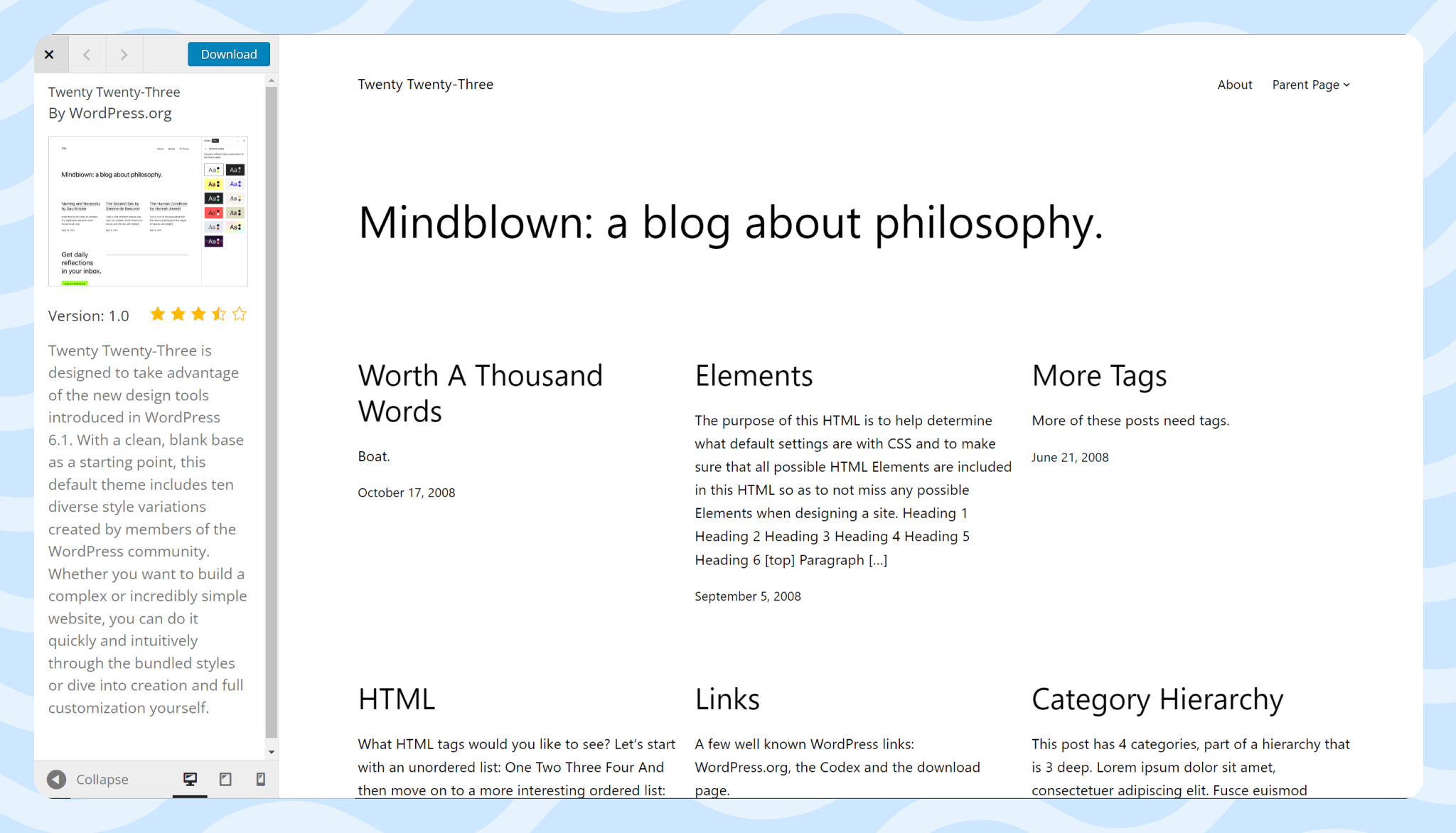
This is a free standard template that all WordPress blogs are starting. However, there are dozens of free pre-made designs. All you have to do is install them from your blog’s admin panel:
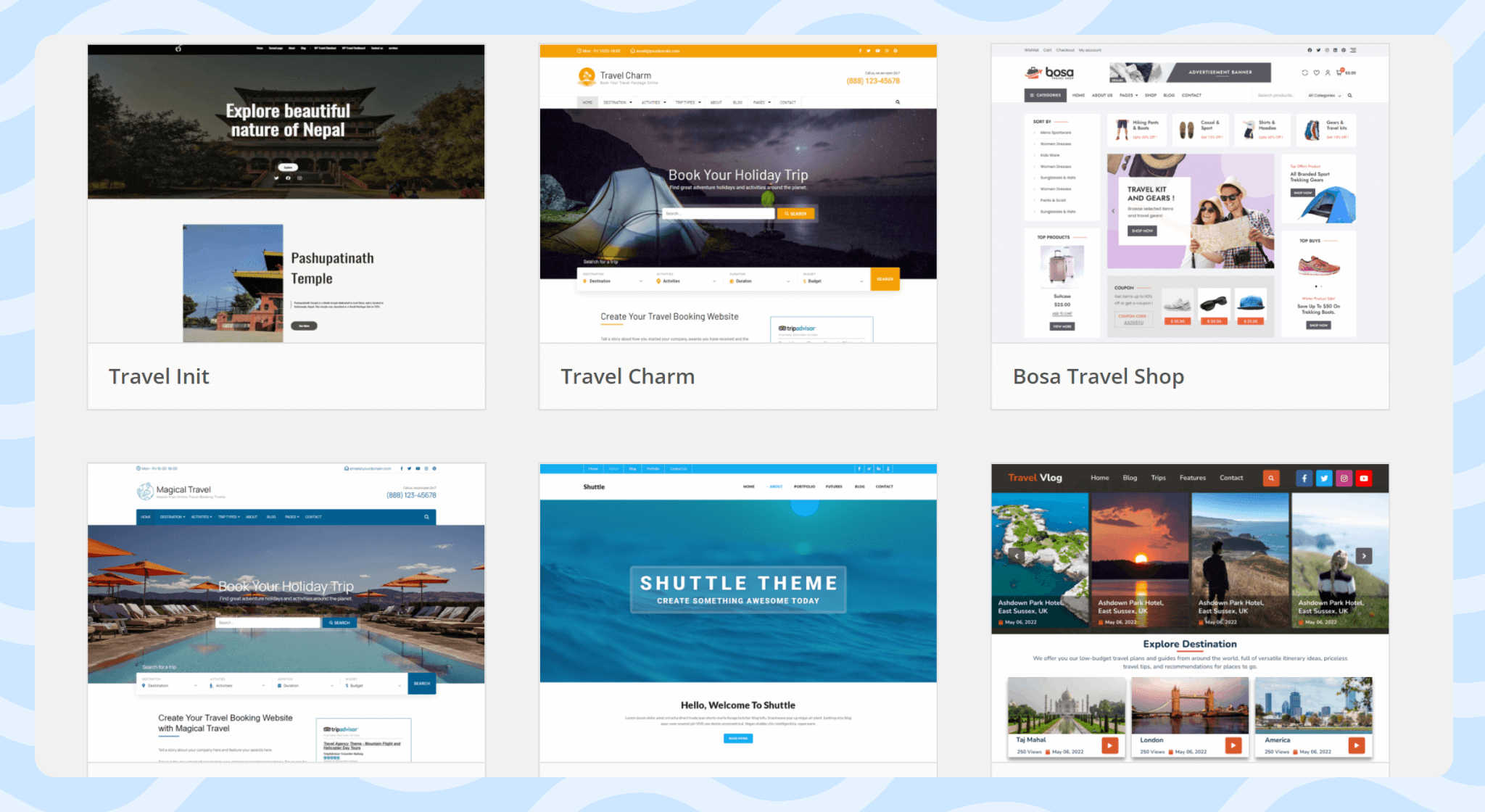
There are also many paid professional ready-made designs that you can buy (for example, on ThemeForest ).
You don’t have to invest in a paid design and logo right away, as your design doesn’t have that much of an impact at the initial stage. Thus, you can start a blog with zero costs and upgrade it in the future.
3. Content Creation
If you’ve already reached this step, we congratulate you! Your blog is live and available to your audience! The first two stages were preparatory. Now, the constant work of creating content for your blog begins.
You need to prepare your first piece of content. To do this, explore topics that you think will be interesting to your audience. Creating a table of contents, writing an article, checking it for plagiarism, and more come after. The number one step is determining what your future audience will be searching for.
If you focus only on your own interests, you risk having low organic traffic. It is important to write about what is interesting to you and your audience at the same time. You can literally check how many people are looking for this or that search query and prepare material for it. How to do this is discussed in more detail in the free Travelpayouts course from the eminent travel blogger Sharon Gourlay .
When preparing your content, try to provide the most complete and detailed responses to user requests. Also, demonstrate your expertise. Even in the initial stages, this will help you gain the trust of the search engines that will generate traffic for you.
Google and other search engines will, in most cases, be your main sources of traffic, so it will be very useful to take their requirements into account when creating content. You can learn more in various courses, such as:
- Best of SEO: #1 SEO Training & Content Marketing Course
- Content Writing & Copy Writing For SEO and Sales
You can also attract additional traffic to your website from social networks. To do this, you have to first create social networks, and then publish posts about new articles on your blog.
Content creation is indeed a lengthy process. You may not have much per article at the very beginning, but for good traffic volume, you will probably need a lot of articles that can drive a decent amount of traffic.
To speed up the process, you can also hire authors (spending about $0.10 per word on average). However, hiring someone to write for your blog is most common in the later stages, once you have already figured out what kind of content you need to create.
Google is potentially your main source of traffic, and Google in 2024 values expert content. To prepare such content for your blog, you have to travel and dive into your topics.
There are bloggers who prepare posts based on someone else’s content. Such articles are difficult to make more useful than existing content and, therefore, are more difficult to promote on Google. In addition, you will also have problems with photos, since you cannot take someone else’s photos without permission or you will have to buy them on sites like Shutterstock. Therefore, traveling for yourself is an integral part of running most travel blogs.
You do not have to go to the other side of the country or even leave your hometown (unless you want to). Study the demand of the audience in your city or nearby locations. It is likely that you can create content about something near you. For example, if you live in Virginia, you can create content about your surroundings (for example, Virginia’s national parks are in huge demand):
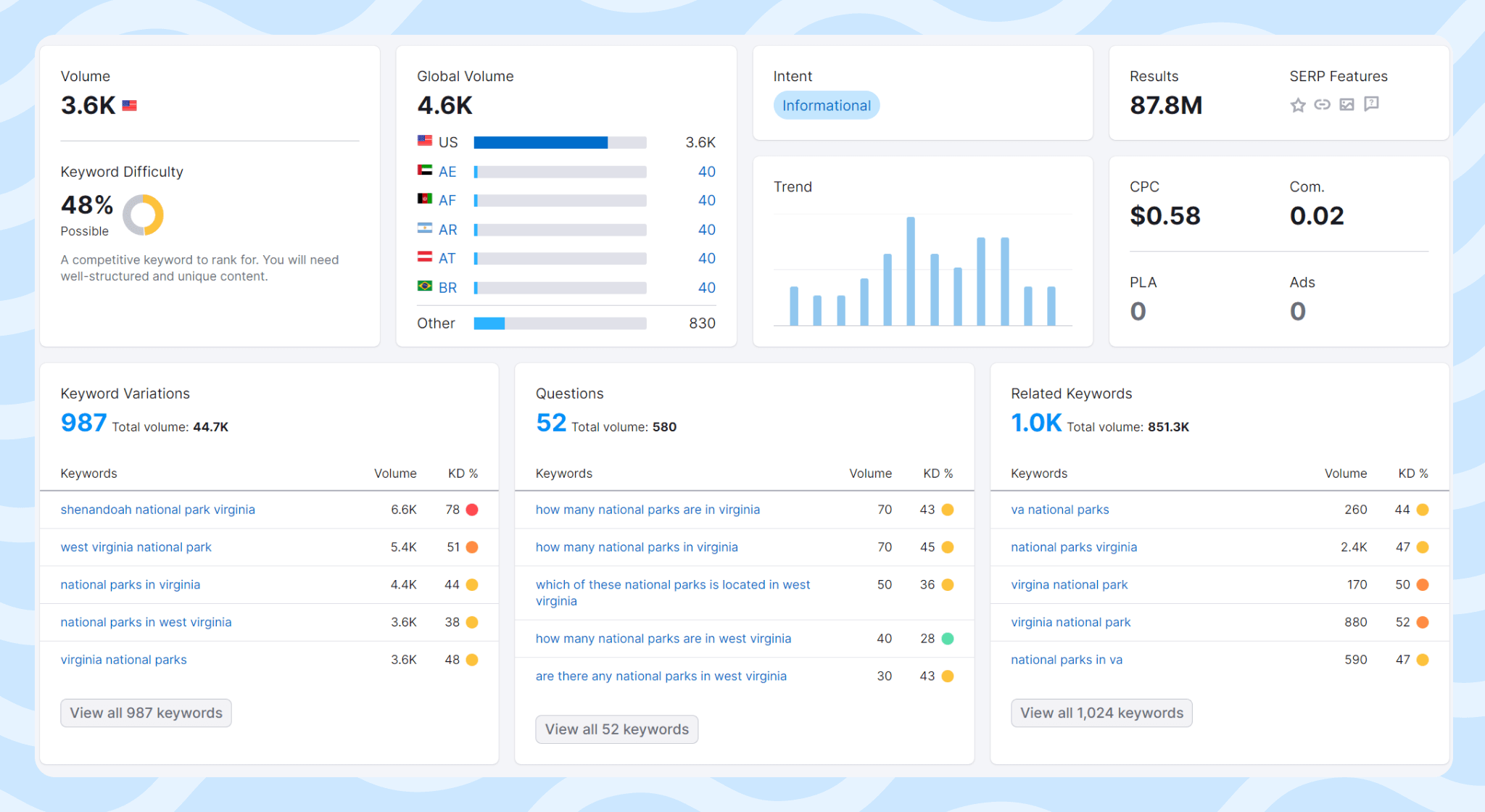
An alternative to travelling for yourself could be hiring copywriters and travelers who will share their stories on your pages, but this, as we noted earlier, is a different approach and requires investment.
How to Get Paid As a Travel Blogger?
Being a travel blogger is not only fun and beneficial to the travel community, it is also a source of solid income. It’s a paid hobby! That’s great, isn’t it? Not all travel bloggers earn five figures monthly, but you can easily get $1,000 to $2,000 a month in a short time after starting your blog. Below, you will find the most popular ways to get paid as a travel blogger.
Affiliate Marketing
To get traffic from search engines, your content must be useful to your audience. Affiliate marketing can make it even more useful, while earning you more money. It works like this:
- You recommend a service from a specific brand in your articles, such as a hotel on Booking.com or a tour on GetYourGuide.
- Your audience buys services based on your recommendation (clicking links in your article to proceed to the specific travel brands’ websites).
- You receive a commission for the sale. Brands share their income with you as thanks for recommending travelers to book a service on their platform.
The travel services price for your audience is exactly the same as without your recommendation. So, they are not overpaying or losing anything, just getting good recommendations. Brands will be more willing to share sales revenue if they see your channel is a great source of customers for them.
You can earn up to 40% of the cost of services from affiliate marketing, but usually, brands share up to 10%. Here are some examples:
All of the listed brands and dozens of others are available on the Travelpayouts Partnership Platform . More than 350,000 successful travel bloggers have already joined the platform and you also can join as well to access links that allow you to recommend the services of your audio room:
Join the Travelpayouts Partnership Platform
Access exclusive tools and the best travel partner programs, including flights, hotels, car rental, insurance, tours and activities, all in one place.
You can connect your travel blog to travel affiliate programs literally from the first day of your website’s existence. Some brands accept only blogs with traffic, but there are many that work without moderation. Nevertheless, traffic on your site is important for earning money.
Since you will be earning revenue from sales, that revenue will start coming in once your articles have traffic. However, you can also place affiliate tools right away, so that, in the future, you don’t have to return to integrate links into existing articles.
Affiliate marketing is one of the most popular options for those who want to become travel bloggers and make money. To figure out how to become a successful travel blogger and make money with Travelpayouts, join a free course .
Contextual Advertising
In addition to earning on the recommendations of travel services to your audience, you can earn on advertising by completing the following steps:
- Join an advertising network, such as Ezoic or Google Ads
- Place the ad code on your website
- The ad network shows ads inside your articles
- When your audience clicks on an ad, you earn per-click revenue
This method is not related to the sale of services and goods. It doesn’t matter if the person who clicked on the ad ended up buying what was offered to him/her. Since the advertiser risks much more in this case than in affiliate marketing (where you receive income for sales), the income per click is much lower. Moreover, many modern ad blockers (such as Ad Blocker Plugins for Google Chrome) prevent such ads from displaying.
Some travel bloggers can combine this method with affiliate marketing to earn even more. For example, by placing contextual advertising on pages where you do not offer (and could not offer) any services directly from brands for a commission.
Freelancing
If you are an active traveler, then you can make money as an author. Having your own travel blog will be a great portfolio and you can even make some decent money by writing for someone else.
You can place an offer on your blog that you are open to creating content, as well as participating in specialized copywriting groups on Facebook. You can also offer your services on Fiverr, Upwork, or other freelancing platforms.
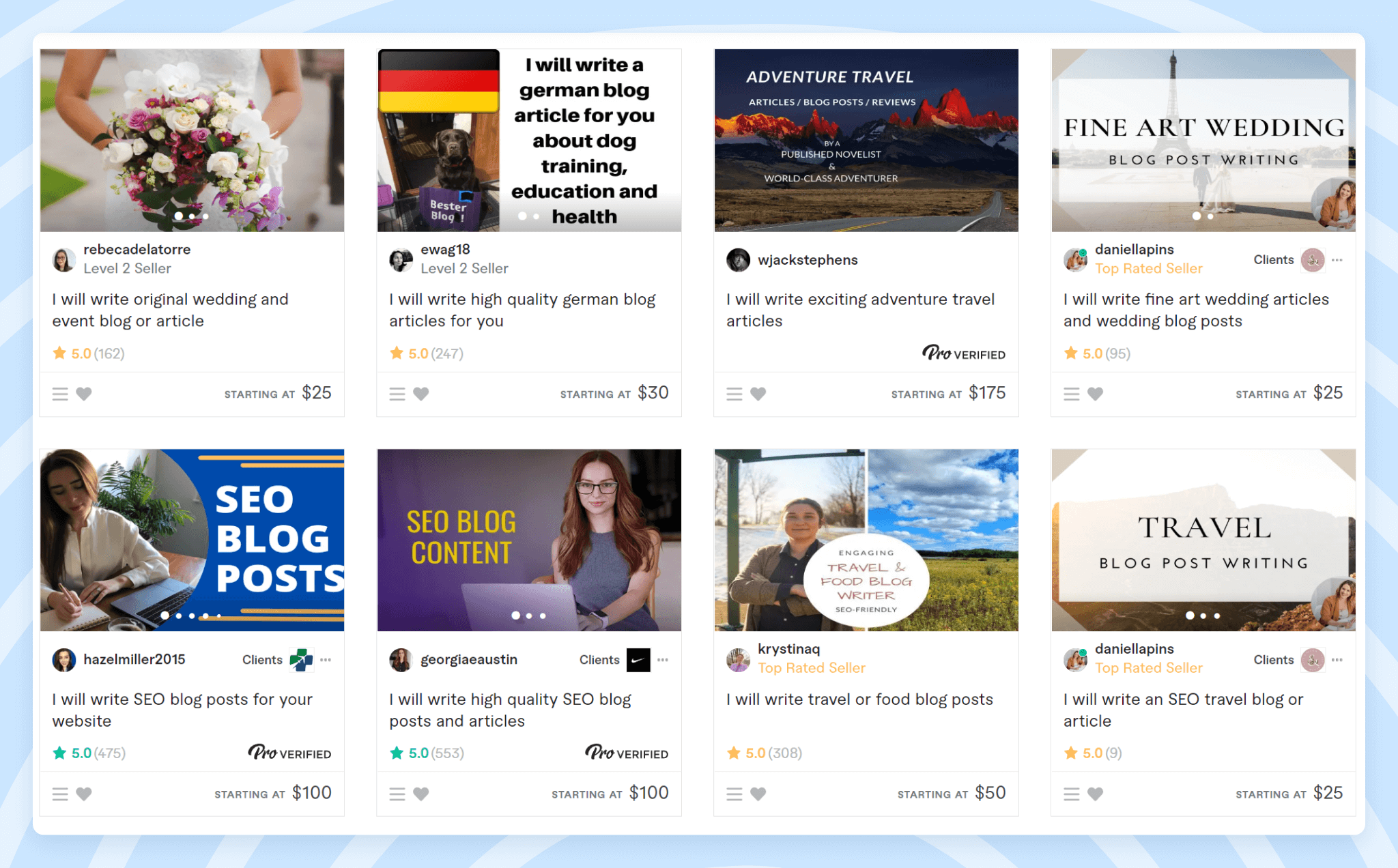
On average, you can earn about $0.10 per word in English.
Guest Posting
Your travel blog is interesting to other site owners in terms of SEO. In some cases, people may be willing to buy links on your site, especially if your blog has a high DA rating .
The guest post or link price depends on the authority of your blog as well as how many external links it already has. A regular blog may earn a few hundred dollars per link, while a more reputable and popular blog can earn over $1,000 per link.
This is an attractive method, but unlike affiliate marketing and advertising, it is a one-time thing. In addition, you need to create new content for new links (usually people are not ready to buy from posts that already have a link, and previous buyers will not think it is fair if you sell an extra link next to theirs).
In addition, selling links can negatively affect your organic traffic, as paid placements are sometimes viewed negatively by Google. This is often considered a manipulation of the rules of the search engine. Therefore, you should not abuse this method to earn money, and perhaps you should not use this method at all.
Is It Possible to Become a Travel Blogger and Live Off the Income From Your Blog?
Becoming a travel blogger is not as difficult as becoming a successful travel blogger who earns money from blogging. However, there is a lot of evidence that this goal is quite possible to achieve. Here are the stories of just a few bloggers:
- Travelbybrit.com
- Theworldtravelguy.com
- TheLithuanianAbroad.com
- Oceanwideexplorers.com
- Twooutliers.com
Among successful bloggers, there are completely different people, many of whom started in the 2020s. This debunks the myth that it was necessary to start earlier. The only correct answer is that, if you start now, you can also become a travel blogger and earn money through Travelpayouts and other means.
Even though there is a lot of work to put in, and reaching five figures per month can take a long time if you are a newbie, traveling the world and making money on it is definitely possible.
Although the idea of becoming a travel blogger is very attractive to most people, even after our step-by-step guide, you may still have questions. So, we answered some the most common questions here.
How much money do I need to start?
You can start a travel blog for $0. Above, we mentioned some costs, but you can start for free. For example, social media platforms are excellent places to share and earn money on your travel experiences. You can also start a blog on your own domain for less than $100.
Even though successful travel bloggers usually travel a lot to create new content, you can start where you are now. This is the first location that you can speak about as an expert. By creating content yourself, you will not have to deal with the additional costs of hiring authors.
Is it necessary to travel to become a successful travel blogger?
Each person lives in their own area and you can become an expert of this location. Of course, the potential of various places is different. You can study the tourist demand before starting a blog, including through Google Trends .
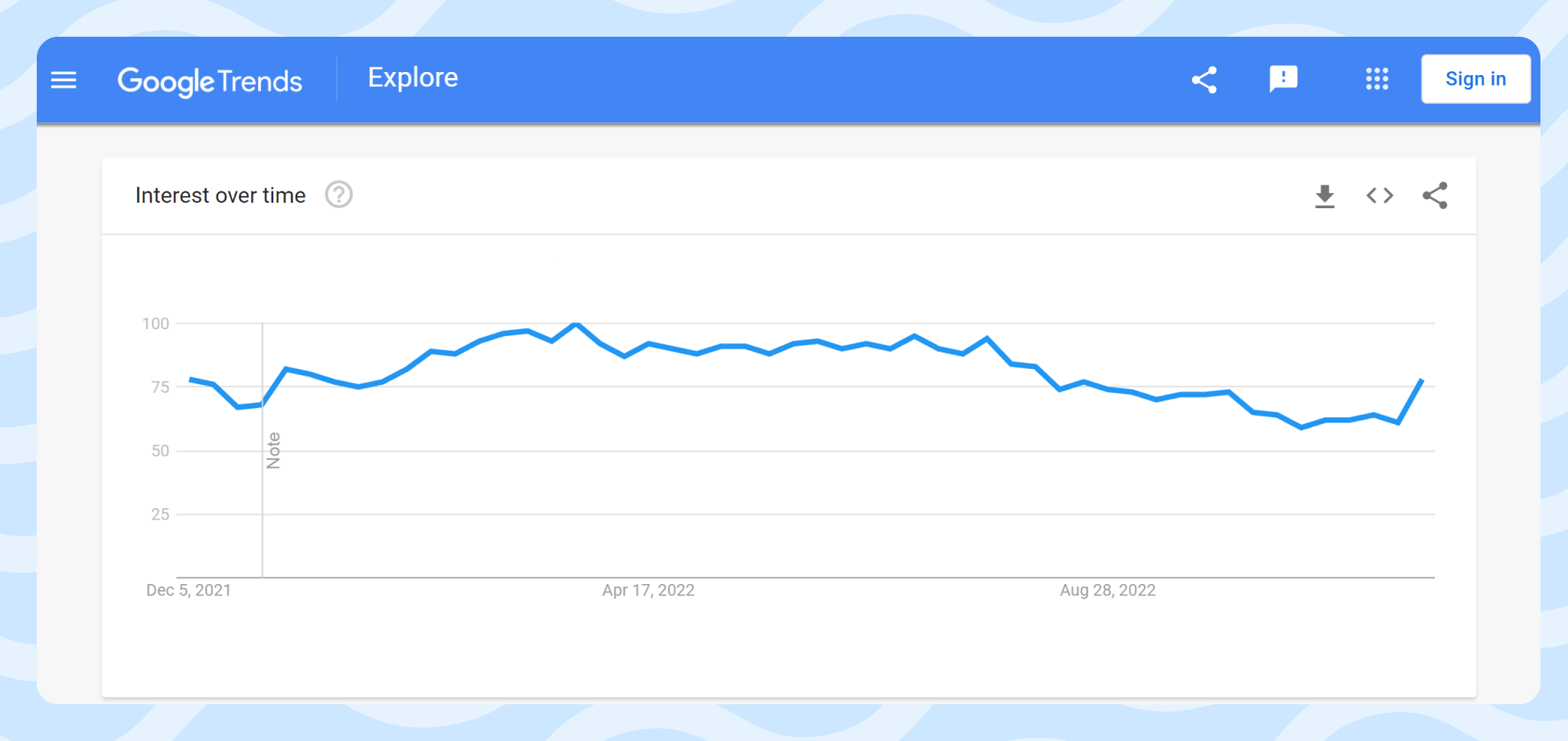
If you can’t share stories about the place you are right now, you can also choose not to travel and create content about your past travels. In addition, you can invite authors to prepare quality content for you.
If you can travel (even on a budget), it will dramatically expand the topics you can write about.
Some bloggers talk about places they have never been and prepare content based on the stories of others. These bloggers mostly approach blogging as a job and are more likely webmasters than bloggers. This approach also allows you to produce a lot of content, but there is a high chance that Google will not give preference to your content and you will not attract much traffic, since Google and real people prefer an expert creating unique content.
How much can I earn from a travel blog?
Having a travel blog does not guarantee that you will earn money. You have to find your audience since traffic on your blog is necessary in order for you to earn via most monetization methods, such as affiliate marketing or contextual ads.
There is no cap on earnings. As mentioned earlier, some bloggers earn five figures per month. To calculate your estimated revenue, you can use the average revenue per 1,000 impressions ($30-50 for US traffic). You can predict your estimated traffic based on the search volume of search queries you are creating content for.
If you have any questions about how to become a travel blogger and start making money on your blog, write your suggestions in the comments and we will be glad to help.
This Is How Much Money Food Bloggers Can Actually Make
Taste Senior Editor, HuffPost
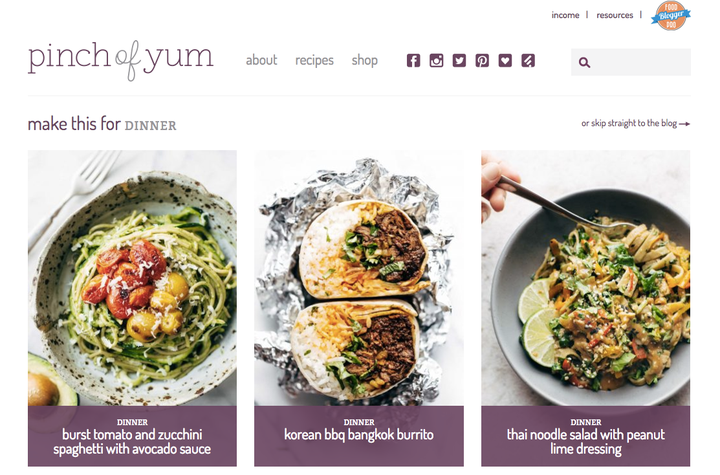
Pinch of Yum is a successful food blog. But just how successful monetarily? It’s a question we all wonder about food blogs.
Turns out this particular blog is successful enough to be a full-time job for the husband-and-wife team behind it ― plus staff.
Lindsay and Bjork Ostrom, the duo behind the blog, have working on Pinch of Yum since 2009 and they made it their full time job in 2014. The bloggers post beautiful photos of delicious-looking food that inspires us to get back into the kitchen. And they do one additional thing that not many other food bloggers do: they post all of their earnings and expenses online, for everyone to see.
How exactly food bloggers make a living has long felt like a mystery, but thanks to the Ostroms we can see precisely how they function as a business. They make money mostly from ads and sponsored content, but have other avenues for revenue from Amazon partnerships and their e-book.
The Ostroms began posting the blog’s earnings in August 2011, when they made a measly $21.97 that month. They began the public project to see if they could make money food blogging (which they called the Food Blogging Money Making Experience ). Folks, they succeeded.
If you go through the months with them over the years, you can see the earnings grow ― sometimes exceeding over $90,000 in one single month. For real.
But of course, more money means more problems and by that we mean expenses. The aforementioned month (November 2016), when Pinch of Yum made $95,197.34, their expenses were $28,505.27. So their profit was closer to $66,692.07 ― not bad for one month’s work.
This is how much they earned during a 12-month period (from December 2015- November 2016): $802,144.55
This is how much their expenses totaled up to during that same time period: $293,014.38
This was their 12-month profit: $483,883.51
We broke it down month by month below, so you can see for yourself. We started in December 2015 and ended with November 2016, in order to show a 12-month earning. (November 2016 is the most recent month in which they’ve released an earnings report.) Here are the numbers.
December ‘15
Income: $86,884.12
Expenses: -$16,377.44
Profit: $70,546.68
January ‘16
Income: $77,140.58
Expenses: -$28,314.83
Profit: $48,825.75
February ‘16
Income: $63,682.99
Expenses: -$28,062.54
Profit: $35,620.45
Income: $58,060.81
Expenses: -$28,489.19
Profit: $29,571.62
Income: $57,686.15
Expenses: -$23,777.03
Profit: $33,909.12
Income: $56,061.97
Expenses: -$25,246.66
Profit: $30,815.31
Income: $59,737.78
Expenses: -$29,918.17
Profit: $29,819.61
Income: $65,677.72
Expenses: -$27,091.35
Profit: $38,586.37
Income: $58,465.41
Expenses: -$21,701.08
Profit: $36,764.33
September ‘16
Income: $52,222.60
Expenses: -$29,251.75
Profit: $22,970.85
October ‘16
Income: $71,327.08
Expenses: -$31,525.73
Profit: $39,801.35
November ‘16
Income: $95,197.34
Expenses: -$28,505.27
Profit: $66,692.07
Of course, not every blog is this successful ― and possibly some blogs are even more profitable ― but this profit comes only with hard work, determination, talent and a love of good food.
Support HuffPost
Our 2024 coverage needs you, your loyalty means the world to us.
At HuffPost, we believe that everyone needs high-quality journalism, but we understand that not everyone can afford to pay for expensive news subscriptions. That is why we are committed to providing deeply reported, carefully fact-checked news that is freely accessible to everyone.
Whether you come to HuffPost for updates on the 2024 presidential race, hard-hitting investigations into critical issues facing our country today, or trending stories that make you laugh, we appreciate you. The truth is, news costs money to produce, and we are proud that we have never put our stories behind an expensive paywall.
Would you join us to help keep our stories free for all? Your contribution of as little as $2 will go a long way.
Can't afford to donate? Support HuffPost by creating a free account and log in while you read.
As Americans head to the polls in 2024, the very future of our country is at stake. At HuffPost, we believe that a free press is critical to creating well-informed voters. That's why our journalism is free for everyone, even though other newsrooms retreat behind expensive paywalls.
Our journalists will continue to cover the twists and turns during this historic presidential election. With your help, we'll bring you hard-hitting investigations, well-researched analysis and timely takes you can't find elsewhere. Reporting in this current political climate is a responsibility we do not take lightly, and we thank you for your support.
Contribute as little as $2 to keep our news free for all.
Dear HuffPost Reader
Thank you for your past contribution to HuffPost. We are sincerely grateful for readers like you who help us ensure that we can keep our journalism free for everyone.
The stakes are high this year, and our 2024 coverage could use continued support. Would you consider becoming a regular HuffPost contributor?
The stakes are high this year, and our 2024 coverage could use continued support. If circumstances have changed since you last contributed, we hope you’ll consider contributing to HuffPost once more.
Already contributed? Log in to hide these messages.
Popular in the Community
From our partner, huffpost shopping’s best finds, more in life.
- Countries visited: 115
- Currently in : Singapore 🇸🇬
- Partner with us
- SOLO FEMALE TRAVELERS COMMUNITY
Disclaimer: This page may contain affiliate links. Please see our disclaimer policy here . Never leave without travel insurance .
Travel blogger salary – 28 Ways travel bloggers make money
In this article you will read about a travel blogger’s salary and how bloggers have successfully turned they travel blogging job into full-time careers where they not only make enough to backpack around Southeast Asia, but also to live in some of the world’s most expensive cities like Singapore, Sydney or San Francisco.
We will delve into how travel bloggers make money, not just into how I make money, and look at a reasonable travel blogger salary.
You will also find a handy travel blogger income calculator that should help you gauge how much you could make if you started a travel blog .
This post is not about how influencers make money, that is a pretty straightforward discussion which we will discuss later, but about how travel bloggers make money.
HINT : There is no one size fits all approach, and you can make money travel blogging in many different ways.
I will venture to say that this is the most comprehensive and exhaustive post about ways travel bloggers make money I have found and it is full of tips and advice from peers who are succeeding at monetising their travel blog in a variety of ways. I hope you find a new revenue stream you didn’t think of.
JUMP directly to How travel bloggers make money
Can you make money travel blogging? Some considerations

Before we get started, two pieces of advice.
Diversification is king.
Making money from a travel blog is perfectly possible and lots of people do it successfully, many in the six digit range annually (that is a minimum of USD8,000 a month).
But the most successful ones have diversified their portfolio significantly.
Contrary to regular jobs where one employer will pay your salary, being in the digital world and trying to make a living off a digital property like a blog requires you to diversify tremendously because most of the revenue streams are unpredictable and constantly changing.
They also *could* largely depend on someone else’s business decisions (aka Google, Pinterest, etc.)
For example, if your income is mostly coming from ads and, suddenly, the platform which serves ads on your website decides to change its policy your income could go down to zero .
If you rely exclusively on selling Amazon products and suddenly Amazon stops working with the third party seller that you were advertising, your income could go down to zero.
You get the gist.
Depending on one revenue source in a world that is rapidly evolving is not a good idea. You need to hustle and you need to diversify. Most people will have their toes dipped in at least 4-5 different areas to guarantee a minimum income every month.
Secondly, and slightly related to the above, most bloggers have variable monthly income .
This is related to the fact that the industry is in constant flow, that is affected by seasonality and where some revenue streams are campaign-driven and one-off.
This is the scariest part of taking the leap and becoming a full time travel blogger: Not knowing how much you will make every month .
Dispelling the myths of a travel blogger job
Thanks to the overhyped media coverage of the influencers’ and travel bloggers’ life, everyone has an idea about what a travel blogger job looks like and that image is almost always incorrect.
It is important to go into this industry with a full understanding of what it entails. So here are a few myths about a travel blogger job that we need to dispel.
Most of the work happens on a computer not by the beach
Every single travel blogger will tell you this: Don’t be tricked into believing that bloggers are living a life of constant travel and no work .
Working online is tough and it requires an incredible level of commitment and very long hours . You actually (surprise surprise) need to work, probably longer hours than with a regular job for someone else, because you need to generate an income.
And this is especially true at the beginning, when you are starting out and have no baseline passive income to live off.
Don’t assume that because you see a new photo every day from a blogger where he or she is having fun somewhere that this is how they spent their days.
Heck, most times, the photo may have been taken at another point and when you see it posted the person is probably behind a laptop typing away somewhere far less fashionable.

Let me reveal a dirty little secret about a travel blogger’s job .
We may travel for 3 days then be home for two weeks just working non-stop, 15h days, in front of a computer.
In the 3 days, we collected enough material to last us the two weeks, so our online persona is traveling for two weeks.
And let me add, this is not because we like to create an illusion, but because posting all the materials we collect in a day at once would bombard our feed and followers, so it is best to spread it out a little. Also, because when we are traveling, we try to enjoy the moment and spend time trying to create the content we will share. The editing and posting happens after we return to the office.
When I held a full time job at Google I wrote about how I spent about 40% of my time on the road . But that did not mean that my days were spent by the pool sipping a margarita, primarily because you cannot work on a laptop in the sun, it overheats in no time!
You rarely disconnect
Another side effect of having a digital, always-on life is that I rarely disconnect from it.
When I had a full time job at Google, weekends were my most productive time on the blog.
I was fresh and I could focus on the blog entirely. When I was at my day job at Google, I was usually disconnected from the blog. Now that the blog is my full time job, because of the nature of the job, I almost never switch off from the many social media channels I have.
This only ever happens when I visit a country that has no internet.
Keeping up with three email addresses, an Instagram account ( OIALJ ), a Facebook page ( OIALJ ), one Twitter profile, one Flipboard , one YouTube , one Pinterest and many other smaller networks such as Quora means everyone expects me to be online all the time.
Clients are in all time zones, other peers too, and the messages and emails come in at all times of day and night, 7 days a week.
The time fallacy
When I started to pay attention to my income report I focused on “value for time” and on fostering the passive income streams as opposed to the active ones.
The travel blogging income you can generate is directly correlated to the time you can invest plus the passive income you have been able to build.
To make more money you can either generate active income more efficiently (charging more or woking faster) or increase your passive income streams.
Because the objective of any travel blogger is not to work more but to work less, passive income is the key to success.
How much travel bloggers make
The salary of a travel blogger can vary dramatically from blog to blog and depends on how many revenue streams you play with and how successful you are with each.
The following sections are split into Passive income and Active income.
For the purposes of this blog, passive income is the one that is generated even when you are not working. If you take a holiday for a week, your passive income will continue to bring in a salary.
Active income is the income you generate when you work on a campaign or do something for a client.
So let’s take a look at all the possible components of a travel blogger’s salary.
Travel bloggers passive income
As discussed, passive income is the ideal revenue source .
You want it to have as much weight in your overall income as possible.
Sadly, this is also the hardest to master and to grow . If it was so easy, everyone would do it.
But don’t get discouraged, it’s not that hard.
By being a travel blogger you can generate passive income through your blog (obviously) and also, by using the assets and skills you have developed to generate income in other ways. For example, by selling your travel photography.
I call them passive, but the reality is that if you truly left your blog untouched, these revenue streams would eventually die out too so they are passive because you do not have to do anything to make them happen but they do rely on a successful and updated blog .
And this is more and more relevant because the industry is becoming more competitive every year so it takes a shorter amount of time of a blog to become obsolete if left untouched.
Display advertising (USD200 – USD1,000+)
This is the most obvious salary source for almost every travel blogger.
Display ads are those banner images that you find everywhere online which advertise a given brand, product or offer. Just check the ads on this blog post.
A lot of bloggers will proudly say that they do not like ads and that they have decided not to “clutter” their side bars with ads.
However, I would argue that we are all so used to ads being everywhere that we are not bothered by them. As long as you do not overdo it, you should be fine.
When setting up ads on your site you need to consider a few things :
- Will you use an ad serving platform or get in touch with direct advertisers ?
- What ad serving platform you will sign up for?
- How many ads would you want to show?
- Do you show them on desktop or also on mobile ?
Let me answer them all one by one.
Some people decide to have ads they have directly negotiated themselves with the advertiser . For example, if they are running a sponsored post for a hotel chain, they may also include a banner ad for that hotel for a month after the article is up.
These are not really passive income streams per se as you need to constantly find new advertisers and renegotiate contracts , but they may generate higher income than if you just use a third party ad serving platform.
Talking of which. Ad serving platforms are those which broker the relationship between advertisers willing to advertise their product or service and publishers (aka the bloggers) who are willing to take ads and show them to their readers. The most commonly known platform is AdSense , from Google.
AdSense is easy to set up and you get approved almost immediately after applying it if your blog is at least six months old. After you are approved, you need to include the ads on your site by copying and pasting a small piece of code on your articles or side bars. A very easy thing to do, even I can do it.
After that, Google will show ads to your visitors depending on who they are and their preferences. AdSense shares a percentage of their revenue from advertisers with you , usually based on the amount of people who click on the ads shown on your site. For every click, you will get a commission. In my case, with about 60,000 page views I used to generate about USD150-200 from Adsense every month.
If your blog is large enough there are higher end ad serving platforms that will offer more commission and which may work on impressions (number of people who see the ads) as opposed to clicks.
MediaVine is a well-established one which a lot of people use and are happy with, including myself.
They offer much higher commissions and returns because they are more targeted. As soon as I moved to Mediavine my ad revenue increased 10 fold overnight.
You can see the monthly evolution in my Income Reports section so you get the most updated values and how it evolved since I moved over from AdSense to Mediavine. Within the first month, my ad revenues were up four-fold .
To get on Mediavine, you need to have a minimum of 25,000 monthly sessions so as soon as you start a blog, this should be the objective.
How much you make from ads this way can vary from $10 to $40 per 1,000 sessions depending on your niche and on the location of your audience.
US/UK/Australia audiences pay higher RPM (revenue per 1,000 sessions). That mens that if you hit 25,000 sessions and they are all US-based you could be up to making $1,000 from ads .
Sell online (USD50 – USD10,000+)
A major revenue stream for some people are online product sales, for example, merchandising or packing lists with the things to take on a trip.
You may have seen that a lot of blogs have online stores .
Usually, the blogger is not sitting at home packing and shipping your orders but rather a third party company is. Here are some of the types of things you can sell on your blog.
1. Own products
Selling your own products online is a good idea if you have a specific skill or product that is unique . Doing it through your blog is a means to monetise the traffic that you are already generating.
If you decide to setup an online store page on your blog, you have three options:
- Do the end-to-end fulfilment yourself
- Outsource it to companies like Amazon who would receive your stock, keep it in consignment and then shipping it every time there is an order
- Or use third party fulfilment companies without any stock
If you do the end to end fulfillments yourself then you would have to keep stock at home, setup all the shipping and customer care functions and take the order.
This is unpractical if you are a travel blogger.
It would also not make it a passive income stream because you would be tied to the business 24/7.
If you do not do that yourself, you can either create the product and have Amazon do the selling for you – this is how all sellers on Amazon do it, or you could use a third party to manufacture the items every time there is a sale.
If you sell via Amazon, you need to make sure you take care of the manufacturing and give Amazon enough inventory at all times but they do all the end-to-end fulfilment of each other and even handle customer service.

If you use a third party fulfilment company then you don’t hold stock anywhere.
For example, Jodi from Legal Nomads , generates most of her income this way. She has been selling her own designs on t-shirts, bags and posters through her Shopify store. She designed the prints and got a friend to hand draw them beautifully.
Her designs are related to food and travel, her niche, so they perfectly align with her audience and she is able to monetise the visitors to her blog this way.
What is more, Jodi draws additional income from her Gluten-free cards which she sells on Gumroad because Shopify does not let you sell digital products.
She designed the cards herself and got them properly translated into other languages to help Celiacs on the road eat safely .
To replicate Jody’s model, you can use Shopify to create the online front store (they charge USD20 per month) and then use third party companies like Printful , Merchify or CafePress to manufacture the item with your artwork every time a customer places an order.
These third party companies fulfill your sales and print to order so there is not stock maintained and you do not have to worry about shipping or handling orders.
This formula allows you to sell standard products like phone covers, t-shirts, posters, mugs, etc. with your own artworks so they are unique and aligned to your niche.
The downside here is that you will have to manage the customer service part and if there are issues with the address or returns, the printing company will only take responsibility for faulty products and not for wrong orders, etc. so you need to make sure your T&Cs are specific.
2. Third party products as an affiliate
A lot of people have gone the Amazon way via the Amazon Influencer store.
The difference between selling third party products and having your own store is that when you resell third party products you are basically only getting a commission whereas with your store you get the margin you decide based on what the printer gets and your selling price.
Setting up a third party store is possible through Amazon because they give you the tools to create an entire store on your blog that looks like it is yours but is in fact powered by Amazon .
Your job here would be to curate a selection of products that you would recommend to your visitors and then place them on your online store following Amazon’s guidelines.
Every time someone orders from your Amazon store you get a 4-6% commission.
The effort is much lower but so is the return.
You don’t do anything else here so, once the store is setup, you just need to ensure your Amazon sellers and products are not discontinued and let Amazon do the rest.
A good example is Mapping Megan . She set up her Amazon store selling adventure gear and products . This is directly aligned to her Adventure Travel Blog motto and helps her visitors locate products she likes.
Even though the store is new, she is already able to make USD50 a month this way, totally passively, except for keeping an eye on broken links if a product she is promoting is discontinued on Amazon.
Despite having a full blown store, Megan is more successful at monetising the contextual links because her articles are heavily promoted and rank high on Google Search results, as opposed to her Store page which is visited by her regular loyal audience.
3. Merchandising

This is a bit like Jodi above in the sense that you can use the same channels and tools to make it happen but, instead of promoting a destination or artwork, you promote your brand. It is a common revenue stream for celebrities.
Take Doug the Pug .
Not a travel blogger. For one, he is a dog, but I completely love him and since the girl who owns the dog must have struggled to find ways to monetise her close to 10 million followers across Instagram and Facebook, and the dog is such a personality, merchandising makes sense for her. If your brand is such that you can monetise it, then this can be a great revenue stream that also builds free advertising for you .

Affiliate marketing (USD100 – USD10,000+)
Affiliate marketing is basically the same as referral marketing, it’s the way to monetise word of mouth .
When someone comes to your blog and clicks on an affiliate link to a website you are referring, you will get a commission if the reader buys something. This is perhaps the panacea for most bloggers, the true passive income.
Affiliate revenues apply to almost every online blogging industry and make up for the entire travel blogging salary of many people.
You can make thousands every month through affiliate.
For example, I have been following Matthew Woodward ever since he started and it has been impressive to see him go for USD2,000 a month to over USD20,000, a month.
His blog is a great example of how an open-affiliate-links and honest approach can work well . He reviews digital services and tools for hosting, email marketing, outreach, etc. extensively, tells you all the goods and the bads and then clearly explains how he makes money if you buy it through his referral link.
His reviews are honest and have all been fully tried, many with A/B tests over several months, so he adds real value. Therefore, you are happy to use his referral code.
In fact, I have learned so much from him that I always go to his site to find his referral codes when I am buying a tool I know he must have reviewed, it is my way of paying him for sharing his knowledge for free.
On the flipside, there are plenty of people who will recommend a product just because of the affiliate revenue they get, even if it’s a product they do not use and would never recommend to a friend.
Everyone needs to make their decision here.
These are some of the most common affiliate programs used by travel bloggers to generate an income.
1. Accommodation booking
Hotel booking engines are one of the easiest and most convenient affiliate programs there are.
Almost every blogger generates some income from hotel booking sites.
The most commonly used are:
- HotelsCombine which is a meta search engine, that is, they show you the prices on all the booking sites and then you click to book directly on that site. You can make money per lead (ie. every time someone clicks on a HC link on your site, or per booking made by those who click.
- Booking.com as the largest hotel booking site is a very popular choice. The downside is that they don’t have a cookie, that is, your reader has to read your article, click and book for you to earn. During th same transaction.
- Agoda is a popular booking affiliate used for those with a lot of content from Asia because it has high recognition there.
- Airbnb pays a referral fee like it does to any regular person but it is known to limit that to $5,000 at which point you will stop earning and may have to create a new account (you never heard that from us). You don’t get cash out here but Airbnb credit so you need to be a user of the site to benefit
2. Amazon affiliates
Similar to the stores I mentioned in the previous point but instead of setting up a separate front end store, you just sell products in your posts . There are two strategies here: contextual links, adding them when talking about a product in an article, or full-blown stores.
Contextual links are the most common. A good example is packing guides where you can include links to products on Amazon you are recommending to take on a trip. This may work well if you have an engaged audience and a specific niche.
A lot of blogs make significant revenue streams from having very optimised sites that review products.
Foe example, you could write a very optimised post that reviews all the best travel scarfs and recommends the best. Those that land on your page are looking to buy one so they have purchase intent.
Some bloggers set up specific Niche Sites that are primarily optimised just for affiliate sales of Amazon products, for example sites that are focused on camping equipment, or kayaks.
The advantage with Amazon is that they will give you a commission on anything your reader purchases after arriving at the store through your link, whether that was a product you recommended or not.
It is easy to get lost down the rabbit hole on Amazon because the site is so optimised to make a sale that you get bombarded with other things you didn’t know you needed and end up making a purchase. At which point,
You will get a commission.
There are also a few downsides to Amazon too.
If you do not have your audience in one of the main Amazon countries you may experience issues with the products you want to recommend not being shipped there.
This happens to me in Singapore where there is no local Amazon store and a lot of the sellers on Amazon do not ship to Singapore. Even though Amazon is global, you will need to set up a different account in each of the countries you want to advertise from.
In my case, I have UK, US and Spain because these are three countries where Amazon and my audience coincide. Amazon is only in Spain, UK, US, Mexico, India, Italy, Germany, France, Japan, Canada, Australia, China and Brazil.
Lastly, Amazon only makes payment via bank wire if you have a bank account in the country where the store is. So if your audience is from the US but you do not have a bank account there, the only way for you to get paid is with a cheque or using TransferWise account.
There are other sites that work similarly to Amazon like Lazada in Asia or eBay, but Amazon is the best known.
3. Travel Insurance
Another great affiliate program for travel bloggers or nomadic people in general is World Nomads .
They have a great rapport and customer reviews and I personally know a lot of bloggers who use them and have successfully and painlessly submitted and received claims.
They are highly recommended and have a very generous affiliate program, so hat makes them a great affiliate.
4. Affiliate portals and aggregators
Although I usually prefer to sign up directly with the affiliate program of the company I want to promote, there are aggregator portals for affiliate programs.
Some of the most popular ones are Share a Sale , Awin (previously Affiliate Window) and Commission Junction (CJ).
A lot of individual companies don’t set up heir own programs instead using the services of one of these aggregators.
They work like Amazon in that they will provide you with the links to be added as contextual links and you can also include banner ads to go with it. They collect payment from the brands, aggregate them, and pay you.
The advantage of using an aggregator is that a lot of individual programs will have either geographical constraints or require commissions to reach a minimum thresholds to make payment (eg. $100 or $500).
With an aggregator you can achieve the minimum payment amount faster because you can accumulate sales from several companies, and they may offer a wider range of payment methods like Paypal or international bank transfers.
Additionally, their reports are usually much more detailed as this is their bread and butter, and focused on helping you optimise your links.
The downside?
Some of these programs are constantly removing and adding new companies so you may have added all the links from CJ in your article only for the company to leave CJ.
This has happened to me and it is incredibly frustrating so make sure that the links you add are from long standing companies.
Also, if you do not reach a minimum number of sales they may drop you from the program which is even more frustrating.
Lastly, make sure that the geographical reach of the program matches that of your audience’s (going back to my previous comment on the Amazon stores) so that you don’t waste your audience’s time by referring them to a site where they cannot buy what you told them was so great.
5. Teaching English abroad
Teaching English as a foreign language is great if you want to work and travel the world.
A good way to leverage this experience and create a passive revenue stream is through affiliate sales of the companies who offer courses to become a certified English teacher abroad.
Alice from Teacake Travels , has several articles on her blog about teaching English abroad including five articles on each of the countries she has taught English in and also a comprehensive guide to getting started.
She also helps people who email her directly with tips and advise. Every time somebody decides to purchase the course from MyTEFL she used and recommends, she earns a $35 commission.
The commission is usually higher than what you will get from other affiliate programs and once the guides are set up correctly and rank with the right keywords, they should convert better as well.
Donations and tip jar
This may sound either obvious or strange but you are providing a value to your audience, for free, and you are trying to make a living of all the possible ways except from the people who get value from your site.
Why not ask them to contribute?
For example, The Guardian does that at the end of each and every article and with a pop-up.

If what you are providing is unique, not easily and freely available elsewhere and you offer a genuine value your audience appreciates, implementing such donation boxes may help with paying the bills.
Like The Guardian, you may choose to appeal to people’s honesty and integrity and simply ask them to support you with or without a stipulated fee or recurrence in payment.
A lot of people think this is begging, tacky or cheap but you could also see it as a way to let people who enjoy your content support you. I have never seen a problem in asking for what you are worth.
Another interesting idea in this realm is what Jean from Traveling Honeybird does just that on her Patreon page . Patreon allows her to set different levels of contribution and she offers to send the subscribers her posts first and also to send postcards from her travels. She makes around USD100 a month this way.
Subscription services
Nowadays we are not used to paying for anything that comes from the online world but the word Freemium or Paywall still rings a bell for many companies who offer a range of online services for free and then have a subscription-based area only for members who may pay a small fee.
This is usually the case for newspapers and online magazines like The New York Times but may also include members-only reviews, offers, in-depth content or value that cannot be found elsewhere for free.
This is not an easy revenue model to master which is why it is not a typical element of a travel blogger salary, but there are some successful cases.
Here are the variants of this model:
- Membership – Where access to a reserved area is only accessible to monthly paying customers
- Freemium – Where a part of the content is free and part is paid for
- Micro-payments – Where you pay per piece
Selling photography
A lot of travel writers started off with strong photography backgrounds . Others, had to learn the hard way.
Travel writing is closely linked to appealing visual images and videos so it is logical that a lot of bloggers generate an income from selling them online.
Often, the photos that sell best online are not those which are more stunning. A bowl of apples or a landscape can sometimes do best.

A popular site tos ell your images is Shutterstock . As a photographer, you get a commission every time someone downloads your image.
The amounts are low, USD0.25 per photo downloaded, but this is basically a long-term passive income stream that will survive whether your blog is active or not.
The good news is that the more you sell the higher the individual payout per photo you will earn.
To join Shutterstock you will first need to apply by submitting your first 10 images and then wait for them to be approved before you can upload an unlimited amount. Every photo uploaded is approved by their staff so it may take some time but their tagging capabilities are intelligent and allow you to tag away quite quickly.
Bear in mind that photos need to be a minimum of 20 MG and that models in the shots need to sign release forms for the photo to be on sale – without the release form the photo will be rejected. Shutterstock also has a referral program (<- this is my link) where you earn USD0.04 per photo your referral sells for the first two years.
Publish a book
Most bloggers are good at one thing: writing. Unless you are a social media maverick or a photographer/videographer, words are still the strongest weapon for most of us. Communicating a thought, conveying a message or telling a story is what we do best so it comes as no surprise that a lot of us have decided to put pen to paper in a real book in order to monetise our writing skills.
When it comes to writing a book there are two types of topics: related to the blog or unrelated to the blog. There are also two ways of selling it: on the blog or on third party stores.
If you are writing about a topic that is directly related to your blog, you will most likely consider marketing it to your audience through your channels.
If you are writing about a topic that is not directly related to your blog audience’s interests, you may choose to sell it primarily via third party stores. Both have their advantages and disadvantages.

Writing about a topic that is in your domain makes it easier to market it and it gives you an additional revenue stream to monetise the eyeballs on your site. However, when you write about a topic that is not related to your blog you are opening doors to new audiences.
Most bloggers will use a combination of own channels and third party distributors , harnessing the power of Amazon and other publishing networks’ reach with the engaged audience and higher profit of a direct sale.
What needs to be considered is that your publishing and marketing strategies will be different depending on the channel.
If you are thinking of self-publishing on Amazon , CreateSpace will be a useful resource to help you edit the book, design the cover, convert to a kindle-friendly version and create the paperback.
What is more, CreateSpace will also print the paperback version on demand so you do not need the budget to make a print run and pay for storage, a copy will be printed every time someone orders the book.
To illustrate, I wanted to share two different approaches to self-publishing books: a food travel guide series and a prolific, bite-sized writer.
Amber, from With Husband in Tow , wrote and published a book on Emilia Romagna’s food which she sees sales of every day. As her blog is primarily aimed at food and travel, this is a topic that is very much on point. To publish and review the book, she used PressBooks. She had used them before for her guide to Myanmar and is happy enough that she will use them again. Her book is available on Amazon, Barnes & Noble and iBooks.
On the other hand, Ryan from Blogging from Paradise , has published over 120 books on blogging life and coaching on three storefronts: Amazon, Selz and iTunes.
His books are also available in audible version and are concise and specific. Instead of publishing in-depth books, Ryan focuses on getting out short, topic-based ebooks with a specific objective in mind, like helping you write your first ebook or overcoming writer’s block. He uses ACX to create and distribute the audibles for iTunes and Amazon.
They shared their experience writing and publishing ebooks with me.
For Amber, the process was not easy as it required an in-depth understanding of the region and detailed research on the ground . Her and her husband Eric spent six weeks in Emilia Romagna in an 18 month period, talking to local producers, restaurants and business owners, which they complemented with talks with the tourism board.
Ryan has taken the opposite approach. He focuses on creating short, 6,000-word ebooks that can be written and published quickly , even within the day. Over the years, Ryan has focused on honing his writing skills and is able to produce thousands of words per day. Depending on which type of book you are looking to write, your approach may be more like that of Amber or like Ryan’s.
But regardless of how you get to the final product, the promotion is what will determine whether you succeed or fail at creating a passive revenue stream. Amber and Eric agree that publishing an ebook is not a fully passive income stream as promotion is a time-consuming always-on effort. They leverage their social media reach as well as the local and national tourism boards looking to promote the area to reach relevant audiences. And are constantly promoting the book.
Ryan believes that the secret is to build the relationship with your readers through valuable free content on the blog so they keep coming back and are ready to buy your product when you have one. He uses his mailing list and social media channels to promote the ebooks.

I also decided to embark on publishing a book: 100 tri ps of a Lifetime . My first ebook was a compilation of my best trips of a lifetime most of which I have never taken as this was my curated travel wishlist.
I decided to self-publish it as a PDF sold on Gumroad on my website. My biggest learning is that writing a book is going to take much longer than expected . I also learned that books which contain formatting (tables, lists, etc.) as well as high quality images, are not suitable for Kindle so if you plan to sell mostly books through that channel, make sure your ebook is text based.
Update : I have also completed my second ebook to date which is titled 30 Proven Ways to Make Money Online with or without a Blog and is a comprehensive look at how anyone can make money from the internet. It’s basically a more in-depth and detailed version of this article. So if you’re enjoying this post and you want a more structured way of making money online, give my new book a try. Get it on Amazon here .

Podcast or audio books
Like with books, podcasts are a good revenue stream you can monetise by selling them online or through your blog.
Although there are lots of free audiobooks and podcasts available, creating something engaging and unique could warrant a revenue stream . The advantage of a podcast is that the editing is minimal, significantly lower than with a book or a video so they are low cost to produce and distribute as they are light.
You can sell your podcasts on iTunes as well as on Amazon. Who knows, you may create the next Serial .
Active Income generation
This section includes the bread and butter of a blogger, the 9-5 part of the blogging job , even if that is only a couple of hours a day in the case of part-time bloggers. This is the part that does not get done if you are on holidays because it requires active involvement and effort.
Just like with passive income, you may generate active income from the blog or from other sources.
Destination Marketing (USD500+)
Directly promoting a destination , instead of a property or hotel, is called destination marketing. A destination can be promoted via:
- Group set trips: These can also be called Press Trip and are usually organised by either the Tourism Board or a Destination Marketing Organisations (DMOs) who represents them. They tend to come on set dates and with listed deliverables and include a group of influencers, sometimes both from online and traditional print media
- Individual trips : Where the campaign is tailored-made for the blogger
Although most trips organised by tourism boards and the DMOs who represent them tend to be free, they rarely include daily fees or payment for the services. However, if you pitch your idea and are a good fit, you might be able to command a marketing fee for the work.

The Crowded Planet draws most of their income from destination marketing campaigns charging anything from USD1,000 for a weekend trip to USD5,000 with photography and videography deliverables. A good example is their Stopover Finland campaign with Finnair and Visit Finland. These campaigns are usually integrated and cross-channel and may include photography, videography and articles as well as social media.
Marketing campaigns for brands
As opposed to a destination, when a campaign is made for a specific brand, they are the focus. A destination may also be included as part of the campaign, but the main promotional effort is devoted to the brand.
Marketing campaigns for brands are specific to the blog’s audience, focus and the brand’s objectives . They may include anything from articles reviewing the property to social media campaigns or even the sale of photography or videography services. In this case, bloggers will define their fees based on either daily rates or detailed rack rates per service. The preference is entirely personal.
I prefer to charge daily rates including a type of coverage because I will price the inclusions per day depending on my equivalent daily rate. My rates can be anything from USD300 to USD700 depending on what is included in the package. I may then price additional services like photography or video editing on top as additional costs.
My friend Scott Eddy makes a full time living with this . He promotes luxury hotels, airlines, wineries and destinations on fully comped extended trips including a daily rate. Most of his coverage will be on social media where he has a combined 1,4 million followers with the biggest portion coming from Twitter where he has 1,1 million. He has been named one of the most influential people on travel on the platform and so he can command high daily rates reaching up to USD1,500.
Looking through his feed you can easily see the campaigns he works on. I particularly like the Star Alliance Round the World campaign where he went on a wine and luxury themed round the world trip with the Star Alliance airline partners.
Influencer Events
Like celebrities, some bloggers also make money from making appearances at events .
Although this is not a very common revenue stream , it is possible in cases of people who promote specific destinations and are based there. For nomadic travelers with global audiences, this is more difficult. I have been invited to numerous events in Singapore because of my Singapore-focused blog, Singapore n Beyond .
If you are a highly regarded and very engaged influencer with an audience that truly listens to your opinions you may be able to command a fee to attend certain events. I have been told that Lady Iron Chef, from Singapore, will do so. He (it is actually a man) has one of the most highly engaged audiences I have ever seen and so when they promote a place the business feels it straightaway and people come queueing.
Brand ambassadorship (The sky’s the limit!)
Brand ambassadorships are a more comprehensive form of influencer marketing . The ambassador represents the brand in several fronts and may also provide content for the brand to reuse. Each ambassadorship is different and will include some elements or other.
Cacinda, from Points and Travel , has acted as ambassador to several brands such as Travelocity , Yahoo Travel, Delsey Luggage , Rocky Mountaineer , TripAdvisor , Club Carlson or FlipBoard .
You can click on the links for an example of the work she does. She tells me that each contract varies significantly based on what the brand wants.
S ometimes, she provides content for the brand including photography or write-ups for their sites. Other times, she has represented them at events.
Because the conditions and the work varies significantly, so does the pay. From some she gets free products whereas others can pay up to USD40,000 annually and include other perks.
Brand ambassadorships are a relatively new income stream for bloggers and a very nascent strategy for brands looking to tap into the potential of influencer marketing without the hefty tag of a celebrity.
Finding them is not easy as there aren’t established channels for this. Cacinda has found hers though Facebook forums, Craigslist, and Classified Ads but the largest source is word of mouth. Once her status started to become more visible, it was easier to find and successfully win the contracts.
Social media campaigns (USD150+)
Social media campaigns are the most widely spread of all the online marketing campaigns . They have existed for some time and even the social media platforms have finally added tools and ways to make these collaborations smooth (even if that often means that you will have to advertise a campaign to get any reach).
Once your presence and vanity numbers reach a certain level , you will start receiving offers from brands. The certain level may vary depending on the niche you are in and the fit with the brand. If you are a perfect fit, have a small but engaged audience and a very specific segment, you may be able to monetise your channel early.
Lots of large social media celebrities make a full time living off this even without any other online presence. There are several tools to calculate your approximate fees based on reach and engagement but, ultimately, it will come down to your ability to negotiate.
If you are looking to proactively reach out to brands or to expand your outreach efforts beyond the offers you receive, there are dozens of influencer marketing platforms which aim to do just that: connecting brands with influencers.
There, brands are able to post offers and get influencers to apply or directly shortlist influencers they are interested to work with and send them a personalised offer. I have made the most money from these platforms.
1. Social media sponsored posts (USD100+)
Social media sponsored posts are the most basic of all the brand collaborations .
A brand wants you to promote them with a video or a photo on your channels and will pay you to do so. Some brands will also include a budget for advertising so they reach more of your audience. The post may be provided by the brands (like this campaign I did with Avoya ) or they may give you the chance to come up with the post yourself in keeping with your personality, brand and tone.
2. Twitter chats (USD250+)
Some bloggers with large Twitter reach make money hosting twitter chats. If you have a good following and you co-host it with another Twitter user you could be making it a weekly or monthly activity that you get a new sponsor to pay for. Twitter chats are usually themed, they have a maximum of 10 questions which are numbered (and so are the answers) and a hashtag you can follow.
Some of the longest running and largest Twitter chats you can have a look at for reference are:
- #TTOT (Travel Talk on Twitter) which uses the hashtag #ttot hosted by Travel Dudes (270k+ followers) and Roni Weiss (founder of TravFest and other travel companies) on Tuesday at 9:30am/pm GMT
- #RTWChat hosted by BootsnAll on Tuesday at 3:30pm PST
- #TL_Chat hosted by Travel + Leisure on Tuesday at 2pm ET
3. Product placements (USD150+)

Mostly common for platforms like Instagram or Pinterest , which are more visual, product placements are the online world version of the TV product placement of your childhood.
Some Instagram influencers can charge up to USD1,000 just for one photo (celebrities like the Kardashians charge more than USD200k for a photo!) where the product in question is mentioned . The fees vary vastly depending on your reach but someone with 20,000 followers could easily command USD150-250 per photo and much more if it is a video.
Barbara, from Jet-Settera , has thousands of followers on Instagram and occasionally posts photos for brand collaborations. She started to work with brands when she reached 25k followers and the work has kept coming. In order to determine her prices she uses Influencer Marketing Hub’s Instagram calculator . To find opportunities she signed up to influencer marketing sites.
Like Barbara, you should remember to indicate when a post is sponsored – i.e. someone paid you do it. If it is something you genuinely love and recommend, studies prove that you will get the reach and engagement anyway so play fair.
4. Social media take overs (USD150+)

Another way of monetising your online influence is by taking over social media channels of other brands.
As a brand, it is difficult to keep generating new and original content . Some brands resort to reporting the content from their customers and some of them have started to engage with influencers to let them take over their online social media channels and publish their own content.
Usually, the take overs will also include cross-promotion on their personal channels so the brand gets both the content, the endorsement and the reach out to the blogger’s social media followers.
Social media take overs usually involve little extra effort on top of the regular coverage you would provide on a given campaign so they are a great added revenue.
On the downside , the administrative part of it may require defining the details as the brand is unlikely going to give the login details to their social media channels so you either get a phone they provide that is logged in already or send your posts and hashtags to a contact person who posts them as if he or she was you, in the case of Instagram or Twitter.
Social media take overs are usually charged on a daily fee based on deliverables specifying the number and angle of each post. If you include sharing on your own channels as well then you should adjust your fee based on your social media promotion rates as well.
5. Contests on social media (USD150+)
Another way in which you can monetise your reach is by hosting a giveaway with a brand willing to reach your audience.
Giveaways differ from direct promotion in that there is something in it for the audience too. People are very used to giveaways and the noise makes it hard to get traction unless what you are giving away is of very high value, very relevant to your audience and they have a high chance of winning.
Giveaways are usually charged in bulk with a list of services which detail the number of posts for promotion, the costs of running the giveaway (I always use WooBox) and whether there are any associated articles on the blog linked to it.
Advertorial posts (USD100 – USD1,000)
This is perhaps the most traditional way of advertising.
Advertorial posts are the online version of the print magazines and newspapers’ ads . Typically, advertorials will include a write up about a brand along with a review and relevant information.
Most bloggers provide advertorial services that can start at USD50 depending on the size, reach and audience of the blog.
Advertorial posts help brands with awareness. As a blogger, you should not be expected to endorse the service or product and can openly describe it, or you can test the product or service and provide an honest and open review of its pros and cons. I do some of these and charge USD450 per post including social media and full disclosure to my readers.
As these are sponsored posts that a brand paid for, the links must be marked “No follow” in the HTML code. This is so that it aligns with Google’s guidelines for SEO and Search results. By marking them “No Follow” you are telling Google that you have been paid to write the post.
This is important, as Expedia found out when Google penalised it and it disappeared from the search results . However, brands will insist that they want “Do follow” links because this is one of the main reasons they are paying for a sponsored post. This is an ongoing battle in the online publishing world. If you decide to leave the links “Do follow” and take the risk because it is the prerequisite for the brand, do so understanding the risks.
Link building (USD100 – USD1,000)
I make a point to differentiate the sponsored posts from the pure link building strategy, especially when talking to brands about their Influencer Marketing efforts, because the objectives are very different.
Link building is perhaps the most talked about concept in online marketing , together with SEO, which is closely related.
Everything in the digital world starts with driving traffic to your blog. Once you have the traffic, it is easier to monetise a blog. The best way to grow the traffic to your site is through organic ways. That is, by appearing top on the Google search results page when somebody is looking for information.
As Google is very customer oriented, it shows search results based on what it believes will give you the best answer to your question. And this accuracy and relevance is determined by millions of aspects in Google’s algorithm among which is how knowledgeable you are on the topic, something which we call Authority.
For example, if your website talks exclusively about how to boil an egg in New York City it will likely have a lot of people linking to it when they talk about boiling eggs. Because it is exclusively devoted to the subject and a lot of external websites have linked to it, every time somebody living in NYC searches “How to boil an egg” the chances of the egg boiling site appearing at the top of the search results page are high because Google will consider you an authority on egg boiling.
In order to tell Google that you are an authority on your subject , your site needs to be about the topic being searched for and you need to have a lot of inbound links (links to other articles on your site) because that is considered an endorsement by Google. A lot of endorsements means higher authority.
By now you realised why brands would pay to have links pointing to their websites and this is what they are paying for when they are buying a link. Sometimes they do not really care where the link is and they might be happy to include it in an existing post, but they will be keen to decide the text where the link is placed. In this case, the only value of a link is in the endorsement hence the link will be “Do follow”. A “No Follow” link is of no value, so wanting to disclose this is probably a deal-breaker for them.
Email marketing (USD500+)
In my opinion, Email marketing is making a comeback .
After years of near-death, email marketing seems to be reviving into one of the higher return rates there is. However, building a marketing list is tough , takes time and a lot of consistency and perseverance. Once you have it, if it is an engaged and targeted audience, it can be a source of income both as an advertising channel, like social media, or as a way to upsell and promote your products or services further.
Those with a valuable audience will be able to monetise this in very high figures given the low return that other social media channels produce as a result of their algorithms. But be careful not to alienate your audience with newsletters filled with ads or irrelevant content or they may unsubscribe.
Some good examples of monetisation of this channel can be found in the traditional media publications which had a relevant base of subscribers and are now monetising it by sending them email offers. Conde Nast will send you daily emails where they promote new and old content and regularly send sponsored newsletters. So will DestinAsian.
Travel planning services (USD50+ per session)
I have decided to include this in the section that is related to a blog, but you could also offer this service standalone. However, having a front store that shows your knowledge on a destination is the best business card you can have.
One of the most common things travel bloggers get asked for (after how do you make money!) is help with organising a trip . As a result, some bloggers have started offering trip planning services for the destinations they know well or live in. There have also been a number of startups that focused on brokering this service.
Backpacker Banter set up two travel booking services: Epic Gap Year focused on surf, dive, snow and adventure and RTW Backpackers, focused on travel in Australia, New Zealand, Fiji and Southeast Asia.
Freelance remote work
Most bloggers will utilise their skills in a variety of ways to freelance, these are some of the most common freelance opportunities.
1. Article writing (USD50 – USD800)
Article writing can take the shape of a ghostwriting assignment or a submission as a contributing author to well-established sites who pay writers for their work.
I have written for BBC Travel before and they pay anything from USD400 to USD800 per piece and you do get authorship . They are very strict in their editing though, so for the first few times you will spend a lot of time revisiting the piece.
There are a number of sites that provide writing opportunities. The most common ones are:
- Upwork – a freelancing website with all manners of jobs not just writing. The issue here is that competition is fierce so price becomes the decision factor as there are people willing to do it for less and the jobs are assigned based on bidding
- Fiverr – everything for USD5 but you can also list jobs for more than that, the rates are set by you and you can choose to list a 100 word post for USD5
- CopyPress – a well known and used writing site which will send you jobs after you have been approved. To be approved you must pass a test. They are known to pay late
- ProBlogger – its job board is full of remote jobs including writing and other
- BloggerPro Jobs – which is a job board, also has other opportunities beyond writing
- Freelance writing jobs – consolidates job opportunities from other sites like Indeed and Craigslist plus adds its own
- Guru – specializes in, well, gurus, so you need to pass a test and interviews on the skill you want to offer services in then you get paid better rates
- Matador network Marketplace is always open to submissions that are short and listicle format so they are quick to write. However, they pay a flat fee of SGD50 so unless you can write one an hour it is not such good pay. You need to be a student of one of their programs to have access to these opportunities. This is also a great place to find other writing opportunities for travel media companies that pay well
Some bloggers make several thousands of dollars a month from writing. It is all about having the right content and contacts with the publishers who pay the best and then making sure to minimise the editing loops after that. If you are able to score writing opportunities at USD250 for a 1,000 word post (that is USD0.25 per word), then you need to produce one a day to make USD5,000 a month.
2. Translation work
Some bilingual bloggers have sites on two languages and sell their translation services online. Some of the sites listed above also advertise translation jobs. Guru, for example, will offer good rates for experienced translators.
3. Copyediting and proofreading (USD15+ for 500 words)
The same as above. Most of the writing sites also offer copywriting services as this is a very similar skill. Copyediting is usually low priced quick work, unless the writing is terrible, in which case you might have to get very involved in correcting it.
Before I hired a full time content manager for the site I used a company to do the copyediting for me and I paid a monthly fee to review all the articles that I was publishing.
The best way to find such opportunities is to go directly to the publishers because intermediaries are a sure way to reduce prices. Most companies needing copywriting will need it on an ongoing basis (like me) so aiming for that ensures a regular revenue stream with the added flexibility of being able to do your work whenever and wherever.
4. Video and Photo editing (USD1-10 per photo)
Many of the freelancer sites will also sell photo and video editing services . I have in the past used Fiverr for photo editing. The good thing in this case is that you can showcase your skill easily if you already have a blog with a photography portfolio.
If you are a videographer you can easily charge anything upwards of USD250 for a 1min video editing job. Your contact list is a better way of selling this service as the skill is even more relevant than with photography so referrals and business colleagues (or other bloggers) who may be looking for such services will be more inclined to go with someone whose work they like and follow. Freelancing sites are a good place to list your services.
5. Graphic design (USD500+ for a logo)
A lot of bloggers were graphic designers in a past life and still make a living from offering this service to others.
Although there are a lot of sites (namely the ones in point 1 above) who also list graphic design jobs, the best way to get opportunities is to network in the Blogosphere as a lot of bloggers will eventually need this service and referrals are the best way to grow in these circles.
If you go to Fiverr there are hundreds of them offering anything for SGD5 so it is not a good place to make a decent living.
Content Creation (USD120+)
Another way of utilizing your skills is to create content for destination marketing organization (DMOs) and companies.
This goes beyond just the written word and may include image and video. To maintain a travel blog, you always need fresh content which means you are creating material all the time. You can then use these enhanced content creation skills to generate material for other people.
Inma from A World to Travel says that once you have developed your own style, understand the workflow and are ready to keep learning and in the know; you might as well create content for others. As you are traveling to a destination or using some products already, it could be beneficial to pitch some content to be published through other companies.
There are a variety of factors determining what you can charge for these services , such as your experience, the hours you will be putting in, the equipment you might need to make it happen, the deadline and the actual value you are providing.
Inma charges upward of USD120 per day, but this will grow depending on the factors mentioned above. The most important part of content creation is the quality that you provide. As the content will be broadcast somewhere else than your website and social media networks, your quality needs to be top notch if you’d like to generate content frequently. If the content you produce has good quality, no matter how big your blog is, you can make a significant amount of money if you put yourself out there.
Here’s a video A World to Travel did for Aptece in 2014 for a great example.
Mentoring of other bloggers (USD50 per hour)
Some bloggers get asked for help planning trips. Others, like me, get asked for coaching on the business of blogging .
Consulting services in the wide sense of the word, are a great revenue stream, especially once you have developed the base materials and knowledge from where to pick and choose the areas that each client needs the most help on.
It will take time to set it up the first time around, but then the additional production cost with every new client will be marginally lower and you will learn and improve the materials with every consultation.
If you are good at what you do and you have done it successfully you are the best banner sales ad for yourself . A lot of people ask me about tips for success and I offer such support on an hourly fee basis.
There are weeks when I spend 2-3h with different people sharing things that worked for me, other weeks I spend no time as I am traveling and have no time. I do not proactively market this so people approach me in an organic manner. Many are interested in juggling a corporate job with a profitable blog. I had a full time job and my two blogs for 3,5 years before going full time in February 2018 so I have a lot of experience in trial and error.

Some bloggers have formalised this, like Trisha from PS I’m On My Way who offers travel coaching services .
She covers areas like digital nomad life, volunteering, itinerary planning and professional blogging and charges hourly rates between USD50 and USD175. Her services are so popular that all the slots she makes available every week are quickly filled up. Her success is the result of building a strong relationship with her readers, who she interacts with on a regular basis and constantly offers value for free. When they need her, she is there.
Ryan, from Blogging from Paradise , has also branched into live blogging coaching. He offers one-on-one hour-long sessions for USD200 or an 8-week package including eight sessions of one hour and unlimited email support. If you are only interested in the advice part but already know your way around, Ryan offers a comprehensive report to help customers build their blog successfully for USD1,000.
Your hourly rates can be anything you set it up for, going back to my initial statement, so be sure to charge what makes sense to you. Something to consider is the local timezone of your audience and that of your own, as these coaching sessions tend to be in real-time.
Blogging retreats (USD1,000+)
For those looking to offer this coaching in a more structured manner , the idea of a blogging retreat may be appealing.
Here, the teaching happens in a group environment in a physical location and for a duration so learning is more intense and concentrated. There are lots of retreats that are educationally focused and some have sprung up to offer blogging coaching either to those looking to start up or to those looking to take their businesses to the next level.
Digital Marketing Agencies – Consulting to brands (USD1,000+)
The same way you can coach bloggers you can consult companies in digital marketing. The type of consulting is different because their objectives are different but a lot of hospitality brands have not yet fully landed in the digital world and need a lot of help, sometimes just to start up.
Consulting to brands tends to be focused on social media where a blogger is strongest and has proven success but it can also be more integrated and look into online or influencer marketing and its various aspects. At the core, a consulting project will answer a problem that a brand has so you just need to decide where your expertise is and where you can help.
Some topics that I have engaged with brands on which will hopefully stir your imagination:
- Startups looking to launch their social media presence and needing help to set off
- Brands looking to work with influencers and not knowing where to start
- Improving social media presence and driving more traffic
- Content strategy: how to generate, promote and convert content
- Designing and implementing marketing campaigns
- Strategies to target a specific audience (i.e. Millennials)
- Improving visibility and SEO
I consult to brands on a regular basis. Sometimes, this is as a follow up to a campaign, sometimes it is the starter for a campaign. After you have showed you know what social media and influencer marketing is, a brand will be keen to test out your knowledge and expertise with your audience , if you fall in their segment.
Consulting services can be charged at varying prices because they are normally tailor-made for the client. Usually, the project is scoped for focus and duration, then priced based on team and daily rates.
I was a management consultant for eight years (this is how I got to travel the world on a weekly basis) so I have extensive experience in consulting.
Consulting fees are usually charged either by the day or by the hour . More senior people or experts who may only come for the project at certain times are charged by the hour whereas the core project team is charged by the day. The more senior a consultant, the higher the daily rate he/she commands.
As projects bloggers work on are sometimes part-time and with a very narrow scope, the price can be set based on deliverables instead , although you will be calculating your effective hourly rate in the background to make sure it is a profitable project for you without a high opportunity cost – i.e. you could not be using your time to do something with a higher hourly rate instead. Either way, your consulting proposal should have a problem statement and a suggested approach and end with credentials and fees.

Sarah, from Deep Blue Digital Marketing , quit her job to travel the world and shared her experiences at Gluten-free Travellers while continuing to freelance as a digital marketing expert through sites like Upwork.
She realised there was a large opportunity to offer these services in a structured manner so she set up her digital marketing agency to offer copywriting, web design and development, SEO, social media, content creation, influencer marketing, email marketing, Facebook ads/lead generation and Google Adwords among other.
Sarah charges a monthly fee starting at AUD1,000 and including some of the services above which she delivers through a roster of freelancers who are experts in their domain. She takes care of content writing for Rad Season, Instagram marketing for Go Real Escapes, SEO work for Scuba Shane Diving and digital marketing strategy for One Life Adventures. She has found her clients via SEO, Facebook ads, email marketing, networking, word of mouth, referrals and LinkedIn.
Speaking arrangements (USD500+)
Some bloggers have made a name for themselves in a specific area and are able to command a speaking fee at conferences . In the travel world, most conferences are unpaid. But there are opportunities to speak about your niche if you have managed to create a public persona who has a unique skill others will be interested to hear about. The best way to get these opportunities is to start practising at conferences which may be free. Once you have a few under your belt choose a topic that you can be an expert in and pitch to get paid for conferences.
A good example is Scott Eddy who has built a strong social media brand, especially on Twitter, and is regularly speaking about this. Here is a sample of his speaking. For those looking to offer this coaching in a more structured manner, the idea of a blogging retreat may be appealing. Here, the teaching happens in a group environment in a physical location and for a duration so learning is more intense and concentrated. There are lots of retreats that are educationally focused and some have sprung up to offer blogging coaching either to those looking to start up or to those looking to take their businesses to the next level.
Leading or hosting tours (USD5,000+)
A few of the large travel bloggers have moved to the real world by leading tours to some of their favorite places. One that I love is Wandering Earl , one of the best known and longest traveling bloggers. He has been offering tours since 2013 as a response to his audience asking for it . In 2017 he will offer 10 trips. He also offers private planning, though I’m not sure he would be leading those. Although his travel style is that of budget, his trips are not cheap, they start at USD 2,100 and above for places like India or Romania.
Shane from The Travel Camel , has also started to lead tours with the help of local travel agencies . He would design the itinerary in conjunction with a tour company and market it via his channels. Traveling with him means exploring a country he has been to before with the extra knowledge and anecdotes of someone as well-traveled as he is.
I have been approached by several brands to lead tours as well. If you have the right audience and niche, this can be a very successful revenue stream. You get to travel to a destination for free, all expenses paid, make additional revenue from the commission on each customer and the brand gets your endorsement and your marketing power.
Localised tour sales
Some travel bloggers are static. They have chosen a locale and have specialised in that destination . As a result, they are able to forge close ties with local travel companies and broker bookings of their tours or services. My Tan Feet is a good example of that. They have a discount page where you can book a lot of the local Costa Rican tours and they get a commission from that. Their readers also get a discount so it is win-win for everyone.
This is only possible if you know a place so well that you can develop these relationships as a lot of them might require manual booking in the back end rather than directly connecting to the booking sites of the local tour companies. On the flip side, your commission on these tends to be higher than with any other passive income stream like Amazon or affiliate marketing because you are able to negotiate them directly with companies who don’t have access to affiliates.
Online courses or webinars (USD100+)
I talked about the fact that passive income is the ultimate objective to most.
The second most important objective is that of scalable revenue . That is, revenue that you can make with low additional marginal cost. Passive and scalable revenue streams are the panacea for any blogger.
Webinars and online courses are some of those. Once you have created the materials, you only need to tweak them minimally to re-sell them again. There are different types of online courses :
The best ones are those on demand because you do not need to be there for them to happen. Revenues come in passively. However, live courses tend to be the most successful ones because the audience has the chance to ask questions.
Having social reach and a mailing list is the starting point to marketing these courses. But you can also promote these courses without any reach if you are good at getting the word out there and you have enough referrals and endorsements. Some of the largest online marketers will have such courses. In the travel blogging world, some of the most popular courses are related to starting a travel blogging business or taking yours to the next level.
Nomadic Matt , the internet’s largest travel blog, started the Super Star Blogging online school for bloggers . He has courses on starting a blog, photography, videography and taking your blog to the next level.
But you don’t have to be the largest travel blog to make a living out of this revenue stream. Lots of smaller bloggers have done so with niche and segmented approaches. If you are good at a specific skill, you can create webinars or courses on that one specifically. If you want some experience and also practice, you can offer a free webinar on Travel Massive’s platform and test the waters for your content then move it in-house and sell it to your audience.
There are also bloggers who have created online conferences. Meg and Tom from Food, Fun, Travel did that with their Travel Blog Summit where they aired the summit over two days with speakers from all domains and then put the course online for anyone to buy it. In their case, the content wasn’t even their own but created by the speakers they hired, in a true conference style.
Host or presenter
Some bloggers make a full time living out of hosting travel shows for brands .
On a campaign with Accor and Scoot I met Boy Eats World mum and kid. Raffles, the boy, is a TV host for Accor hotels in-room TV travel channel and has a crew following him on his trips and recording the episodes. Talk about being a celebrity. Of course, he has a personality that is incredible for a kid his age, but there are other bloggers like Fly with Maggie who have also done it. She hosts her own Chinese travel show and is a bilingual vlogger having also hosted programs on other channels.
Influencer Marketing or Blogger outreach (USD20+ per link placed)
Similar to consulting services, some bloggers have started offering outreach and influencer marketing services to brands .
It probably started with a conversation with a brand they approached who was keen to getting more bloggers come stay with them. Thanks to the connections and the tight knit community of bloggers, sourcing others for brand campaigns is easy.
A blogger may not have the tools and data that an influencer marketing company has, but the accumulated knowledge based on experience, pedigree and professionalism observed through hours reading threads and seeing people behave are hard to codify in an algorithm.
In this case, outreach campaigns can be for sponsored posts or contextual links where the blogger takes a cut for sourcing other sites willing to host the links.
You may wonder “Why don’t brands do that themselves?” From years of interacting with brands you realise that most don’t even know where to start and that, what may seem trivial and obvious to a blogger, is an opaque world to brands.
This revenue stream can be unofficial and informal or it can evolve into a full fledged social media management company.
Social media management (USD150 – USD1,000)
If the blogger outreach efforts work and you start to devote more and more time to this you may find yourself getting wider scope requests from clients and offering social media management services may make sense. This is the case for many bloggers who take care of social media accounts of other brands formally or informally, and may or may not couple this with integrated online marketing companies.
For example, Love and Road have been managing social media accounts of hotels and brands for a few years. The work here may come from previous campaigns with brands or from directly pitching to those who may benefit the most from professional help. They change monthly fees including a certain number of posts and social media channels and get the content from the brands themselves.
Transitioning out of the blogging life
Although many bloggers go from regular jobs to a digital nomadic life, a few are also going back .
This is the case for Mark Anthony and Camille, both from the Philippines, who embarked on an 18-month honeymoon they documented at 365 Travel Dates only to return to the Philippines and put all their experience to work by building a tented glamping camp in Palawan .
The Birdhouse El Nido is where they set up shop and settled down. However, the learnings and experiences they gathered traveling across the world and talking to hoteliers has helped them make sure their beautiful home is permanently fully booked with happy guests.
Because a life on the road is not always a permanent solution but an adventure we embark on to finally find ourselves.
Are you a digital nomad or blogger? Do you have experience on any of the above revenue streams or perhaps a different one? Share it with us!
Read further : You might also be interested in my 2019 Professional Content Creator Survey which shows exactly what a content creator does and how they work, busted the myth that they are all sipping cocktails on the beach.
Pin this 28 ways to make money travel blogging post to your #digitalnomad Pinterest boards. It’s going to help you a bunch!

- Check if you need a visa, get help processing it at iVisa .
- Never ever leave without travel insurance. Get affordable coverage from World Nomads or long term insurance from Safety Wing .
- I find all of my flights on KAYAK . Check their Deals section too.
- Search for all your transportation between destinations on the trusted travel booking platform Bookaway .
- I book all my day trips and tours via GetYourGuide , they are the best and their tours are refundable up to 24h in advance.
- Get USD35 off your first booking with Airbnb .
- Compare hotels EVERYWHERE at HotelsCombined and book with Booking.com .
- Compare car rental prices at Rentalcars.com
You may also like
Things to do when bored at home alone, solo female travel survey, fun and interesting facts about gorillas you may..., five reasons why you should take up golf, first class and five stars for all: making..., famous quotes, don’t survive travelling hack it, bringing light to myanmar – uplifting the yangon..., blog income report for september 2017, best things to do in little india singapore.
Recipe Plugin for WordPress
How Much Do Food Bloggers Make? Income Insights
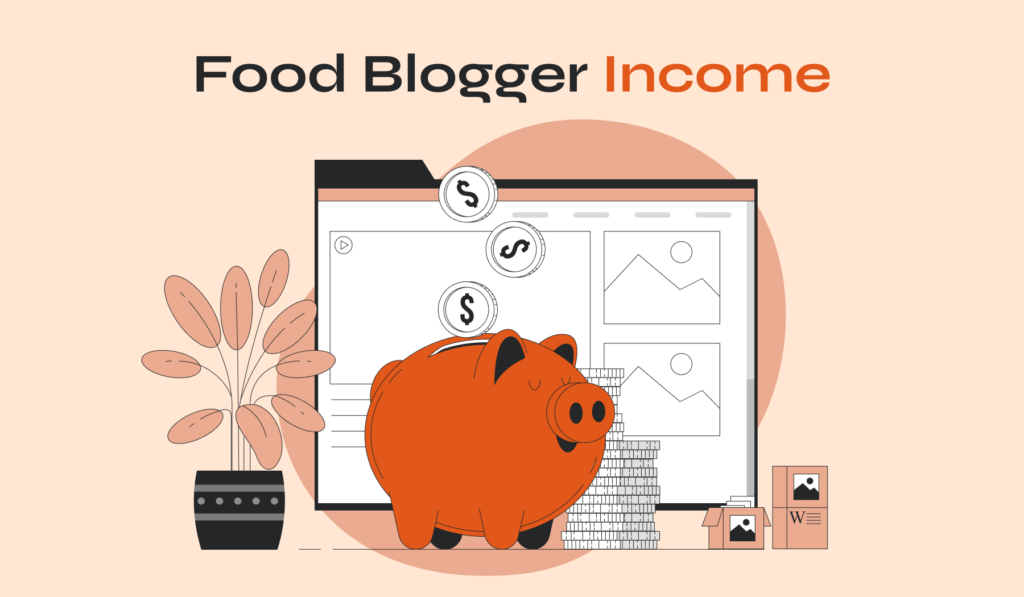
You might already be an aspiring food blogger or you might simply be wondering if you can turn your passion for food and cooking into a sustainable income. That means you are probably curious about what the average food blogger salary is.
How much do food bloggers make , and is there still a way for you to successfully take part in this fascinating phenomenon? We did some research and found some pretty interesting data about food blogger income . Here’s what you should know.
Table of Contents
Do Food Bloggers Make Money?
How much does a food blogger make, how do food bloggers make money.
The short answer? Yes. Some food bloggers can make quite substantial amounts.
There is a very important distinction to be made here: some food bloggers make enough money, while others are struggling to make ends meet.
To make money as a food blogger, you need to have a certain level of dedication. You should have a true passion for food blogging and some culinary knowledge, but you also need to consider thinking about blogging as a business.
There are countless channels for food bloggers to generate revenue streams. However, if you are getting started today, there are certain things you will need to think about in advance.
The number of food blogs already available online is tremendous, which means your competition is going to be substantial in pretty much any niche you would attempt to enter and conquer.
Food blogging can be a lucrative business as long as you approach it the right way, with a good mindset, a strong strategy, and the right tools. But first, let’s analyze if it’s really worth it.
How much do food bloggers make? Well, that depends on a huge variety of factors, ranging from the niche to the entrepreneurial spirit of the blogger in charge.
While there is no actual food blogger salary data available online, there are some statistics we can use as a guide to give you an idea of how much a good food blog can generate in terms of revenue.
As you probably know, there are quite a few different types of food bloggers out there. Whether it’s food critics, technique-dedicated blogs, recipe sites, simple cooking, and posting, or cuisine-specific blogs, there is quite a lot for you to explore. The type of food blog you create will have an effect on the income you will be able to generate.
Food bloggers these days tend to dedicate a lot of energy to educating and helping others appreciate food the way they do. Let’s see how much they manage to get in return.
For that, we will need to look at some of the best food bloggers out there and how they managed to turn their passion into a lucrative business.
Popular Food Bloggers’ Income
While not all food bloggers actually have an income, and even fewer of them can actually make a living exclusively from their blogs, there are some who have managed to turn this into a real and profitable business. Let’s see who the highest-paid food bloggers are and how much they actually make.
Tiffy Cooks
Probably one of the most successful food bloggers out there, Tiffy Cooks shared in one of her posts (back in 2021) that she manages to make around $45,000 – $55,000 each month from her food blog. That is certainly impressive.
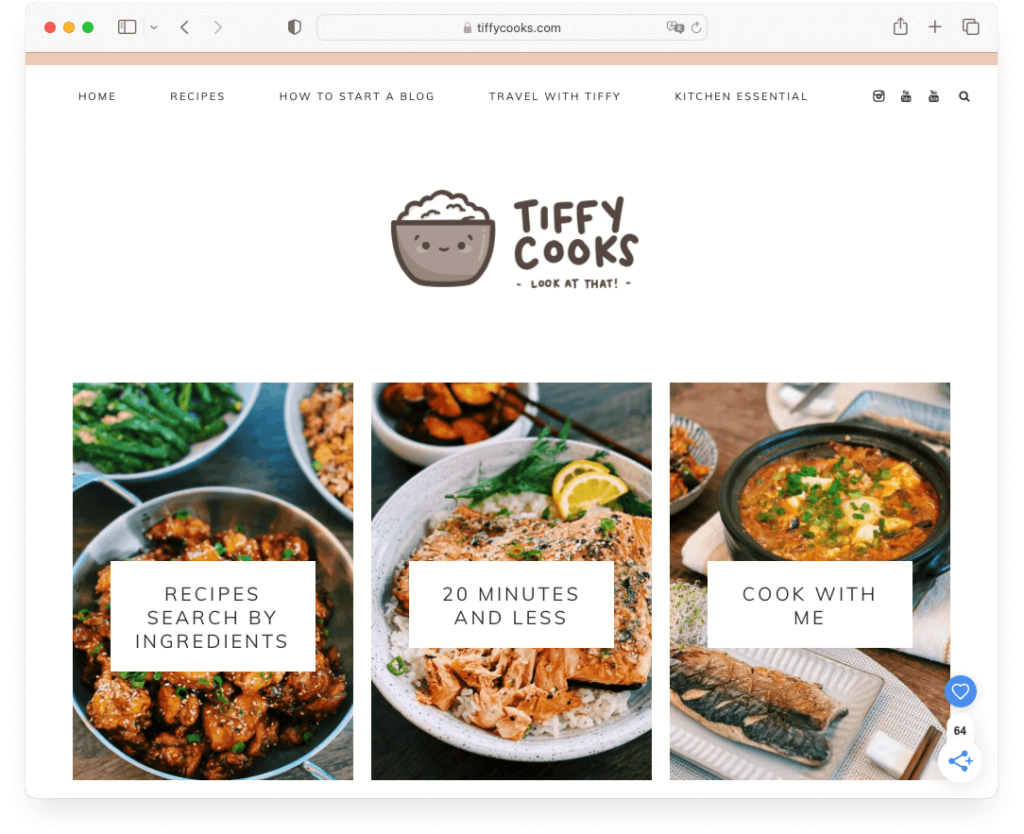
With a mix of Asian and Western recipes on her website and a section dedicated to quick and easy meals, her food blog is a great destination for most food lovers. As an aspiring blogger, you can look at her website as a great example of how to turn your passion into a lucrative business. Ads, social media marketing, different revenue streams, and tons of other clever things have turned this food blog into a money-making machine.
The Clean Eating Couple
The story of Liz and Tyler started quite a while back in 2013. The revenue streams they use differ significantly from other food blogs. They are more focused on sponsored posts rather than ads and the blog is quite a money-maker.
According to a report they made back in 2019, Liz and Tyler earn an average of $150,000 per year from their blog.
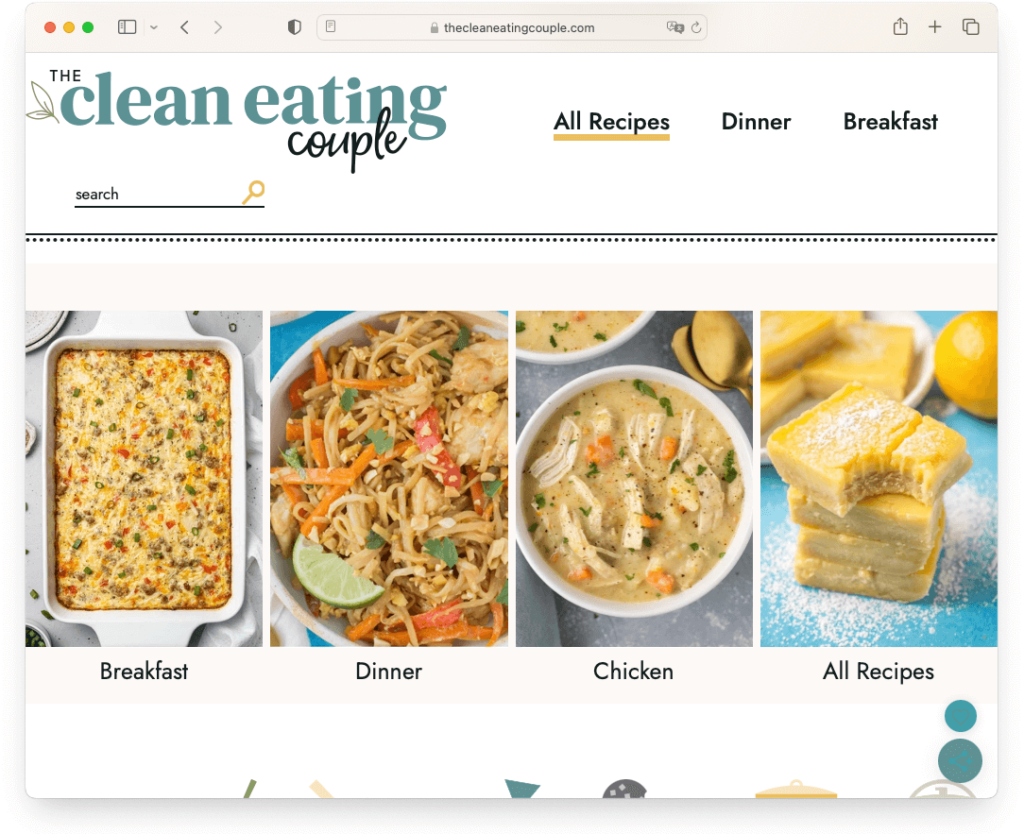
Liz is focused mainly on healthy eating and has decided to share her journey with the general public, being a positive force in the world of nutrition. Most of the highest-paid food bloggers are big foodies and dedicate their efforts to promoting tasty and special foods.
The Clean Eating Couple is a blog dedicated to eating the right way, with your diet and healthy habits as the main focus, and that makes it special.
Stephanie’s Sweet Treats
If food is a big part of our lives, sweet treats definitely have a special place in our hearts. According to her own report from the first quarter of 2022, the blog income ranges from $4,000 to $9,000 per month.
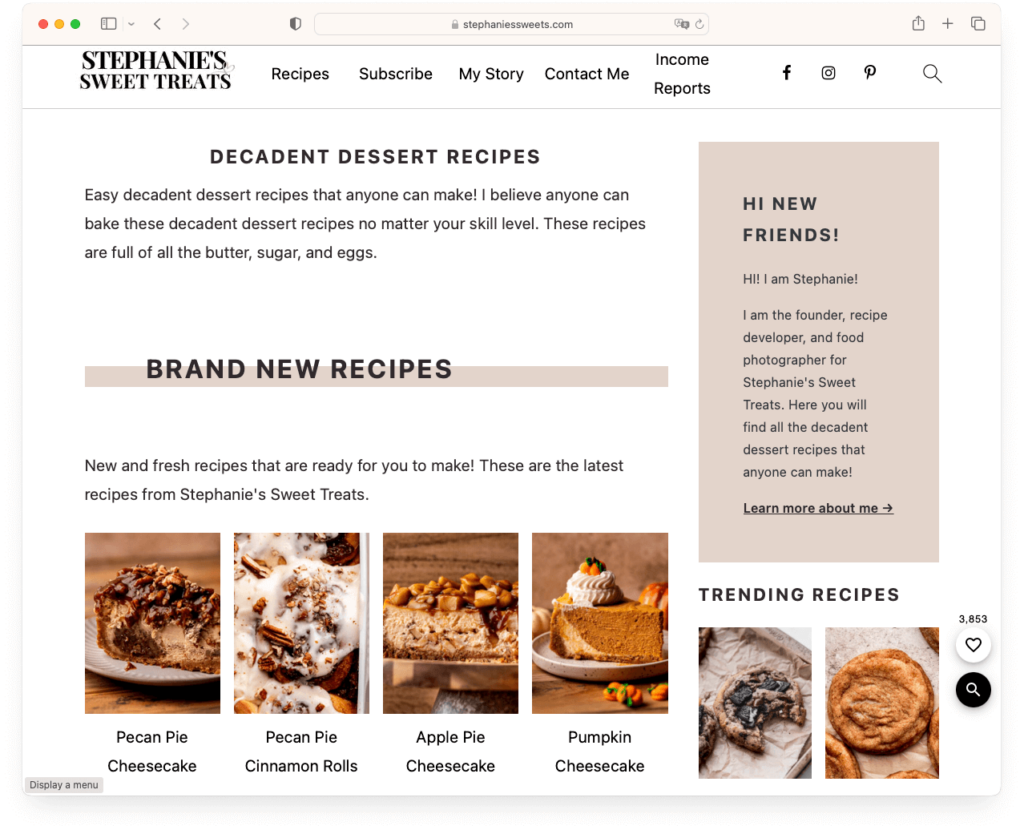
Stephanie’s Sweet Treats is a very well-optimized recipe blog dedicated to everything you can possibly want to know to cook and/or bake if you have a sweet tooth. If you are getting started on your food blogging journey , you can learn a lot from the way Stephany manages her blog.
The Midwest Foodie Blog
With a focus on making things easy for every cooking enthusiast out there, especially aspiring home cooks, this is the result of a food blogger’s very hard work.
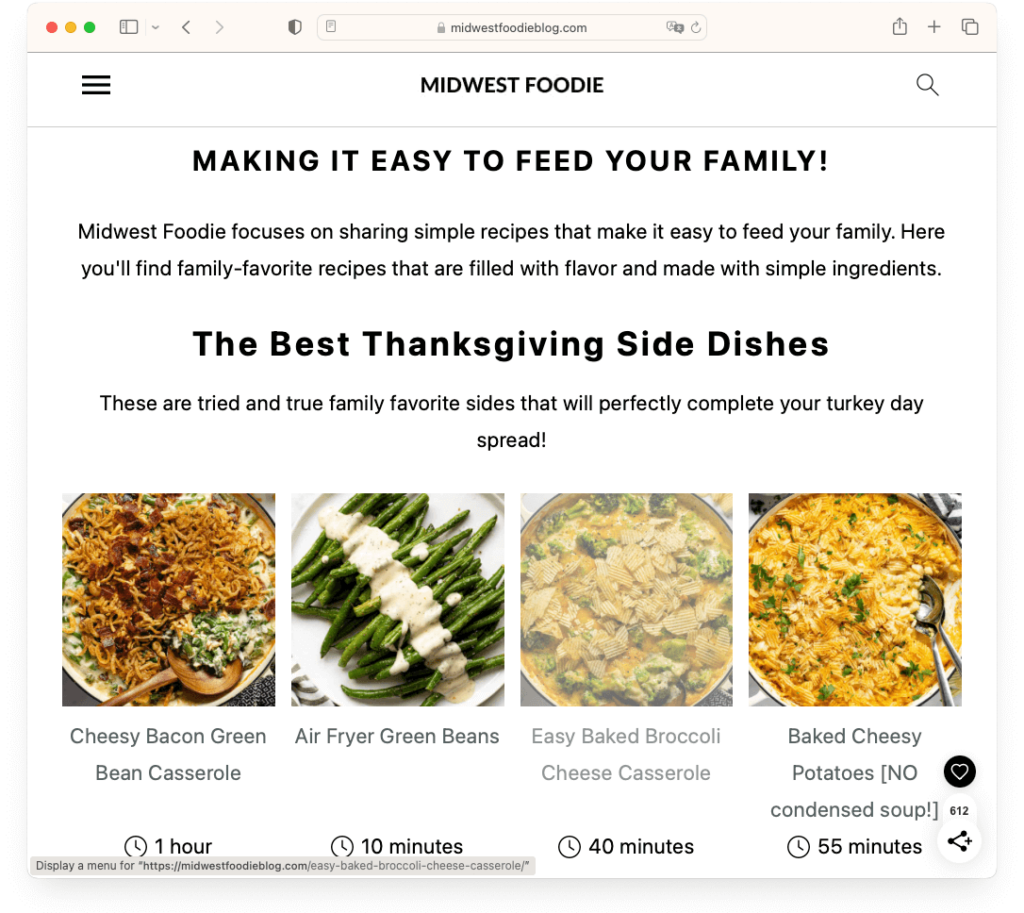
Even though it started as a way to explore her passion for food and cooking, it quickly became an actual business for Kylie. With more than $60,000 in income reported for the first quarter of 2022 , it is pretty clear that she is doing it right.
She benefits from several income streams, which is clearly a smart strategy. Her blog is definitely one that you should follow if you are interested in turning your passion for food into a real business.
Pinch of Yum
Another success story comes from a foodie in the United States of America. Lindsay started her food blog back in 2010 as a hobby, and it slowly grew into a rather huge business.
With a lot of work, a true passion for food, and a business-oriented mind, Lindsay and the team behind pinchofyum.com have managed to turn this into something special.
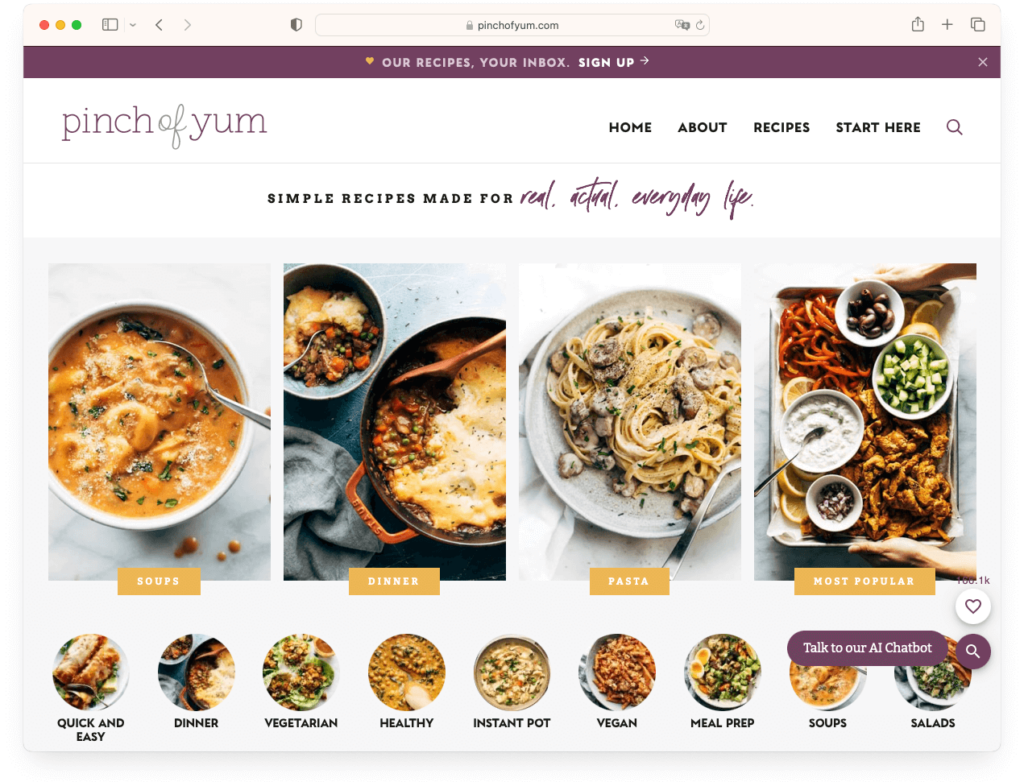
It is now more than just a place for people to find recipes, learn how to cook and follow the life story of the amazing family behind the story.
Pinch of Yum is a business and quite a lucrative one. Over $90,000 from different income streams per month was quite an accomplishment back in 2019, but Lindsay managed to make up to $10.5 million last year, according to a 2023 report .
A Sassy Spoon
A hugely popular blog dedicated to Cuban and generally Latin-inspired recipes, A Sassy Spoon is another example of how a passion can turn into a sustainable income.
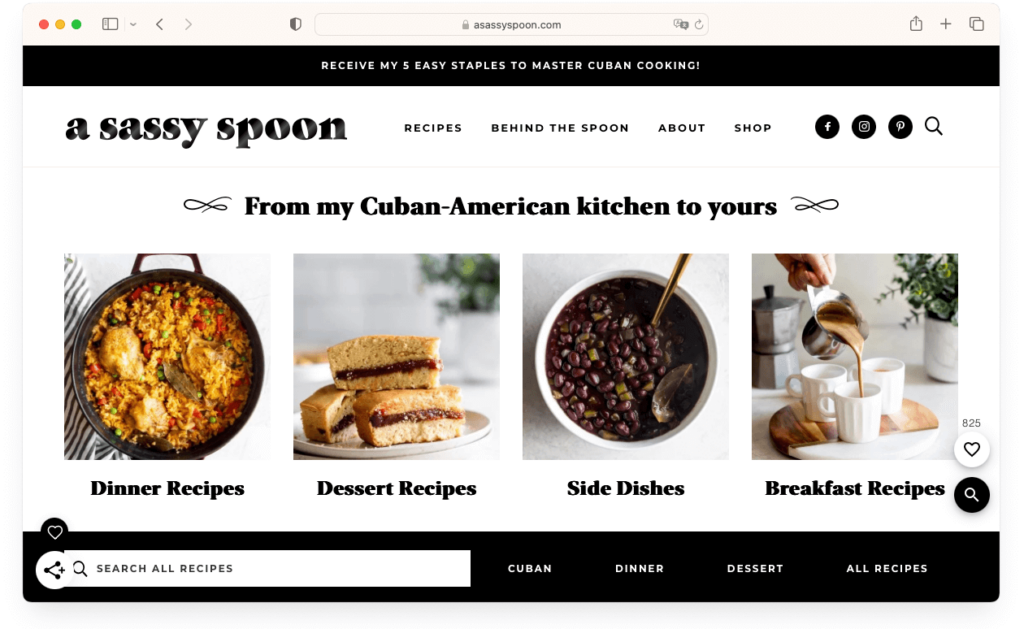
Jamie, the voice, photographer, and mastermind behind the recipes on the blog, started her blogging journey in 2016 and managed to slowly turn it into a business. She makes around $7,000 each month through website ads, brand deals, affiliate marketing, and other sources.
Recipe Tin Eats
Nagi, the creator of recipetineats.com, is by far the most successful food blogger in Australia. She creates her content focusing on traditional Vietnamese and Asian cuisine but approaches culinary challenges from all over the world.
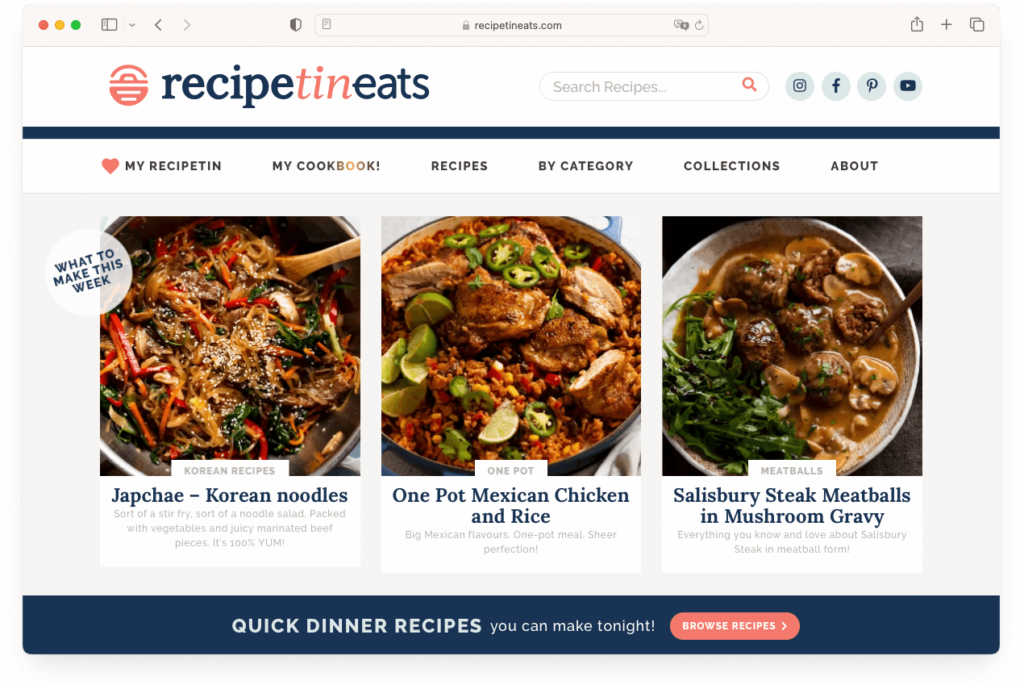
What she is more than anything is a master at generating revenue. With over 1 million dollars in generated revenue over the course of a year, RecipeTinEats is probably one of the best-earning food blogs out there.
Now that you have seen how much food bloggers can make, you are probably wondering how this income is made and what tricks are generally used in order to increase the revenue of food blogs.
One thing you need to know about blogging in general, but especially when it comes to food blogging, is the importance to diversify your revenue streams. There are countless ways for you to earn money and you should always make the best of the opportunities at hand.
Here are some of the most important ways for a food blogger to earn money :
Website Ads
The most obvious way to use a food blog as a source of income is to monetize the traffic the website gets. Website ads can be implemented in a variety of ways, ranging from simply displaying advertising through an ad network like AdSense to actually selling your ad space to businesses on your own.
You can go for display ads, video ads, or any other form of advertising. What is important to know that your website will help you earn money depending on how much traffic you get and what the quality of that traffic is.
Affiliate Marketing
Affiliate marketing is a different way of advertising products on your food blog. This can earn you quite a lot of income, but it comes with an amount of uncertainty.
When you use ads, the amount of traffic you get is usually easy to estimate from one month to another, making it also quite simple to estimate what that traffic will generate in terms of revenue.
When it comes to affiliate marketing, things are a bit different. When using an affiliate platform instead of an ad network, you get paid a certain percentage of the money your visitors spend on different products. For example, let’s say you decide to promote the planetary mixer you are using.
You can do that by getting yourself an Amazon affiliate account and sharing links to the mixer you are using throughout the recipes on your blog. Every time somebody goes on Amazon and buys that mixer through your affiliate link, you get a percentage of that purchase.
Sponsored Content
Depending on the popularity of your food blog, you may be able to make some money promoting sponsored posts.
These can mean quite a wide range of different things. You can post dedicated blog articles describing certain products, promote different brands, or even use the stats of your website to sell backlinks for smaller blogs.
This can be a significant source of income, but it requires a lot of time and dedication to set up and manage.
Selling Cookbooks
A good food blogger with proper following can make quite a lot of money selling cookbooks. Yes, cookbooks are still a thing, despite the fact that you can probably find any recipe you can think of online with ease.
If you are the owner of a food blog in a narrow niche that gets a lot of attention from your readers, you can make quite a splash publishing an actual cookbook. This can be especially true if you like recipe development and you manage to create some unique dishes.
Cooking Classes or Online Courses
An accomplished food blogger can generate consistent income through cooking classes and online courses as well. These days, more and more people turn to home cooking and learning about nutrition. If you are a food blogger looking to share valuable information about cooking techniques, nutrition, and home cooking, you have a great chance to be able to sell your own online courses.
This can be a valuable source of income for your blog, even though it will still not be as reliable and consistent as website ads.
Merchandise
If your fan base gets large enough, you will probably be able to sell personalized merchandise. Whether you do this through brand deals with your partners or sponsors, or if you choose to simply create a brand identity for your own blog, the important thing to keep in mind is that you will probably manage to get a relevant revenue stream from a merch shop on your blog.
Who Is the Richest Food Blogger?
The highest-earning food blog out there is Pinch of Yum. According to a recent report from January 2023, the blog income reached over 10 million dollars last year. While that is clearly a lot higher than any average professional food blogger’s salary, it is still something to aspire to.
Do Food Bloggers Eat for Free?
Generally, no. Food blog income is the only thing you can really count on as a food blogger. You should never expect restaurants or businesses to give you freebies unless you make a clear deal to promote them.
Does Instagram Pay Food Bloggers?
While Instagram doesn’t directly pay food bloggers, you can make a great income as a food influencer or food blogger with Instagram and other social media platforms. Whether it’s through partnerships, brand deals, or simply sponsored posts, there is quite a lot to earn through social media platforms if you have a decent following.
How Hard Is It to Make Money From a Food Blog?
That depends on what your expectations are and what you understand by making money. Making a low but steady income through a food blog is not that difficult. Actually making a living and managing to create a business and a full-time job from your food blog can be quite challenging. There are so many food blogs available online that finding your niche and making a living through your blog can be rather difficult.
Bottom Line
It’s clear that the earnings of food bloggers can vary widely. A food blogger’s earnings are not just a function of their audience size but a result of their strategies, content quality, technical skills, and community engagement. The potential for income is there, but it requires a multifaceted approach and a dedication to the craft.
While the average food blogger’s salary is quite difficult to estimate, the good news is that you can still earn some money from your passion for food. Whether you want to look into brand deals or affiliate marketing, ads, or sponsorships, there are ways for you to monetize your blog if you manage to get enough traffic.
Subscribe to our newsletter
Join 10,000 people. Get our latest news & releases delivered to your inbox.
You have successfully joined our newsletter!
Written by Pavel Ciorici
Owner @ Recipe Card Blocks & WPZOOM
Leave a Reply
Click here to cancel reply.
Let's get you started!
Start publishing your delicious recipes to your site today.
- Used on 20.000+ websites
- Rated 5/5 stars
- New updates every month
- Your Account
- Support Center
- WordPress Hosting
- Recommended Themes
- Facebook Group
- Terms & Conditions
- Privacy Policy
- Business Name Generator
- Brand Name Generator
- Blog Name Generator
- Jewelry Business Name Generator
- Vlog Channel Name Generator
- YouTube Name Generator
- Podcast Name Generator
- Company Name Generator
- Photography Name Generator
- Bar Name Generator
- All Name Generators →
- How to Start a Business Blog
- How to Start a Blog
- How to Start a Finance Blog
- How to Start a Food Blog
- How to Start a Sports Blog: Easy-to-Follow Guide
- How to Make a Wedding Website
- Domain Name Statistics
- How to Transfer a Domain Name
- Choose the Best SEO Name
- Best Domain Broker Services
- .Com vs .Net: Which is Better?
- Make Money Flipping Domain Names
- What is DNS?
- How To Choose a Blog Name
- What is FQDN?
Travel Blog Salary: How Much Do Travel Bloggers Earn?

- September 1, 2023
Wondering what a typical travel blog salary is?
You’ve come to the right place.
The Business Research Company reports that the global online travel agent market share grew from $664.42 billion in 2021 to $761.90 billion in 2022 at a compound annual growth rate (CAGR) of 14.7% [1] Travel blogging is a significant part of the juicy pie—no wonder you are keen to discover travel blog income figures.
This guide will break down the travel blogging salary figures, with as much hard data as possible. You will also get plenty of examples from practicing bloggers along the way.
Let’s cut to the chase.
Understanding travel blog salary numbers
To understand the average travel blog salary, we can look at two types of information:
- Salary reports from platforms like ZipRecruiter and Salary.com
- Income reports from individual travel bloggers
However, it’s important to understand that there’s a lot of variation in the numbers. Whenever possible, we’ll try to present averages. Just remember that there are a lot of travel bloggers earning both more and less than these numbers.
How much does a travel blogger get paid a year?
According to ZipRecruiter, travel bloggers earn $86,518 a year in the United States [2] .
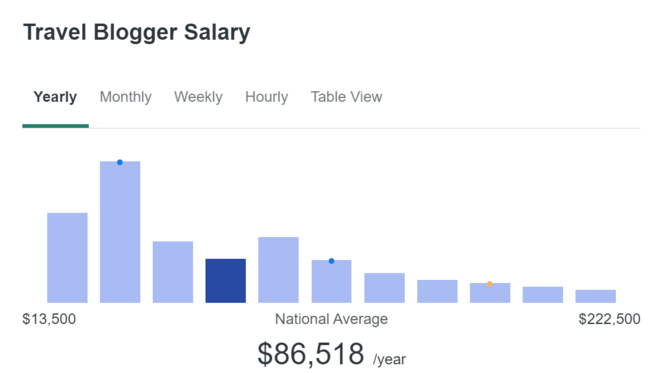
Top travel blog earners go as high as $222,500 annually [3] .
The lowest travel blog salary recorded on ZipRecruiter is $13,500.
New York leads the pack countrywide for travel blogger salaries with a juicy $94,199 annual income.
The New York salary is $7,681 (9%) more than the national average yearly salary of $86,518.
How much do travel bloggers make a month?
Salary.com pegs the monthly travel blogger salary at $3,548 per month or $20 hourly [4] .

In comparison, the ZipRecruiter data shows the monthly salary is $7,209, double the $3,548 average figure presented by Salary.com.
That’s a massive difference. So what’s the real answer?
To better understand what different types of travel bloggers are learning, we can look at some real travel blog income reports:
- Practical Wanderlust blog made $22,000 (or $1,833 monthly) during its first year [5] . Most income came from paid advertising and familiarisation (FAM) trips.
- Two Wandering Soles made $74,000 in Q4 in 2019 [6] . This figure translates to $24,666 per month. Affiliate marketing and paid advertising significantly drove this blog’s income.
- Living The Dream blog generated $5,050 in January 2023, with CPM display ads and affiliate marketing as the major contributors [7] .
- It’s A Lovely Life grossed an astonishing $2,233,236.40 in 2019, with the bulk of the income coming from online courses, affiliate programs, and sponsored posts [8] . This figure comes to a jaw-dropping $186,103 when you break it down to a monthly payment.
- The Travel Mexico Solo blog netted $272,569 in 2022, translating to a significant $22,714 monthly average [9] . Affiliate marketing dominated the earnings, though Mediavine display ads also account for around one-third of the blog’s monthly income.
Once again, the wild differences are apparent. A travel blogger can earn anything from a couple of thousand per month to a six-figure monthly salary for A-list players.
The discrepancy in travel blog earnings shows there is a golden opportunity to make money as a travel blogger. Where you fall in the salary spectrum depends on several factors.
Six details that might affect your travel blog salary
How much you earn as a travel blogger depends on the following:
1. Location
First, where you live affects your potential travel blogging income. Some areas in the country pay more than others because of differences in the cost of living in various states and the maturity of the blogging industry in the area.
Location can also affect travel blog salary in a few other ways:
- Audience location – for display ads, the geographic location of your visitors plays a huge role. Visitors from the USA have the highest CPM rates by far. Countries like the UK, Australia, Singapore, and others sit somewhere in the middle. And traffic from countries like Indonesia or Thailand pays very little.
- Affiliate commissions – for affiliate earnings, the travel destinations that you write about will affect your earnings. For example, let’s say you earn a 5% commission on hotel bookings. Getting someone to book a $300 hotel in Paris, France will pay you a lot more than getting someone to book a $50 hotel in Ho Chi Minh City, Vietnam. Because hotels are a lot more expensive in Paris (on average), it’s a lot easier to generate these high-value bookings.
2. Experience level
Second, the longer you’ve been in the travel blogging game, the more likely you will earn more.
Novice bloggers still learning the ropes earn lower salaries than veteran bloggers who have been blogging for many years.
3. Blogging skill level
Next, highly skilled bloggers engage their audience more deeply than those with average skills.
The more engaged an audience, the higher the chances they will take up the offers made by that blogger, which results in higher income.
4. Commitment level
A full-time blogger who gives their best hours to blogging is probably going to make more money than a dabbler who blogs on the side after knocking off from work.
Generally, full-time bloggers who blog consistently out-earn part-time bloggers who infrequently blog whenever they can.
5. Monetization methods
How you make your blogging dollars determines how much money you make. Travel monetization methods like affiliate marketing and selling digital products like courses can have higher profit margins than pay-per-click earnings methods like Google AdSense.
Similarly, using premium ad networks like Mediavine and AdThrive will pay a lot more than AdSense – but you need to meet the traffic requirements to join these networks.
Speaking of traffic…
6. Traffic size
Last, a blog’s income ties directly to the number of people who visit your site. All things being equal, the Math is simple:
📈 High traffic = high income
📉 Low traffic = low traffic
That’s it.
To boost your travel blog salary, work on the above factors.
How do travel bloggers make money?
It’s all well and good to know you can earn a fat travel blog salary, but the big question is: how do travel bloggers make money? That’s what we will talk about next.
Six simple ways travel bloggers make money
1. sponsored content.
Sponsored content is when companies pay you to write content for them on your blog. You promote the brand’s product or service in sponsored posts. A sponsored post could be a product review or writing about a topic closely related to a problem the company solves and presenting the paying company as the solution.
Global Viewpoint generated $3,000 from sponsored posts in November 2022 [10] .
2. In-content advertising
In-content or contextual advertising involves placing relevant ads in your travel blog posts. You get paid whenever a reader clicks the advert. Some leading ad networks that pay well are Mediavine , Ezoic , AdThrive , SHE Media , and Google AdSense . The blog A Passion With A Passport made an impressive $30,000 in its first year with Mediavine [11] .
3. Affiliate marketing
Another simple way of making cool cash as a travel blogger is selling other people’s products. In the affiliate marketing monetization model, you advertise company products on your blog and get paid a cut for every sale you generate. For travel bloggers, common affiliate products include hotels, tours, transportation, and courses. Blogger Amy Fillinger got a $1,739.51 travel blog salary in June 2022 from affiliate marketing [11] .
4. Selling digital products
Digital products like courses and ebooks are a goldmine for travel bloggers. Online courses, ebooks, and other digital products are lucrative because they have low input costs, so you can keep most of the cash from each sale you make. The It’s A Lovely Life blog made a mouthwatering $1,028,374 from online courses alone [12] . They have a lovely life indeed. 🙂
5. Paid press tips
Paid press trips, aka FAM trips, are another way travel bloggers make money. FAM trips are a double delight. You get paid to travel and/or tour a hotel or any destination and share about the company’s product or service. But they are hard to land, especially if you are a new blogger. Goats On The Road gets paid anything from $500 – $7,000 for a week-long trip depending on the deliverables requested [13] .
6. Selling services
Another common travel blog monetization is selling services. Blogging establishes you as an authority. Travel bloggers cash in on that audience trust by selling services like travel industry social media management, coaching, courses, and ghost blog writing.
How do travel vloggers get paid?
Travel vloggers or YouTubers get paid primarily through monetizing their channels by joining the YouTube Partner Program (YPP).
Vloggers get 55% of the advertising revenue from their channels [14] .
YouTubers earn $1,154 per week or $4,616 monthly on average [15] . Not too shabby if you ask me.
To join the YPP, you must meet two eligibility thresholds:
1. Get 1,000 subscribers with 4,000 valid public watch hours in the last 12 months, or 2. Get 1,000 subscribers with 10 million valid public Shorts views in the last 90 days.
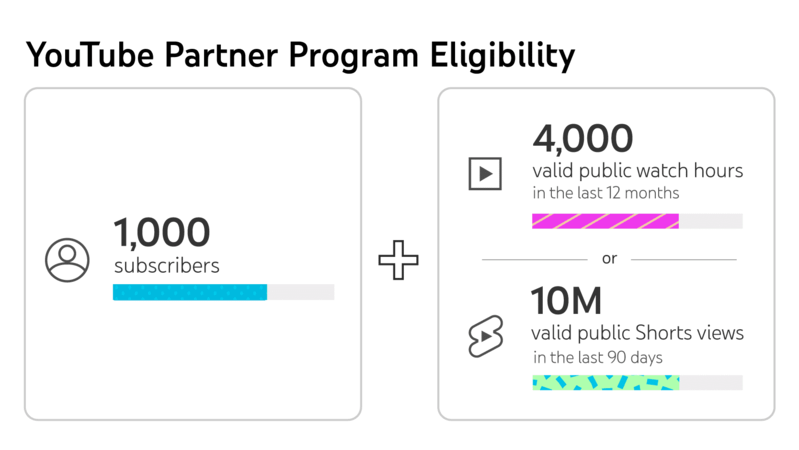
How long does it take for a travel blog to make money?
It takes anything from six months to a year for a travel blog to make money.
It all depends on how much consistent effort you put into your blogging side hustle (or full-time career) and which blog monetization strategies you use.
Fancy a fat travel blog salary? Launch a blog today!
To wrap up, you can make good money as a travel blogger if you play your cards right.
Whether you blog full-time or part-time, you can generate substantial income from travel blogging.
The travel blog salary scale varies widely from $3,000 to over $7,000 monthly. Many established travel blogs earn $100k annually.
These are inspirational figures. You can reap handsome rewards if you put in the work consistently and be clever with your monetization tactics.
So if you’ve been mulling over the idea of generating income, move in for the kill. Launch a lucrative travel blog today.
To get started, name your future travel blog. For practical advice on how to name your blog, you can read our guide on how to choose a blog name . Then you can follow our guide on how to start a blog to launch the actual website.
[1] https://www.thebusinessresearchcompany.com/press-release/online-travel-agent-market-2022 [2] https://www.ziprecruiter.com/Salaries/Travel-Blogger-Salary [3] https://domainwheel.com/how-to-write-a-travel-blog/ [4] https://www.salary.com/research/salary/hiring/travel-blogger-salary?pay=Month [5] https://practicalwanderlust.com/travel-blogging-income-report/ [6] https://www.twowanderingsoles.com/blog/travel-blog-income-report-q4-2019 [7] https://www.livingthedreamrtw.com/income-and-traffic-report [8] https://itsalovelylife.com/online-blog-and-business-income-report-2019-year-in-review/ [9] https://travelmexicosolo.com/scale-your-travel-blog-to-six-figures-review/ [10] https://www.myglobalviewpoint.com/travel-blog-salary/ [11] https://www.amyfillinger.com/june-travel-blog-income-report/ [12] https://itsalovelylife.com/online-blog-and-business-income-report-2019-year-in-review/ [13] https://www.goatsontheroad.com/sustaining-travel/ [14] https://support.google.com/youtube/answer/72902?hl=en [15] https://financebuzz.com/how-much-youtubers-make
Related Posts

Startup Statistics for 2024: Key Facts, Trends and Insights
- February 8, 2024
- Business , Statistics
- 10 min read
Browse the latest startup statistics and learn all about the latest trends, growth, success and failure rates, costs and funding of startups.
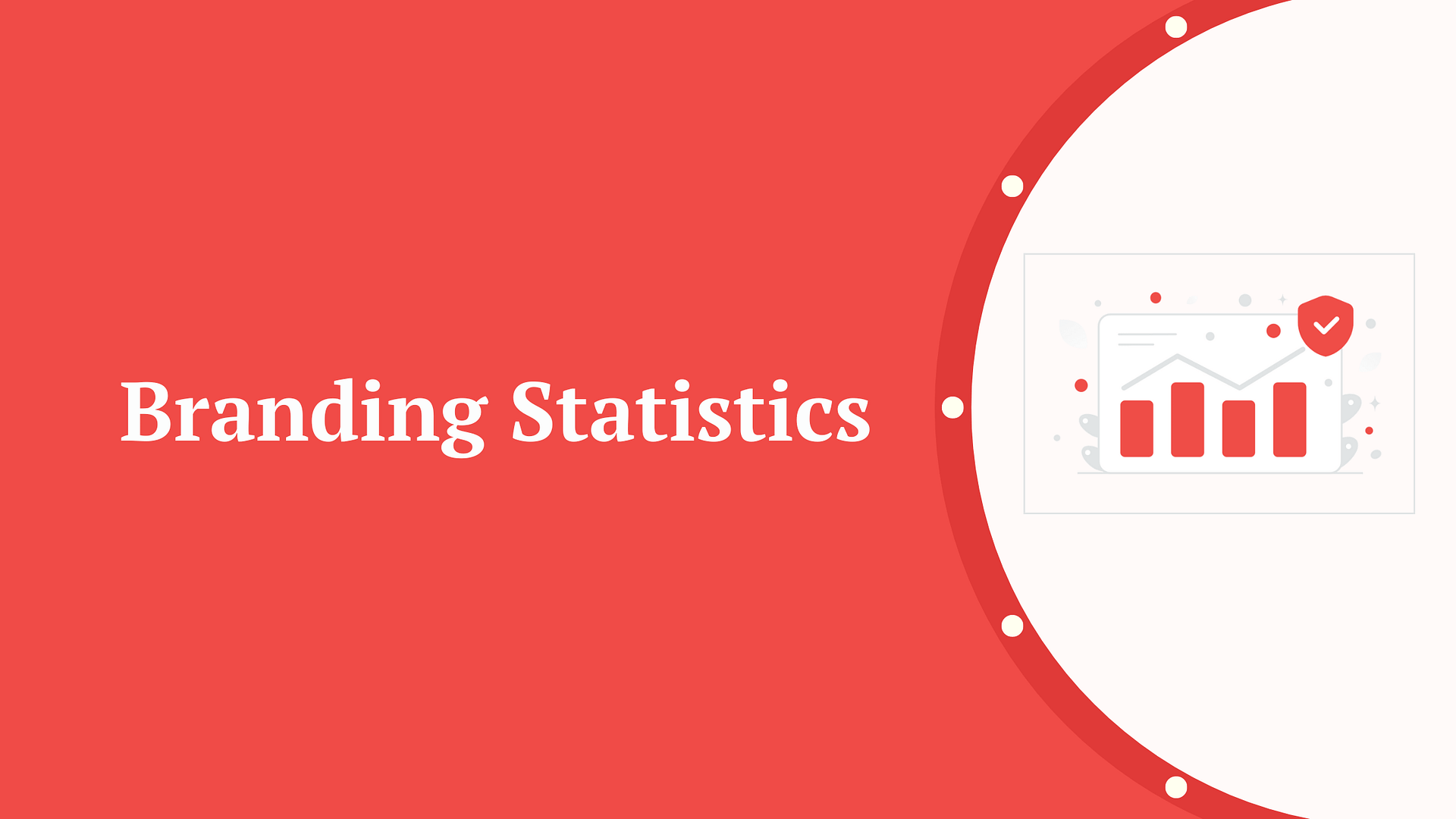
30+ Branding Statistics & Trends for 2024: Top Insights and Trends

- February 2, 2024
- 22 min read
What do we know about branding and its outcomes? We’ve compiled a set of branding statistics to keep you informed on the latest research.
Emma Higgins | 15 April 2015
Get paid to travel – become a travel blogger.
Could you build a successful career as a travel blogger? This expert guide could help you on your way...
Becoming a travel blogger seems like a great idea in theory, but as you get the ball rolling the process can get increasingly overwhelming. To be full time and make a living from your travel blog, it's not quite as simple as just throwing up a few posts and having a Twitter account or Facebook page. Being successful in blogging takes a lot of strategy and good business sense, as well as talent for telling stories and presenting them in a way that inspires people to see the world. From finding your niche to website design, social media tips, and knowing your audience inside and out, this guide is designed to take you from the beginning stages right up to how to make money from your blog, with advice from some of the most successful travel bloggers in the industry.
1. Start with your passion
Consider what you enjoy about travelling – people, food, wildlife, history – and make that the central theme of your blog. Passion is at the root of great writing, and making that shine through in your blog will keep readers interested. Sticking to what you love will keep your enthusiasm and motivation up, too. Remember, you don't have to cover everything about travel on your blog. If you don't go to museums when you're travelling, don't bother writing about them; if you love camping but hate hostels, stick to camping advice. You don't need to catch everyone in your net – do what you love to speak to the people who love it too.
2. Experiment
You might not have a blog topic that you want to fully commit to right away – and that's fine! In these first stages, the most important thing is that you're writing something. Don't be afraid to experiment and play around with different ideas. Write often and about a range of different things – what you find the most enjoyable will quickly make itself known. "Finding your niche sounds really complicated, but it's really just about finding your passion and distinctive voice, and then pursuing that relentlessly,” says Bret from Green Global Travel . “It's OK if you don't find it right away, or if the path meanders a bit along the way. It's more about following your instincts, trusting your gut, ignoring all of the noise that says 'successful bloggers have to do this or that', and blazing your own trail. “It takes time, energy, experimentation, passion, patience and persistence to build a brand you truly believe in. But once you do, it makes all of the other elements that make up the business of blogging fall into place a lot more easily and organically." Bret and Mary from Green Global Travel are some of the industry's most influential voices on the topic of deciding a focus for your blog, having spoken and written about blog branding many times.
3. Put some thought into your design
First impressions are key – and this philosophy also applies to websites. Creating a strong design for your blog – one that's easy to navigate and understand – is important as this is one of your first chances to hook in a reader. And this is the travel industry: visuals are key. Travel bloggers Charli and Ben from Wanderlusters have put a huge amount of work into their own blog design, giving them plenty of top tips to share... “A unique and engaging design can set you apart from the wealth of new travel blogs vying for a place in the industry. Stand out from the crowd with a distinctive logo or cutting-edge blog theme, publish engaging photography and video within your posts, and construct a concise and navigable menu to catalogue your content. “Make it easy for your readers to interact with your articles by activating a social sharing plug-in and commenting system if they're not already implemented within your chosen theme. And put together a captivating ‘About Me’ page to grab your readers' attention and inspire them to follow your adventures.”
4. Identify your audience
Knowing exactly who you want to speak to will help guide your every blogging move – from the kind of stories you're writing and which social networks you're most active on, to which brands you partner with in the future. Having the reader in the forefront of your mind is an effective way to stay focused. I've personally found a lot of success in having a specific idea of my audience for my own blog, Gotta Keep Movin' . My first piece of advice would be to start by asking yourself a lot of questions: How old are my audience? Are they mostly male or female? What kinds of things interest them when they travel? How do they behave on the web – do they like long stories or quick posts? What other travel publications do they enjoy reading? Try to answer questions like these as precisely as you can, and create an ideal reader profile. Use this profile to guide your content, blog design, social media strategy... everything. Your reader should be the first thing you consider when making any decision for your blog.
5. Don't get bogged down in the technical stuff
As you become more experienced with blogging, you'll start to hear words like 'Google page rank', 'affiliate marketing', and 'SEO' (search engine optimisation). Running your own website is quite technical behind the scenes, and that can be overwhelming for beginner bloggers. It's tempting to try to learn it all, but getting too deep in all the technicalities will draw your attention away from your writing and readers and towards Google slavery instead – not a place you want to be. Stay focused on publishing outstanding travel content, but reserve just a small chunk of your blogging time to learn the tricks of the trade. Moz's Beginners Guide to SEO is a strong starting point – work through it bit-by-bit and begin to implement the strategies into your work.
6. Social media
Social media is the means by which you get your content out there, so setting up social profiles once you have a few posts up is key. Dave and Deb of The Planet D were among the very first travel bloggers in the industry, having started their blog in 2008. The adventurous duo have since won awards for their inspiring website, and worked hard to build a huge social media following. “To start building your following, concentrate on quality and consistency”, says Deb. “Don't get caught up in quick ways to build followers, but be patient and let your audience grow organically and naturally. It takes a lot of dedication to get your work noticed on social media: interact with influencers and brands, and consistently share quality information with them. Over time, they will begin to notice your work. “Post daily on Instagram, Facebook, and Pinterest, tweet regularly, and join Twitter chats to meet new people and followers. Post on social media a little bit each day, using scheduling tools like Buffer, Tweetdeak, or Hootsuite to help make it easier. Use insight tools like Commun.it and ManageFlitter (Twitter), Iconosquare (Instagram) and Facebook analytics to learn more about your followers and when they're online. But don't rely on tools entirely – listen to your readers and try new things for yourself, too. “Most of all, have fun with it! Write and share the things you love, and your readers will feel that energy. People want to be inspired – so inspire them.”
7. Be knowledgable and research
One of the most aggravating travel blogging myths is that because it's a less established form of 'new media' and can include a personal perspective, the quality of the content doesn't need to be as polished as a newspaper or magazine. With that outlook, you may as well send the world of blogging down the toilet and flush it away forever. Quality needs to be a top priority, and as the industry is becoming more crowded, it's needed more than ever to make you stand out. Take the time to research the subject you're writing about – look at it like a reporter or journalist would (because you are one, remember?) Be informed and authoritative to attract readers and potential industry partners who trust you as a source of travel information. Assume your readers' intelligence and come up to their level with engaging, useful, and creative posts.
8. Work with the suitable brands
Once you've got the ball rolling and built an audience, you can start thinking about working with other travel brands. Successful partnerships rely on pitching to brands that share your values and travel style, so you have to be strategic about who you choose to work with (instead of taking anything you can get!) Becki Enright has been a consumer brands PR consultant for 13 years, and is also a British Travel Press award-winning blogger for her site Borders of Adventure . Having working in both worlds, Becki has developed expert knowledge in working for and with travel brands. “A professional blog is a media outlet – treat it as such,” Becki explains. “Don’t chase after a brand for a quick freebies, but instead formulate a campaign idea and mutual relationship that has longevity. Make sure your pitch includes a solid overview of how your blog aligns with the client, and that your idea is on-point with the key messages of the destination or product, i.e. don’t pitch for luxury brand if you write about budget travel. “Do your research and know that brand in its entirety: browse their website and social accounts, find previous campaigns, and familiarise yourself with their product – show this knowledge in your pitch. Golden rule: the blog and brand should complement each other, and offer mutual benefit to a shared audience.”
9. Monetise your blog
The big question on everyone's lips: 'How can I make money from my blog?' Money won't come quickly, in huge amounts, or without doing any of all of the above, but it will come if you've taken the steps to create an engaged, loyal audience. There are a number of ways you can leverage that audience in order to make you some cash – affiliates, brand partnerships, freelance writing work, consultancy, creating your own products... to name a few – and the most successful monetisation techniques will always keep that audience in mind. Full-time adventurers Dan and Audrey of Uncornered Market have worked hard over the years to build their blogging brand, allowing them to live off the opportunities their website has lead them to. "We look at monetisation strategically and holistically: monetise not only your blog, but your platform, your brand”, the pair explain. “Take a look at your strengths and consider ways to turn those into income generation opportunities – publish an ebook on a subject where you've got expertise, pursue freelance writing opportunities that fit with your brand so you can use your blog as a portfolio, or pitch partnerships and ambassadorships with travel brands that complement your blog and are a good match with the interests of your audience. “With brand ambassadorships be sure that there is a strong alignment in values between your blog and the company as these are long-term and deep relationships (We've been part of the Wanderers in Residence brand ambassador program with G Adventures for almost five years). Assemble a strong media kit for approaching brands, including not only your numbers (blog traffic, social media statistics, newsletter subscribers), but also your niche/story angles and the products you offer."
Want more travel blogging advice?
The truth about travel blogging get paid to travel - become a travel writer inspirational travel blogs on wanderlust, related articles, looking for inspiration.
Join our newsletter
Get the very best of Wanderlust by signing up to our newsletters, full of travel inspiration, fun quizzes, exciting competitions and exclusive offers.

Travel Blog Salary: How I Made $10,000 This Month

Travel blog salary, ah the most mysterious subject that you could Google. Or at least it seems that way, am-I-rite?
When I first started out in travel blogging, I had no idea how much people could make in this field. The answers that I found online ranged anywhere from $0 to 30,000+ a month. It was hard to get a real sense of how much travel bloggers ACTUALLY make and how much was made up or exaggerated in order to sell an online course or a “This Is How I Got Rich” book.
Talking about salary also feels like a taboo subject. But what I’ve realized over the years is that it only puts us all at a disadvantage by not opening up about this topic and making information available to each other.
Over the years I have been trying to be as transparent as possible by writing about how much van life costs and how we made money living in a van .
In this guide, I shed some light on my current travel blog salary and how much I made this month as an example . If starting a travel blog is something that you are considering, or already have a blog and are interested in how to monetize it, I hope this post can guide you in the right direction. Let’s get started!
Some of the links used in this blog may be affiliate links. At no extra cost to you, I earn a small commission when you book through these links for which I am very thankful!

Is Travel Blogging For You?
Travel blogging is something that I have been doing for 6 years now ( the first two years as a hobby and the last 4 years as a serious full-time job ). It takes a good amount of effort to get a travel blog going and a bit of an investment since you’ll need to fund your travel expenses before you can start making money from your blog.
The first few months of starting a travel blog are always the most exciting . You come up with a concept, and blog name, buy the domain name, build the website, and publish your first post. You’re traveling, documenting, taking photos, and writing engaging posts that you think will be super helpful and everyone will love. Everything is so thrilling and new! Then as time goes on and you keep putting in more hours you start questioning yourself “ Is this really worth it?” and “ Will it ever pay off? ”.

The next period is where your true willpower, focus, and drive will either take over or ( what happens in most cases ) your fire will burn out and you’ll start publishing fewer and fewer posts. Before you know it months will have passed from your last WordPress login.
According to research, about 95% of blogs are eventually abandoned . I get it, I almost gave up too . After two years of not making money from it, I either had to figure out how to make money and keep it going or move on to something else.
While you might think of it as a fun side gig, travel blogging can easily take up 40 hours a week just to publish a few posts so there needs to be a good incentive to keep you going. If you’re not actively researching ways to make money from a travel blog and putting in the time to try various methods, essentially it just becomes a very expensive and time-consuming hobby. This is why most people give up on it after a few years.

If you think about it before you can make money from a travel blog you will:
- Need to travel to locations – which can cost several thousand a month for gas, flights, car rentals, hotels, campsites, entrance fees, food, etc.
- Pay for various software to manage your business.
- Pay for the domain name and website hosting which gets more expensive as your visitors increase.
- Hire help and virtual assistants as your blog grows.
- Invest in travel gear . We can easily spend thousands a year on backpacking packs, tents, sleeping bags, jackets, boots, camping supplies etc.
- Invest in camera gear to create photos for your travel blog and social media channels.
- And have lots of other random expenses.
So is travel blogging easy or cheap? Heck no .
I’m not here to crush your dreams because I honestly love it and can’t imagine myself doing anything else at this point. But the sooner you figure out how to monetize your blog, the more of an incentive you will have to keep going .
This section covers how to start a travel blog. If you already have a website – awesome! Feel free to skip down to the next section.
How To Start A Travel Blog
Compared to other platforms, creating a website requires more effort than opening an Instagram or Tik Tok account. That’s why social media is often the go-to method for income generation for new travelers because it’s free and so easy to set up.
On the downside, most social media platforms peak after several years and are riskier with their constantly-changing algorithms while Google is more steady and will be around for a long, long time.

Before we cover details on how to make money from a travel blog, if you don’t have a website yet, creating a website should be your step #1 . It doesn’t require a whole lot to get a website going except a willingness to learn and a small initial investment. I’ve started and now manage two travel blogs and the setup is one of the most exciting parts of it!
Here are the basic steps of starting a travel blog:
1. Come Up With a Travel Blog Name
Picking the right website name is an important step that you shouldn’t overlook as it will be representative of your blog, brand, and business for many years to come. While you can try to change the name later, I don’t suggest doing that as it can create a nightmare when it comes to website maintenance.
For my second blog, I took a couple of months to brainstorm and write down various blog names before I settled on CaliforniaWanderland.com .

Keep the name somewhat short, keep it catchy and descriptive of your niche or area of expertise. Avoid using words that are hard to spell, numbers and dashes.
2. See If The Domain Name Is Available
Once you have brainstormed blog name ideas, use websites like NameCheap to see if the domain name is available. Sometimes the hardest part of starting a website is finding a name that is not already taken. Only get a domain that has a “.com” at the end and avoid “.net”, “.org” or any other variations.

You can also use websites like DomainsBot to help you find similar domain names that are not yet taken. The DomainsBot name suggestion tool even lets you filter for “.com” names, various keywords, and skip dashes.
3. Choose a Website Hosting Company
Once you have a domain name picked out, find a hosting company to register the domain name and store all of your blog’s data. We personally use SiteGround for all of our websites and have been since the beginning.
The main reason why we picked SiteGround is that it’s made for WordPress, the #1 website builder that 99% of bloggers use. SiteGround has cheap prices, a great user interface, and the best customer service in the industry with 24-hour day service and quick response time. This is very helpful when you’re just starting out!

With virtually zero downtime SiteGround has built a setup that has led to extremely quick website loading times. And their customer service has always been there to help us with any questions.
It costs $17.99/year to register the domain name with SiteGround and around $3.99/month with their StartUp plan to host a small website with around 10,000 monthly visitors. As my websites have grown, I was able to switch from shared hosting to cloud-based hosting for ultra-fast website speed.
Check Out SiteGround Hosting Plans Here
4. Install WordPress
WordPress is a platform that you will use to build your website and upload blog posts. Once you register a domain name and pick a website hosting plan, SiteGround customer service will help you automatically install and set up WordPress with one click.
SiteGround is an expert in WordPress so they will set everything up for you making it super easy. Once you have WordPress installed, you will be able to log into the admin panel and start creating your website content.

In WordPress, you’ll also want to get a few plugins installed that are essentially similar to phone apps and serve a very specific purpose. Keep in mind that every plugin can slow down your site so don’t go overboard. I have about 10 plugins installed for this website but here are a few of the main ones:
- Akismet Anti-Spam – to protect your blog from spam attacks ( which happen quite a lot ).
- All in One SEO – this is a great plugin that can help you better understand SEO. The more you know about SEO, the higher your chances will be of ranking on the first page on Google.
- WPForms Lite – a beginner-friendly plugin that I use for my Contact Us page which is an easy way for readers & companies to contact you. Honestly, most of the time I just get super spammy emails asking me for backlinks (to which I always say “ no thanks “).
5. Pick a Blog Theme
A theme will help you create the design and look of your blog. When it comes to themes, you really have endless options. There are free WordPress themes, ones that charge a one-time fee, and others with monthly subscriptions .
I have used several themes over the years and currently have Astra Theme set up on this blog. It’s very light, fast and does the job well. But this is not exactly a beginner-friendly theme as you will need to create and customize most of the design yourself using blocks.

I don’t have the “ fanciest ” looking blog out there but sometimes overloaded themes can significantly affect your website speed. So while you might pay a premium price for a super-nice-looking blog, people will exit before they see the content if it takes too long to load.
If you’re ever wondering how fast your website is, you can plug in your URL on the PageSpeed Insights website and it will give you a score of where it stands ( keep in mind that if you have ads, lots of plugins, and large images on your blog, your page speed will be highly impacted ).
My second blog California Wanderland has the Ashe Theme . The Ashe Theme comes with a modern pre-made design and requires minimal setup. I just had to switch out some photos & text and was able to get the website up and running in a couple of days.

You May Also Like:
- How To Make Money While Living In A Van
6. Customize Your Website
Once you have the basic layout of the website set up, create an About Me Page , a Home Page listing featured blog posts, Contact Us and Work With Us pages if you plan to work with clients.
I also recommend getting a custom logo done for your website – I had mine created by an Etsy artist for just $15.

7. Create Content
This is by far the most time-consuming part of being a travel blogger. I often travel to a location for just two days and then spend a week creating a blog post around it.
For the past few years, my content strategy has revolved around creating extensive guides 2000 to 3500 words long for a better chance to rank on page 1 in Google. Other people keep their blog posts much shorter and publish content more frequently. You won’t know which strategy fits you best until you publish a few posts and start seeing the results.
And don’t worry about being the “ best ” at anything in the beginning. Yes, you do want to keep improving your skills over time but also be patient with yourself and try to enjoy the learning process.

These are some of the first photos that I uploaded into WordPress in 2016 from our trip to Bali.
Once your travel blog is up and running, your learning curve doesn’t stop there. There is still a lot of work to do if you want your blog to be successful.
8. Learn About SEO (Search Engine Optimization)
Without understanding the basics of SEO, your blog posts will have lower chances of being discoverable. Even a great, long, detailed blog post can tank if you don’t try to optimize it for search engines like Google.
Before writing a blog post, I come up with an idea or a “ keyword ”, I look it up in Google Keyword Planner to see if it’s something people are searching for, and build my blog post around that keyword.

I also use the All in One SEO plugin that has a section at the end of the blog post in WordPress where you can fill in the Post Title, Meta Description, Focus Keyphrase, and see what “SEO score” the plugin assigns you.
You certainly don’t need to get a 100% in every category but it’s a great tool that can help you understand how SEO works when you’re new to blogging.

PS. Keep in mind that this is my basic SEO strategy and there are plenty of experts out there that are way better at SEO than I am.
9. Invest In Photography Gear
While many other blogging niches can get away with using basic visuals or stock photos, travel blogging is all about describing locations and showing how beautiful they are. And the best way to do this is through photography.

You don’t need a fancy camera when you’re starting out – even a small mirrorless camera can do the job well . We used the beginner-friendly Sony a5100 camera for years before upgrading to an expensive full-frame camera.
But if you plan to work with clients and sell your images & prints, you will need to upgrade to a full-frame camera eventually .
We now use the Sony a7c which is the world’s smallest and lightest full-frame camera – perfect for traveling . A full-frame camera creates high-quality images in large file sizes which is the expectation in commercial photography.
10. Promote Your Blog On Social Media
Posting on Social Media is one of the easiest ways to grow a blog – and it’s also free! But social media can take a lot of time, so while you want to be present on social media, make publishing blog content your priority.

If you’re a team of one, it can be hard creating so much content all the time. It’s a good idea to try out posting on several social media platforms to see which ones you like the best, but trying to do them all will also burn you out quickly.
Some of the best social media platforms for driving reader traffic are Pinterest and Facebook . I get around 30,000 Pinterest outbound clicks a month which gives my blog a nice boost in readership.

I use Tailwind social media management tool to schedule all of my Pinterest pins for the week and engage in communities where I re-share content with other travel bloggers.

Tailwind has helped me grow the Fun Life Crisis Pinterest account from a few thousand followers to 134K followers and millions of monthly impressions.
Facebook has an easy post-sharing interface, but it can be very hard to grow a Facebook account without paying for ads. Instagram and Tik Tok are great for going viral and getting sponsored posts, but drive very little traffic to my blog.
My Travel Blog Salary
It might take a year or two to get to a place where your blog posts are well-written, have great visuals, and are starting to get some traction.
So what’s the next step? How do you get your travel blog monetized and start making some money or at least cover your current travels? We’ll dive into that next!
Whether you have an established blog with a large readership, or you’re in the starting phase, one of the easiest ways to make money from a travel blog is by having ads on it . At first, I was very hesitant about installing ads on my blog. But you hear ads on the radio, on podcasts, see them on TV, in magazines, and in newspapers so don’t be afraid to have them on your blog too.
I always thought that as soon as I started serving ads, the readership would tank but quite the opposite has happened. If visitors find your blog valuable, they will try to support it in many different ways.
If your blog is still somewhat small, there are several options on how to install ads on your website:
- Google Ads . I currently have Google Ads running on my newbie blog that has 10,000 monthly page views and earns around $3 a day – just enough to buy a cup of coffee at my favorite coffee shop. While this is not a lot, you just need to start somewhere. Google Ads have low RPM rates ( page revenue per thousand impressions ) but you can start running Google Ads on a blog of any size and start making income. I’m also convinced that Google gives preference to blogs that run Google Ads and rewards you by showing your content more. Maybe I’m wrong but I’ve seen the visitor rates starting to increase with both of my blogs after installing Google Ads. So if you have a small blog, install Google Ads and see if your readership improves in a few months.

- Monumetric . Monumetric is a full-service ad revenue partner that will automate the ad setup and offers good RPM rates. But Monumetric charges a $99 setup fee for smaller blogs with 10,000-80,000 monthly page views and has a couple of month waiting list.
- Ezoic . This is another ad network that can help you automate ads on your website. Ezoic is very similar to Monumetric but is free to join when you have around 10,000 monthly visits. I plan to apply to Monumetric or Ezoic in the next few months with my second blog.
( Note: Since I wrote this post, I did apply to Monumetric with my smaller blog, and from day 1 of acceptance tripled my ad income! )
If your blog is bigger in size, consider applying to these ad management companies:
- Mediavine . I love Mediavine! I have been part of the Mediavine ad network with this blog for over 3 years now and couldn’t be happier. Mediavine is a market leader when it comes to blogging ad management due to its incredible support, customer service, and technology. My Mediavine RPM yesterday was $67 which is unreal for March compared to the $9 RPM I’m getting from Google AdSense with my newer blog. But to join Mediavine you now need 50,000 monthly sessions which can be hard to achieve when you’re just starting out.
- AdThrive . AdThrive is a premium ad network that only accepts websites with more than 100,000 monthly page views. While this blog has over 100,000 monthly page views and I COULD apply to AdThrive, I plan to stick with Mediavine because I just love working with them so much! And I currently earn a 3% bonus for every year that I have been with Mediavine ( bumping up to 4% this year ).
One of the biggest turning points in my blogging career was applying to the Mediavine ad network, being accepted in their program, and starting to run ads on this website. I applied to Mediavine while my husband and I were traveling in our van across the Pan-American Highway just burning through our savings. Having a monthly income from ads helped relieve some of that money stress and continue our travels.
Income from ads also serves as a steady, passive salary . While ad income can fluctuate month to month as marketing budgets increase and decrease, in general, it stays somewhat consistent.
Having a passive income is so great when you’re traveling and don’t have the time or energy to do partnerships or take on clients. It’s a great feeling to wake up in the morning, check my Mediavine Dashboard, and see that I made $200 the day before.

This month I made $5,702.06 from Mediavine Ads and Q1 is typically the “ low time ” of the year.
I’m excited to see where the rest of the year takes us as we bounce back from Covid travel restrictions.
When it comes to blog ads, there are some factors that you can control and other factors that are out of your hands. Typically ad income starts low at the beginning of the year and picks up in revenue towards the end of the year.
Some years don’t always follow this model ( ex. 2020 when many companies stopped advertising due to shutdowns, low revenues, and decreased marketing budgets ). Other years like now are higher than average because the markets are doing well and companies have more money to invest in ads.
Ad income can also depend on how your blog is set up. Here are some things that can bump up your ad income:
- Increase the font size . Larger font means longer read times and more ad money. 18-20px is the recommended font size and this is an easy fix that you can do any time.
- Write shorter paragraphs . In order to serve more ads, you should have shorter, more frequent paragraphs. I usually keep paragraphs 2-4 sentences long. This also makes it easier for visitors to read posts as most people skim, not read everything word per word (unless you do, in which case – I really appreciate you! ).
- Promote “related posts” . If one reader visits two pages, that doubles your income vs if they immediately exit after reading a post.
- Don’t run AMP on your blog . One year I added AMP as an option in my blog which is a mobile-friendly way to show blog posts to increase speed and viewership. But AMP posts rarely show ads and have a low payout. So while my readership doubled, my income plummeted.
- Analyze which posts do well . After a few months of running ads, I looked to see which blog posts have the highest CPM rates ( how much the advertiser is willing to pay for 1000 impressions ). I realized that some of the highest paying categories are car and van posts, gear, California, Hawaii, Oregon, and Mexico-related travel posts so I started creating more material around these subjects.
- Add a video player . If you’re part of an ad network and they offer a video player option, opt into it! My income increased by 30% after adding a video ad that Mediavine offers. Sometimes it’s not about reaching more readers but figuring out how to increase the value of your existing readers.
Ad income this month from Fun Life Crisis travel blog: $5,702.06
Ad income this month from California Wanderland travel blog: $90.51

VAN LIFE – How Much Does It Really Cost?
Partnerships, Collaborations & Sponsored Posts
Doing sponsored posts is one of the most common ways that influencers make money, especially on platforms like Instagram and Tik Tok.
Some sponsorship examples for travel bloggers include:
- Tourism Boards
- Travel-related products
- Tour agencies
- Gear companies
- Clothing companies

I’ve done a fair share of sponsorships over the years and can tell you that sponsored posts are a lucrative way to make money, but certainly not passive .
The moment you sign up for a partnership you are committing to:
- Strict deadlines
- Lots of back and forth emails
- Negotiations & contracts
- A list of requirements of what is expected of you
Companies and brands want to make sure that they will receive plenty of exposure & material so there will be lots of work involved.
When I first started I completely undersold myself and took on partnerships, even if they didn’t pay that well. This is fine if you’re just starting out and want to get a feel for how partnerships work, what is expected, and build a client base. But as your audience and skills grow, don’t undersell yourself and adjust your prices accordingly .
After taking on a few partnerships I realized that I was spending more money on gas driving to their preferred locations, paying for flights, hotels, and buying outfits than I was making in income from the partnerships. And it was taking away time from creating content on my blog or researching other ways to make passive income so the cost of those partnerships was much higher than I accounted for.

Now I only take partnerships for products that I love, think my audience would enjoy reading about, and have marketing budgets to compensate appropriately for my time and travel costs.
If you’re taking on a partnership in exchange for a free product keep in mind that YOU might end up paying for it in other costs like travel and time.
A travel blog is an expensive business to run. Now I have many monthly costs that I have to consider too. Just like any other business, I could not operate if I gave away my time for free.
Partnership income this month: $3,200
Affiliate Marketing
As a travel blogger and business owner, you should never put all of your eggs into one basket. Having multiple income streams is key to lowering your risk in case one of them abruptly ends . I have lost all of my income by focusing on just one platform in the past and it’s not a great feeling when your income plummets to $0 (like when my Instagram account got hacked and deleted ).
Even blog ads can still be affected if your website hosting goes down, Google stops indexing your blog posts, the world shuts down during a pandemic, companies reduce spending, etc.
If you want to diversify your income like a healthy 401K portfolio (which I just started investing into again since I left my 9-5 job so don’t even get me excited! ), look into creating various streams of income.
Affiliate marketing is another source of income that is easy to start even for new blogs with small readerships.

But while affiliate marketing is a passive source of income ( once you add a link, it could make you money for years ), I find it less reliable than ads. Affiliate programs can shut down without any notice ( ahem Airbnb ) leaving you with a lot of links on your website promoting products that don’t make any money for you.
When it comes to affiliate marketing, it’s best to try out a few different programs and see which ones readers are interested in, have decent affiliate commission rates, have good customer service support, and pay on time.
Most programs require you to reach a certain threshold until you can get your first payment. It can feel like your money is being held hostage despite having done all that work. Just be patient and keep working at it and before you know it, you will reach that threshold.
Here is my affiliate income breakdown for this month:
- Amazon : $333.05
- AvantLink : $78.27
- Skimlinks : $115.71
- CJ : $185.30
- Booking.com : $156.96
- Get Your Guide : $7.41
Some of the above affiliate programs such as Amazon, Booking.com and Get Your Guide are partnerships that you will need to apply to direct and keep track of earnings on their dashboards. Keeping track of affiliates can get a bit difficult if you’re part of many different programs.

Another option is to go through affiliate advertising companies such as AvantLink, Skimlinks , and CJ which require one application and have many different affiliate partners.
If you’re new to affiliate marketing, I recommend Skimlinks network because they make it very easy to get started, have a user-friendly reporting dashboard, and offer an extensive list of merchants to work with.
My goal for this year is to continue investing time in affiliate marketing. Currently, my affiliate income makes up a small portion of my monthly income and this is something that could be improved significantly.
Affiliate marketing income this month: $876.70
Image Licensing
If you excel in photography, selling your image licenses to companies, brands, magazines, and book publishers is a great way to make a side income.

Many companies outsource images so they don’t have to organize and pay for their own photoshoots and can instead use existing images from photographers found online.
Your blog and social media accounts can serve as a portfolio for potential brands & companies looking to outsource images.
Most of my image licensing gigs now come from my blog. A lot of times I get approached when someone finds my image from doing a Google image search on a certain subject and wishes to incorporate it into their own product, website, magazine, or book.

There is a fair amount of work that goes into creating content so you should not be giving image licenses away for free. You could end up spending hours re-editing the image and sending back-and-forth emails until you get a final product a company likes and approves of. You can also offer bulk image packages since in many cases companies are looking for more than 1 image to use.
Image licensing income this month: $576
Total Travel Blog Salary This Month
Well, there you have it! Here is the breakdown of my income for this month:
- Ads from Fun Life Crisis travel blog: $5,702.06
- Ads from California Wanderland travel blog: $90.51
- Partnerships: $3200
- Affiliate marketing: $876.70
- Image licensing: $576
Total Travel Blog Salary This Month: $10,445.27
Keep in mind, that this is a one-month income example. When running a travel blog, your income is never guaranteed and it’s up to you to put in the work, learn, grow, apply new ideas, improve the existing ones and keep going.
At the beginning of the year, I like to write down what my expected income goals are for that year, what that breakdown looks like for each income stream, and start working on those categories. It’s important to be steady, persistent, and consistent while pursuing your goals!
When I first started, my goals were much smaller and more realistic. At first, I was reaching for $2000 income per month, then increased it to $5000 and then $10,000. It’s important to keep raising the bar and trying to live up to the challenge but also give yourself a big pat on the back when you reach your next threshold.

Travel Blog Costs
It’s also important to note that not all of this income ends up in my pocket and there are plenty of costs associated with running a travel blog.
Just to give you an idea of what those costs were for this month:
- Travel : $727.42. This month we only went on two short camping trips so our travel cost was much lower than typical. Usually, our travel costs average around $2,000 per month for gas, flights, rental cars, hotels, campsites, travel food, permits, activities, and entrance fees.
- Contractors, VA’s, and writers : $528.62. While I still manage my travel blogs mostly by myself, over the years I have tried to outsource some parts of my business because it’s just impossible to do it all yourself. For me, that mostly includes finding writers for specialized subjects and virtual assistants to help manage some of the busy work. This cost can also vary from month to month. After spending a lot on writers for year-end, I have been cutting back in Q1.
- Office expenses : $166. This includes the cost for various software like Tailwind , Adobe Lightroom, Planoly, internet, and phone.
- Web hosting & domain name : $75. This can get expensive, depending on how much traffic your blog receives. I recently had to increase my SiteGround plan (which is truly a good thing since that means we’re getting more visitors!)
- Coffee shops : $64.16. Lately, I’ve been enjoying working in coffee shops in the mornings. After covid shutdowns it’s nice to put on jeans instead of sweatpants, go out in public and feel like a normal social person again.
- Equipment & gear : $183.33
- Business license : $100/month
Total travel blog expenses this month: $1844.53
Note that this does not include other living costs like rent, food, clothing, pets, medical bills, or just the insane general cost of being a human adult in 2022 with the rising inflation. We also happen to now live in one of the most expensive California coastal cities and we spend $2800 of our income on rent.
I miss the days when we lived in our campervan and paid $0 for rent but after spending 15 months on the road, it’s also nice to have a permanent home base for a change.

What’s Next
My goals for this year are to expand my income by writing about subjects with high CPM rates, keep testing different affiliate programs and incorporate a product or a shop into my website. I have some fun ideas for van life products but I need to carve out time from a busy schedule to look into it creating them.
One of my main goals is to get my second website to 50,000 monthly sessions and apply to Mediavine. I haven’t invested a whole lot of effort into social media for my second blog which might be the reason why it’s not growing as quickly. It’s impossible to do everything by yourself and I’ve been stretching myself pretty thin over the years trying to do so.

I hope this guide has helped shed some light on what type of income you can expect to make from a travel blog. Keep in mind that I’ve been managing my travel blogs for several years now so it’s not something that happened overnight . I spend A LOT of time creating content, sometimes working until late hours and on weekends too.
Travel blogging is a field that requires constant monetary and time investment. Many travel bloggers get burned out from this constant “ go-go-go ” lifestyle so that is something to keep in mind for your long-term goals.
Working on a travel blog can also take away some of the enjoyment from traveling itself because it becomes full-time work, not just a fun thing that you liked to do in your free time. Now when we travel we spend a lot of time:
- Doing research
- Taking photos
- Writing notes
- Editing photos
- Posting on social media
- Creating blog posts
- Replying to comments
- Keeping up with website maintenance
BUT I love travel blogging! I enjoy the creative aspect of it, the challenge that it brings . It gives me a thrill and excitement every time I push that “Publish” button. And I doubt that I would be able to make this type of salary if I stuck to my old 9-5 accounting job.
I hope to continue working on my travel blogs as long as I can earn a decent income from it, pay my bills, and feel happy about the work that I am doing.

Recommended Travel Blogging Tools
- SiteGround . We use SiteGround to store all of our website data. SiteGround has excellent customer service, affordable prices, and a great user interface.
- NameCheap . NameCheap is where you can register website domain names. I recommend getting a domain that has a ‘.com’ at the end and avoiding ‘.net’, ‘.org’, or any other variations.
- Rank IQ . If there is one blogging tool that you should invest in, it’s Rank IQ. This tool makes keyword research so easy by giving you all the top-ranking keywords for every niche on a silver platter. I also love the Rank IQ content grader feature that shows how to improve your blog posts to rank on Google’s Page 1.
- Tailwind . Tailwind is a social media management tool where I schedule all of my Pinterest pins for the week.
- MailerLite . MailerLite is a budget-friendly email marketing service that is free for up to 1000 subscribers and comes with beautiful preset email templates.
- AIOSEO Plugin . All In One SEO plugin has a handy section in WordPress where you can fill in the Post Title, Meta Description, Focus Keyphrase, and see what “SEO score” the plugin assigns you.
- Canva . Canva is great for creating eye-catching visuals for social media. Canva has a free version that is easy to use and comes with excellent templates.
- Grammarly . This is software that checks for spelling, grammar, and punctuation errors – a must-have for bloggers!
Recommended Travel Camera Gear
Interested in stepping up your photography game? Here is the camera gear that I carry everywhere I go to create amazing travel photos:
- Main camera: Sony a7c Camera . The Sony a7c is tiny, light, full-frame, durable – in other words, amazing!
- Polarizer Filter: Hoya 40.5 mm Filter . Polarizing filters reduce glare in water, protect the lens from getting scratched and bring out the best colors when it’s bright outside. Having a polarizing filter is a must-have if you plan to photograph lakes, oceans, rivers, and waterfalls.
- Wide Lens: Sony 16-35 mm F4 . Great for capturing wide panoramas, nature landscapes, and cramped city streets. Mounts to any Sony mirrorless camera and features autofocus, image stabilization, and incredibly sharp images.
- Lightweight Travel Tripod: Manfrotto Carbon Fiber Tripod . A good tripod is essential for capturing images in low light conditions, such as during sunset and sunrise, or creating smooth water effects when shooting waterfalls. The Manfrotto Carbon Fiber Travel Tripod is very sturdy, light, and folds small so you can take it on all of your adventures!
- Memory Cards: SanDisk Extreme 256 GB . It’s always good to bring a few extra memory cards on trips. SanDisk Extreme is ultra fast for capturing high-quality images, bursts, long exposure night shots, and 4k videos. This memory card is also durable and reliable yet very affordable.
- Camera Batteries: Wasabi Power Battery Set . I’ve made the mistake of getting to a location to realize my camera is out of battery. Always keep your batteries charged with this camera charger set!
- Camera Bag: Lowepro adventure shoulder bag . A camera bag is something you should definitely invest in! Without having a proper place to store it I would get my camera scratched, sandy, or even occasionally drop it.
Looking for more tips & inspiration? Here are a few of our other popular blog posts that you may like:
- 12 Proven Strategies On How To Promote a Travel Blog
- 15 Essential Travel Blogging Tips To Know For Beginners
- How To Write a Travel Blog That Ranks
- 15 Traveling Tips For Van Life Couples
- The Ultimate Solo Female Van Life Guide
Pin it for later!

Related Posts

Review Of Jackery Explorer 1000

15 Best Campervan Conversions

Tips For Van Life With A Cat
2 thoughts on “Travel Blog Salary: How I Made $10,000 This Month”
Hi Laura! I was just reading through your blog, and you have some very helpful insight on how you make it all work! I was google searching “What to do after being a carpenter” as my body is sure taking a toll. It’s not a sustainable career unfortunately.
I travel a fair amount, and shoot photography as some side income. However, I really slack on the social media aspect of things. I see that it IS possible to travel, and shoot photography full time which has been my long term goal. Sounds like a ton of work, but nothing comes easy! Thanks so much for sharing your wisdom, travels, and photography. You’re living the dream -Zach
this was a great write up! thanks for being so transparent on all your costs and income!
Leave a Comment Cancel Reply
Your email address will not be published. Required fields are marked *
Nomadic Matt's Travel Site
Travel Better, Cheaper, Longer
9 Ways to Become a Successful Travel Blogger

I generally don’t write articles about how to be successful at blogging because this is a consumer travel website — not a blogging website. But I’ve seen a lot of articles on travel blogging over the years and many of those articles offer a lot of just plain ole’ bad advice.
As someone who has been blogging – very successfully – for over fifteen years , I want to share my advice on what has worked for me to counterbalance what I see is bad strategy by others.
Travel blogging is a crowded field — and it gets more crowded by the day. After all, the idea of “getting paid to travel the world” seems like an amazing thing to try to do. You get to visit wonderful places around the world on someone else’s dime!
It’s a dream job, right?
Well, first, running a successful travel blog — or any blog in any industry — is hard work and time-consuming. Putting posts up is not going to result in money falling like rain (though judging by some of the people I’ve seen on paid trips, it can at least amount to a drizzle). You have to work for it.
Blogging takes persistence. It takes consistency.
Unless you hit the Internet “viral” lottery, you should expect to plug away for a least a year before you start to see income coming in. Usually longer.
Building a blog is like building any other business: success takes time, patience, and dedication.
Think of travel blogging like the restaurant business. Just because there are a lot of restaurants doesn’t mean that they are all good or that you shouldn’t open one of your own! Instead, people who open a restaurant or desire to be a world-class chef look around and say, “I can do this better .”
That’s the mindset you should have about your travel blog.
Take a look around and go, “I can do this better!”
Here are nine things you can do to succeed in travel blogging (or any blogging field, really). Doing them will make you far more successful than most of the bloggers out there. The stuff below is what I do to grow this website.
1. Read a Lot of Books
I am always shocked at how few travel bloggers read. Very few read any marketing, strategy, business, or self-development books. Running a blog is like running a business, and if you don’t go to “school” and constantly learn, you’re going to fall behind. Every successful person I know is a voracious reader. They constantly try to improve their skills and knowledge.
You must always be a student. You must always learn. After all, why reinvent the wheel?
Read what experts have to say, learn what works, and apply the tips you pick up to your blog. If someone has been there and done that, why try to learn that through trial and constant error? Read the best way to do it… and then do it!
I read a lot besides travel books. I consume books on marketing, management, writing, history, and biographies. Even if you only get one idea from the book, that book was worth it. I read at least one book a week and am often reading multiple books at a time. Travel, history, business, fiction — I read it all.
If you only do one thing from this list, make it this one.
Some of my must-reads are:
- Influence , by Robert B. Cialdini
- The 7 Habits of Highly Effective People , by Stephen R. Covey
- What Got You Here Won’t Get You There , by Marshall Goldsmith
- The Psychology of Persuasion , by Kevin Hogan
- Start With Why , by Simon Sinek
- On Writing , by Stephen King
- Lonely Planet’s Guide to Travel Writing , by Don George
- Big Magic , by Elizabeth Gilbert
For more book suggestions, here is my complete list of must-read books for bloggers!
2. Be Like Apple — Think Different
Whatever you are going to write about, try to present that subject in a way that hasn’t been done before.
If everyone is sharing sponsored content, don’t.
If everyone is writing text, make a video.
If everyone is serious, be funny.
If everyone has complex designs, go simple and visual.
If everyone is doing one-off blog posts, create a story through a series of posts that keep people coming back for more.
Always innovate — do something different and unique.
One thing we do here that makes us different is that we put a level of detail into our posts that no one else does. We make our posts the ultimate guides on destinations. We add photos, charts, and maps when we can. We add video. Contact information. We want you to come here over and over again because our resources are the best.
Many bloggers just provide a light dusting of information. We go deep.Whatever you decide to do, do it well and be unique.
3. Invest in Your Blog
For a long time, I avoided spending any money on this website. I bootstrapped everything and viewed every expense negatively. “That designer would be nice but I can’t afford it. I’ll just create a crappier design myself.”
But I soon realized money spent wisely is an investment.
Now I pay for designers, SEO auditors, conferences, video and audio editors, copy editors, and much more. This allows me to improve the reader experience, develop useful products, work on other projects, and free up time to write. I focus on my core competencies and hire the rest out.
It’s easy to say, “Oh, that conference is too much. I don’t want to spend that much.” But if that conference results in one strong business connection that leads to new sales or a guest posting opportunity, then the conference is worth it. (See below for some good conferences to attend.)
Businesses invest in themselves. You need to do the same.
It can be easy for me to say now, but even when you start, spending a little bit of money can go a long way. I didn’t start out hiring lots of people. I hired one person, then another, then another. Even if you spend a few hundred dollars on a snazzier logo, that can go a long way to improving your readers’ experience.
4. Be Niche
Back when I started blogging in 2008, it was easy to maintain a general budget travel website. You could cover a wide range of travel topics and face little competition. There was only a handful of bloggers. Now, there are too many long-established blogs and websites to do that. (And you’d also be way behind in Google search results.)
I recommend being as narrow and focused on your topic(s) as possible. Whether it’s RV travel , hiking and camping adventures, vegan travel , or focusing on a specific city or country, the power of search lets everyone define their niche and still be able to reach millions of potential readers. In fact, being niche now is better than trying to be a more general resource site like mine.
Moreover, focusing lets you become an expert. You can be the person to whom readers always turn for information on this subject or that destination, which allows you to cultivate a bigger presence online.
Don’t try to be everything to everyone. Go narrow. Go deep.
5. Create Products
Businesses sell something — and so should you. Whether it’s a course, a book, t-shirts, tours, other people’s products via affiliate marketing, or by creating a Patreon, give your audience an opportunity to support your website.
Offering products for sale allows you to be independent from sponsors and brand deals and not compete with other travel bloggers for spots on press trips (see below). It allows you to scale your website and your revenue. Many products offer value to your readers by going more in-depth and in detail than a blog post usually allows.
There are very few travel bloggers that produce products. Most of the time, travel bloggers end up making money by creating sponsored content and getting paid to go on trips. That’s cool if that is something you want to do, but that is time-consuming and requires you to be constantly working (and it’s soul-sucking). You never have time to relax or do something for yourself. It’s not a hamster wheel you want to be tied to. It’s not sustainable.
Products allow you to create something once and earn revenue while sleeping, sightseeing, or getting a suntan on a beach! They give you ownership of your income and a chance for your readers to buy something from you and give back!
Trust me. Your readers want to support you. You just need to give them a way to do so.
6. Don’t Only Do Press Trips or Sponsored Content
Why do people still buy guidebooks? Because they want an independent opinion on destinations. If everything you write is sponsored by someone, you’ll hit a limit to your number of readers.
Sure, some people won’t care and will follow your adventures no matter what, but a larger majority of people will feel that you can’t relate to their experience and will seek to find information elsewhere.
Consumers want relatable and independent travel content because they want to learn that they can make it happen too. If you’re in fashion, you can showcase all the makeup you want because a reader can look at that and think, “Yeah, I can do that too! To the mall I go!”
But when you’re talking travel, people can’t look at your free, multi-thousand-dollar trip to the Maldives and say, “Yeah, that’s realistic for me too! To Expedia I go!”
Think about it. When you see someone having a $10,000 holiday, how do you feel? Do you think “Wow! That’s pretty!” or “Wow! I can do that too! I’m going to book that!?”
Sponsored trips and one-off brand deals will help you travel and provide eye candy for your readers but it won’t create the expertise and relatable experiences that will have them coming back to you over and over for concrete advice or product purchases.
I’ve yet to see a pure travel blog get huge by only taking sponsored trips (though there are a number of fashion/travel hybrid blogs that are gigantic). The most successful bloggers in many niches avoid one-off partnerships and sponsored content because it dilutes their authenticity. (On the other hand, long-term partnerships are wonderful as they can bring value and unique deals to your readers.)
Avoid too many one-off trips paid by someone else, write about relatable experiences, and grow larger!
(And when you create products, you don’t need the money from these trips! Win-win!)
7. Network Outside of Travel
Networking with other travel bloggers can help you become better known in the industry (which is a good thing), but by reaching outside of the industry, you can be the travel person everyone else turns to for quotes, interviews, and advice.
And that is going to pay more dividends than just sticking to travel conferences. Yes, attend industry events (you’d be stupid not to!) but don’t attend only industry events.
Find where your expertise overlaps with other industries and meet the successful leaders in those industries. Then you can find people who know nothing about travel and be their travel expert on their websites. It’s how I’ve connected with so many finance, entrepreneurship, and tech experts. Here are some good conferences to attend:
- SxSW (Tech)
- FinCon (Finance)
- VidCon (Video/YouTube)
- Craft and Commerce (Entrepreneurship)
8. Stop Talking About Yourself
While running a blog means you are going to say “I” a lot more than in magazine or newspaper writing, that doesn’t mean you should write only about yourself. If your blog is solely a journal or trip down memory lane, write about anything you want. But if you’re looking to run a professional blog that creates a sustainable income, remember that it’s not all about you.
It is — and always will be — about the people reading your website.
Whether that is by providing practical advice, telling them a good story, or making them laugh, remember that it’s all about how you can be of service to them.
If you are going to write about yourself, do so sparingly or relate it to the bigger picture of travel on the road. Don’t write about your new shoes, what food you ate, your thoughts on whatever, or the mundane details about your life. Few people really care about that. We read writers because they connect with us on an emotional level, tell good stories, and allow us to visualize ourselves in the places they talk about it.
Far too many travel blogs are a glorified personal diary but the most successful ones tell stories of places and better their reader’s travel experience!
9. Be Persistent
Rome wasn’t built in a day — and your blog won’t build itself overnight either. Maintain realistic expectations about your blog. Don’t expect anything but hard work for the first couple of years. Don’t rush. Build something that will last. The light is always at the end of the tunnel, but too many people give up right before the end.
Go back to my early posts from 2008 — they are horrible. I mean, really god-awful. There is a big difference between the content I produced then and the content I produce now. Sucking — at first — is part of the journey. You aren’t going to be great out of the gate.
And a lot of bloggers, expecting instant fame and success, give up. I have tons of people go “Hey, can I get a refund on my course? I just don’t have the time right now. I’ll come back to it later.”
They never do.
I see it all the time. The reason most bloggers fail is not because they have bad content but because they give up. They don’t want to put in the time to succeed. Part of success is just outlasting everyone else.
Be patient. Put in the time. And you’ll reach your goals!
Creating a travel blog is a time-consuming process. Writing about your trip to Paris is only a small part of the story. Successful blogs focus on content and are customer-centric and reader-centric. It’s easy to reach small or mid-tier status but if you want to stand out, focus on reader-centric content, being niche, creating products, and sticking to best practices.
If you follow these nine tips, I promise you’ll find success in the travel blogging industry. These are my nine guiding principles and they’ve served me well over the last decade!
And if you’re looking for more help and insight into creating a travel blog, check out my online masterclass . It’s the course I wish I had when I started blogging. It will show you how to get your website up and running, teach you how to build your brand, network, master SEO, crush it on social media, make money, and more!
If that sounds like something you’re interested in you can learn more at superstarblogging.com!
Book Your Trip: Logistical Tips and Tricks
Book Your Flight Find a cheap flight by using Skyscanner . It’s my favorite search engine because it searches websites and airlines around the globe so you always know no stone is being left unturned.
Book Your Accommodation You can book your hostel with Hostelworld . If you want to stay somewhere other than a hostel, use Booking.com as it consistently returns the cheapest rates for guesthouses and hotels.
Don’t Forget Travel Insurance Travel insurance will protect you against illness, injury, theft, and cancellations. It’s comprehensive protection in case anything goes wrong. I never go on a trip without it as I’ve had to use it many times in the past. My favorite companies that offer the best service and value are:
- SafetyWing (best for everyone)
- Insure My Trip (for those 70 and over)
- Medjet (for additional evacuation coverage)
Want to Travel for Free? Travel credit cards allow you to earn points that can be redeemed for free flights and accommodation — all without any extra spending. Check out my guide to picking the right card and my current favorites to get started and see the latest best deals.
Need Help Finding Activities for Your Trip? Get Your Guide is a huge online marketplace where you can find cool walking tours, fun excursions, skip-the-line tickets, private guides, and more.
Ready to Book Your Trip? Check out my resource page for the best companies to use when you travel. I list all the ones I use when I travel. They are the best in class and you can’t go wrong using them on your trip.
Got a comment on this article? Join the conversation on Facebook , Instagram , or Twitter and share your thoughts!
Disclosure: Please note that some of the links above may be affiliate links, and at no additional cost to you, I earn a commission if you make a purchase. I recommend only products and companies I use and the income goes to keeping the site community supported and ad free.
Related Posts

Get my best stuff sent straight to you!
Pin it on pinterest.
A millennial Lyft driver who used the gig to explore all 50 states explains his strategies for maximizing earnings and tips
- Kreskin J. Torres, a Lyft driver, has traveled across all 50 states, documenting his dining experiences.
- Torres is working on a book, an app called Rideshare Foodies, and is organizing a national potluck.
- He said gig driving is just temporary and has helped him achieve his larger goals.

Kreskin J. Torres, 35, has eaten his way through all 50 states — including Alaska and Hawaii. His ticket to doing so? Driving for Uber and Lyft .
The Army veteran and Baltimore native has documented his dining on his blog Rideshare Foodie . After seven years, he's learned the most profitable times of day to drive, the best locations to find riders in each city and the optimal strategies for maximizing tips .
"You just got to work smarter, not harder," Torres said. "From my experience, I've been in every state, so I know how every city works now."
At the same time, he's been able to pursue his foodie passions. Torres is now working on a book called "Taste of the States," his recommendations app called Rideshare Foodies, and planning a series of events to honor dishes from various states and their history.
While driving for ride-hailing services like Uber and Lyft can be a flexible way to earn money for people like Torres who have more than one hustle, it can also be a recipe for burnout. Among the dozens of drivers Business Insider has spoken with over the past few months, many are already dreaming of what's next — starting a business or finding new modes of employment .
And that's Torres' main career advice for those considering it. After all, he's not planning to do the job forever, as he hopes to transition away, though it helped him jump-start new paths for his future.
"Do not make this the end all be all," Torres said, noting how Uber and Lyft have threatened to pull out of Minneapolis. "When it started, it was advertised as a gig, a side hustle."
Traveling the country as a gig driver
As a veteran, he said this job has been relatively stress-free and helpful for not feeling lonely, a similar sentiment he's heard from veterans with PTSD.
"I enjoy meeting and connecting with different people and getting to see different places," Torres said.
He decided to spend his next few years on the road using driving to fund his adventures and to meet locals who could point him to the best restaurants and experiences.
"The great thing is you get to learn about different cities and how everything operates," Torres said.
Related stories
He moved to San Antonio , though he works mainly around the more-profitable Austin area, and has explored the South and Southeast.
While he doesn't make much money from his blog, he said driving has allowed him to try everything from Navajo tacos in Arizona to biscuits in chocolate gravy in Arkansas to huckleberry swirls in Montana. Driving has led him to some of his favorite restaurants like I693 Red Zone Grill in Jackson, Mississippi; Strawberry's BBQ in Holcomb, Missouri; and Rice & Roll by Xing Xing in Wichita.
Learning the most profitable places and times to drive
Torres noticed he would get more profitable rides driving around suburbs, airports, and sports stadiums, locations coveted by drivers as they get more tips and sometimes elevated fares.
He learned New Year's will always be profitable , though rides slow down around February before picking up in mid-March. It's led him to be more methodical about the types of rides to take, as well as planning when to save more of his earnings and when to splurge a little on food and travel.
"After seven years, I'm a lot more experienced. It depends on the time of the season, so I usually can do a lot more business in college towns," Torres said. "I would visit a city, see what they're known for, a little history behind it."
Torres was making enough to comfortably travel the country, though he's always been careful since he said passengers are sometimes confused by his out-of-state license plate. He also faced a permanent deactivation from Uber last year over a dispute over the color of his car.
He doesn't have a wife or kids, nor does he have an apartment, as he mainly lives out of his car to save money. He acknowledges that growing competition on the road and lower earnings could put a greater dent in savings for people with families or permanent residences.
Torres has transitioned to driving full-time for Lyft , and he typically is online for 12 hours a day but only actively drives five to six hours in between waiting around airports.
He said he's increasingly put himself in his passengers' shoes to determine the best places and times to drive — he likely won't put in the effort to drive during rain, and he's more likely to do later trips around concert venues or bars.
To continue supporting his travels, he said he sometimes does airport rides at 3 or 4 a.m., as well as rides between 6:30 a.m. and 10 a.m. during the morning rush. He also said being online around noon is fruitful for corporate workers, while 3 p.m. is right when schools let out. He usually tries not to drive around evening rush hours but sometimes resumes later at night.
He also devotes more time to driving between Wednesday and Sunday, when rides are more frequent, whether for "whiskey Wednesdays" or Friday afternoon happy hours. This is also when he can best network with passengers and hear their stories, as he said he occasionally gets to drive famous people.
Torres said drivers should consider this a short-term opportunity while working toward long-term goals. As he eases off the app, he has his eyes set on more international travel in the coming months. He's also investing more time in his food app, a local recommendation tool that functions like a Facebook group in which people ask questions about, for example, the best bartender in the area or where to go for particular dishes. It has launched on Android and set to be released on Apple by the summer.
"The most positivity that you can get out of it, do whatever you can and get the most out of it," Torres said. "The next few months will probably be my last time doing this because I'm focusing on other things, so I always had a plan for the things I was going to do."
Are you a ride-hailing driver who's struggling to pay bills or has had recent success? Have you recently pivoted to a new career from driving? Reach out to [email protected] .
Watch: How 'Grand Theft Auto' actually works, according to a former car thief
- Main content

IMAGES
VIDEO
COMMENTS
Some of the best travel blogger income reports. One of the best ways to work out how much travel bloggers are earning, is to look at the open and honest income reports around the web. I love how people put this stuff online…. It's a Lovely Life March 2018 Income Report - $208,558.17. Heleneinbetween October 2017 Income Report - $12,026.78.
Generally, accounts with between 10,000-20,000 followers can expect to make $250 per post. Accounts between 25,000-50,000 can charge around $500-600 per post. This trend continues up to mega influencers with over 1 million followers, who can make over $15,000 per post. Travel blog income reports are truly endless in the world of travel blogging.
Average Travel Blog Salary. According to recent data from ZipRecruiter (as of Nov 15, 2023), the average hourly pay for a Travel Blogger in the United States is $35.19. This said, most bloggers start seeing monetary returns after investing approximately 24 months of dedicated work. Transforming your travel blog into a full-time income stream ...
Amy Fillinger earns over $4,000 per month, but only started her blog four years ago. Adam Enfroy is one of the greatest examples of how to make money online, as he earns over $200,000 per month. You can find more inspiring income reports from top travel bloggers at this link.
17 Ways Travel Bloggers Make Money. 1. Creating Quality Content — A LOT of It. The first step to making money with a travel blog is to start writing. Quality content is essential for a successful travel blog. As the saying goes, "content is king ," and travel bloggers understand the importance of this like no other.
Average Blogger Salary by Niche (2023)—How Much Bloggers Really Make: Travel Blogger: Average annual salary of $63,173. Lifestyle Blogger: Average annual salary of $52,382. Beauty Blogger: Average annual salary of $43,800. Food Blogger: Average annual salary of $41,058. Fashion Blogger: Average annual salary of $37,534. Now, just to be clear ...
On that note, here are 13 ideas for how to monetize your travel blog. 1. Earn money blogging by creating an email course with Highbrow. Highbrow is an email course membership site that covers a wide range of topics from travel to writing to health & fitness to entrepreneurship and beyond.
The estimated total pay for a Travel Blogger is $77,732 per year in the United States area, with an average salary of $70,358 per year. These numbers represent the median, which is the midpoint of the ranges from our proprietary Total Pay Estimate model and based on salaries collected from our users. The estimated additional pay is $7,375 per year.
The top freelance travel writers on Upwork charge rates from $10.00 to over $125 an hour, though most writers fall into the $20 to $60 range. Glassdoor provides similar figures with rates from $21 to $40 an hour when searching "Freelance Blog Writers.".
According to ZipRecruiter, a travel blogger can make anywhere from $16,500 up to $126,500. For the majority of travel bloggers, though, this payment ranges from around $34,500 to $90,500. And in case you've ever wondered who is the highest-paid travel blogger, the answer would be Matt Kepnes. This is one travel blogger who has been able to ...
There is plenty of work to develop a blog and generate a high income. Below, you will find a free, step-by-step guide on how to start a travel blog and get paid. 1. Choose the Format of Your Future Blog. You need a platform on which you will share content and attract your audience.
I want to share how I earned $22,000 in my first full year of blogging, and hopefully help you to monetize your blog, too! Here's a breakdown of my travel blogging income this year: Advertising: $6,720.14. Affiliate Income (Excluding Amazon): $1,658.91. Amazon Affiliate Income: $2,764.49.
The aforementioned month (November 2016), when Pinch of Yum made $95,197.34, their expenses were $28,505.27. So their profit was closer to $66,692.07 ― not bad for one month's work. This is how much they earned during a 12-month period (from December 2015- November 2016): $802,144.55. This is how much their expenses totaled up to during ...
Display advertising (USD200 - USD1,000+) This is the most obvious salary source for almost every travel blogger. Display ads are those banner images that you find everywhere online which advertise a given brand, product or offer. Just check the ads on this blog post.
Stephanie's Sweet Treats. If food is a big part of our lives, sweet treats definitely have a special place in our hearts. According to her own report from the first quarter of 2022, the blog income ranges from $4,000 to $9,000 per month. Stephanie's Sweet Treats is a very well-optimized recipe blog dedicated to everything you can possibly ...
According to ZipRecruiter, travel bloggers earn $86,518 a year in the United States [2]. Top travel blog earners go as high as $222,500 annually [3]. The lowest travel blog salary recorded on ZipRecruiter is $13,500. New York leads the pack countrywide for travel blogger salaries with a juicy $94,199 annual income.
3. Put some thought into your design. First impressions are key - and this philosophy also applies to websites. Creating a strong design for your blog - one that's easy to navigate and understand - is important as this is one of your first chances to hook in a reader. And this is the travel industry: visuals are key.
As a Travel Blogger, I make an average base salary of $41,005 per Year in the US. Finger out salary benefits for Travel Blogger. ... When talking about top travel and food bloggers, Seema Gurnani is the first name that pops up in the minds of individuals. December 13, 2021
Equipment & gear: $183.33. Business license: $100/month. Total travel blog expenses this month: $1844.53. Note that this does not include other living costs like rent, food, clothing, pets, medical bills, or just the insane general cost of being a human adult in 2022 with the rising inflation.
Doing them will make you far more successful than most of the bloggers out there. The stuff below is what I do to grow this website. 1. Read a Lot of Books. I am always shocked at how few travel bloggers read. Very few read any marketing, strategy, business, or self-development books.
Today's top 2,000+ Travel Blogger jobs in United States. Leverage your professional network, and get hired. New Travel Blogger jobs added daily.
Hybrid work in Los Angeles, CA 90034. Typically responds within 4 days. $21 - $24 an hour. Full-time. Monday to Friday + 3. Easily apply. Willingness to work some nights and weekends; potential for travel. Coordinate with the SBN Sr. Program Manager and Marketing and Communications department…. Employer.
Potential Income. Depending on experience, $59k to $77k annually. Travel Jobs That Rock. Yes! You can get travel jobs that pay for your adventures in your home country and abroad.. And some of the positions listed here, coupled with the right experience, can launch a full-blown career — especially if you fall in love with the job.. And isn't that the ultimate goal?
Kreskin J. Torres, 35, has eaten his way through all 50 states — including Alaska and Hawaii. His ticket to doing so? Driving for Uber and Lyft. The Army veteran and Baltimore native has ...